Paul van Yperen's Blog, page 114
August 23, 2022
Bruce Low
Bruce Low (1913-1990) was a Dutch schlager and gospel singer and actor who had an impressive career in West Germany and Austria.
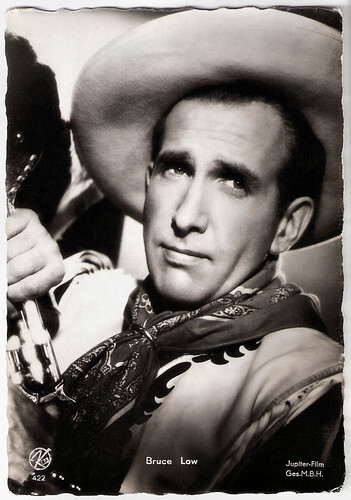
Austrian postcard by Kellner Postkarten, Wien (Vienna), no. 422. Photo: Jupiter-Film Ges.M.B.H. Bruce Low in Geld aus der Luft/Money from the air (Géza von Cziffra, 1954).
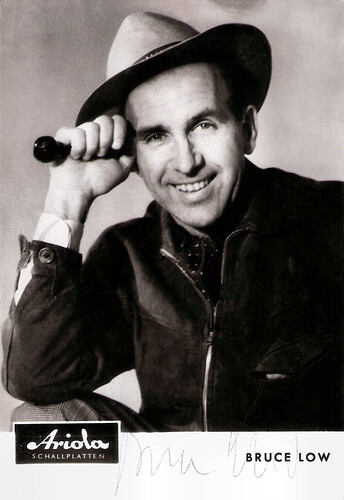
West-German promotion card by Ariola.
Blackface
Bruce Low was born Ernst Gottfried Bielke on a coffee plantation in Paramaribo, Surinam - then part of The Netherlands in 1913. He spent his childhood in Surinam together with his three sisters and brother. Their father, Hermann Moritz Bielke, worked as a missionary with the Herrnhuter Brüdergemeine. Their mother Lydia née Reusch was born in Hong Kong, her father came from Württemberg and was also a missionary.
From 1921, Bruce attended grammar school in Zeist, the Netherlands, played tenor saxophone in the school jazz band and was a member of the local church choir. After his final exams in 1932, he studied sports at the Deutsche Hochschule für Leibesübungen (DHfL - German University of Physical Education) in Berlin. But a serious injury while trampolining put an end to his studies as a sports teacher. Instead, he took singing lessons from the singing teacher Jacques Stückgold at the Hochschule für Musik (now Universität der Künste Berlin / Berlin University of the Arts). Low continued his studies in the Netherlands and also sang in a chamber choir.
His performing career only took shape after the war. He organised shows for the Americans in the Netherlands, contracted music groups, was an emcee and sang spiritual songs, also for the radio. As a result, he was hired in 1949 for a show with African folk songs in Vienna. He appeared in front of the audience dressed as a black man with blackface in the Al Johnson manner and received an offer for a recording contract. His first records contained Western-style cowboy songs, such as '(Ghost) Riders in the Sky' and 'Heimweh nach Virginia' (Homesick for Virginia).
In 1950, the man with the sonorous bass voice had his first success in Germany with the song 'Leise rauscht es am Missouri' (The Missouri River Rumbles Quietly). In 1953, more hits followed, such as 'So viel Wind und keine Sege' (So Much Wind and No Sail) and his legendary 'Tabak und Rum' (Tobacco and Rum). Two years later, 'Das alte Haus von Rocky Docky', the cover version of 'This Ole House' became a box office hit.
In 1956 he took third place in the newly created German Hit Parade with 'Wenn die Sonne scheint in Texas' (When the sun shines in Texas) and climbed to second place with 'Und es weht der Wind' (And the wind blows). His interpretation of the legendary hit 'Es hängt ein Pferdehalfter an der Wand', a cover version of Carson Robison's song 'There's a Bridle Hangin' on the Wall', with which the Dutch band Kilima Hawaiians had already caused a furore in Germany in 1953, became his greatest success.
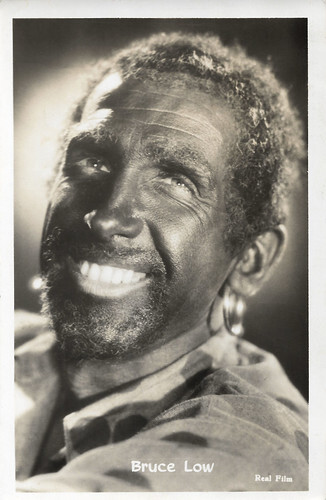
Vintage postcard. Photo: Real Film.
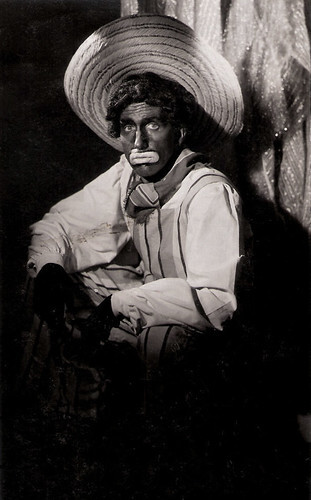
Dutch photo.
A wonderful one night at the airport film
In 1958 Bruce Low took part in the preliminaries for the Eurovision Song Contest in the Netherlands, with 'Neem Dat Maar Aan Van Mij' (Take That From Me) but came in 10th. Bruce Low also made several guest appearances as a singer in the popular German-language musical entertainment films of the 1950s and 1960s.
These films included Königin der Arena/Queen of the Arena (Rolf Meyer, 1952) with Maria Litto and Hans Söhnker , Wenn am Sonntagabend die Dorfmusik spielt/When The Village Music Plays on Sunday Nights (Rudolf Schündler, 1953) starring Rudolf Prack , and the operetta adaptation Blume von Hawaii/The Flower of Hawaii (Géza von Cziffra, 1953) starring Maria Litto .
He also performed his hit songs in several Schlager films. As an actor, he appeared in the successful drama Die endlose Nacht/The Endless Night (Will Tremper, 1963) a wonderful one-night-at-the-airport film with Karin Hübner and Harald Leipnitz.
He later also appeared in two other films by Tremper, the comedy Sperrbezirk/Sperrbezirk, the business of immorality (Will Tremper, 1966) with Harald Leipnitz and Mir hat es immer Spaß gemacht/How Did a Nice Girl Like You Get Into This Business? (Will Tremper, 1970) starring Playboy bunny Barbi Benton and Broderick Crawford .
After the stage musical 'Kiss me Kate' in the German translation by Marcel Prawy became an extraordinary success in the Wiener Volksoper, Prawy went to work on the Leonard Bernstein musical 'Wonderful Town' (1956), also in the Wiener Volksoper. Bruce Low played the lead role of Bob Baker as Olive Moorefield 's partner.
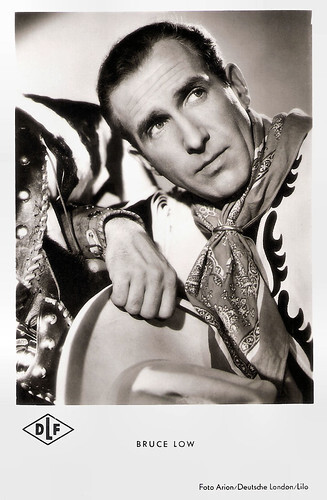
West-German postcard by Kunst und Bild, Berlin, no. A 1119. Photo: Arion / Deutsche London / Lilo. Bruce Low in Geld aus der Luft/Money from the air (Géza von Cziffra, 1954).
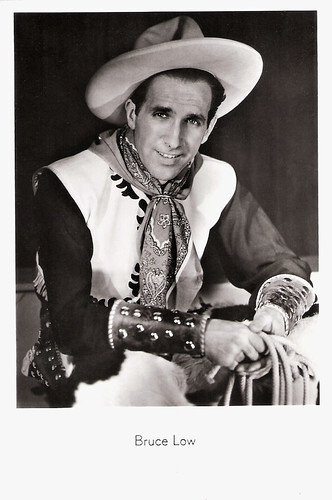
German postcard by F.J. Rüdel, Filmpostkartenverlag, Hamburg-Bergedorf, no. 537. Photo: Studio Lili Scholz / Polydor-Schallplatten.
Eurovision Song Contest
The advancing rock and roll wave seemed to end his career, so Bruce Low started writing articles for the Munich magazine Jasmin under the pseudonym Thomas Gallauner. At the Karl May Festival in Berlin he portrayed Old Shatterhand in 'Winnetou' (1966) and 'Der Schatz im Silbersee' (1968), alongside Gustavo Rojo as Winnetou.
At the beginning of the 1970s, his voice was in demand again and he performed mainly new, partly traditional gospels. With songs such as 'Noah' (1971), 'Das Kartenspiel' (1974) and 'Die Legende von Babylon' (1978), he hit the charts once more. He appeared as a guest in several television broadcasts and was asked as a presenter for circus broadcasts.
He also had several appearances in the ZDF quiz show Der große Preis. He returned to the cinemas in several films by Rainer Werner Fassbinder . First, he played in the TV two-parter Welt am Draht/World on a Wire (Rainer Werner Fassbinder, 1973) and later in the films Faustrecht der Freiheit/Fox and His Friends (Rainer Werner Fassbinder, 1975) and Die Ehe der Maria Braun/The Wedding of Maria Braun (Rainer Werner Fassbinder, 1979) starring Hanna Schygulla .
In 1976 he participated again in the preliminaries of the Eurovision Song Contest, now in West Germany, with the song 'Der Jahrmarkt unserer Eitelkeit' (The Fair of Our Vanity). However, he only reached 9th place among twelve participants and the Les Humphries Singers participated for Germany with 'Sing Sang Song' and reached 12th place. In the 1980s it became quieter again around the singer.
Two years before his death, he published his memoirs under the title 'Es hängt ein Pferdehalfter an der Wand - das Lied meines Lebens' (There is a horse halter hanging on the wall - the song of my life). In 1990, Bruce Lowe died after a long illness at the age of 76 in a Munich hospital. At his own request, the artist, who was married to his wife Marion, had his body cremated and scattered in a meadow in the Netherlands.
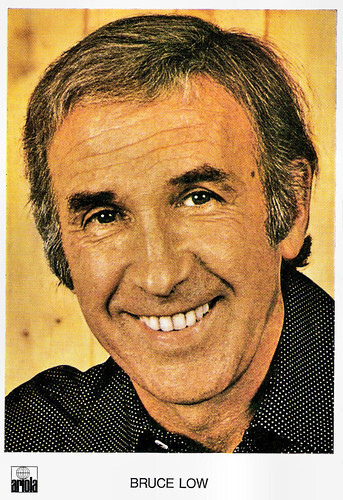
West-German postcard by top-Schlagertextheft. Photo: Ariola.
Sources: Stephanie D'Heil (Steffi-Line - German), Wikipedia (Dutch and German), and .

Austrian postcard by Kellner Postkarten, Wien (Vienna), no. 422. Photo: Jupiter-Film Ges.M.B.H. Bruce Low in Geld aus der Luft/Money from the air (Géza von Cziffra, 1954).

West-German promotion card by Ariola.
Blackface
Bruce Low was born Ernst Gottfried Bielke on a coffee plantation in Paramaribo, Surinam - then part of The Netherlands in 1913. He spent his childhood in Surinam together with his three sisters and brother. Their father, Hermann Moritz Bielke, worked as a missionary with the Herrnhuter Brüdergemeine. Their mother Lydia née Reusch was born in Hong Kong, her father came from Württemberg and was also a missionary.
From 1921, Bruce attended grammar school in Zeist, the Netherlands, played tenor saxophone in the school jazz band and was a member of the local church choir. After his final exams in 1932, he studied sports at the Deutsche Hochschule für Leibesübungen (DHfL - German University of Physical Education) in Berlin. But a serious injury while trampolining put an end to his studies as a sports teacher. Instead, he took singing lessons from the singing teacher Jacques Stückgold at the Hochschule für Musik (now Universität der Künste Berlin / Berlin University of the Arts). Low continued his studies in the Netherlands and also sang in a chamber choir.
His performing career only took shape after the war. He organised shows for the Americans in the Netherlands, contracted music groups, was an emcee and sang spiritual songs, also for the radio. As a result, he was hired in 1949 for a show with African folk songs in Vienna. He appeared in front of the audience dressed as a black man with blackface in the Al Johnson manner and received an offer for a recording contract. His first records contained Western-style cowboy songs, such as '(Ghost) Riders in the Sky' and 'Heimweh nach Virginia' (Homesick for Virginia).
In 1950, the man with the sonorous bass voice had his first success in Germany with the song 'Leise rauscht es am Missouri' (The Missouri River Rumbles Quietly). In 1953, more hits followed, such as 'So viel Wind und keine Sege' (So Much Wind and No Sail) and his legendary 'Tabak und Rum' (Tobacco and Rum). Two years later, 'Das alte Haus von Rocky Docky', the cover version of 'This Ole House' became a box office hit.
In 1956 he took third place in the newly created German Hit Parade with 'Wenn die Sonne scheint in Texas' (When the sun shines in Texas) and climbed to second place with 'Und es weht der Wind' (And the wind blows). His interpretation of the legendary hit 'Es hängt ein Pferdehalfter an der Wand', a cover version of Carson Robison's song 'There's a Bridle Hangin' on the Wall', with which the Dutch band Kilima Hawaiians had already caused a furore in Germany in 1953, became his greatest success.

Vintage postcard. Photo: Real Film.

Dutch photo.
A wonderful one night at the airport film
In 1958 Bruce Low took part in the preliminaries for the Eurovision Song Contest in the Netherlands, with 'Neem Dat Maar Aan Van Mij' (Take That From Me) but came in 10th. Bruce Low also made several guest appearances as a singer in the popular German-language musical entertainment films of the 1950s and 1960s.
These films included Königin der Arena/Queen of the Arena (Rolf Meyer, 1952) with Maria Litto and Hans Söhnker , Wenn am Sonntagabend die Dorfmusik spielt/When The Village Music Plays on Sunday Nights (Rudolf Schündler, 1953) starring Rudolf Prack , and the operetta adaptation Blume von Hawaii/The Flower of Hawaii (Géza von Cziffra, 1953) starring Maria Litto .
He also performed his hit songs in several Schlager films. As an actor, he appeared in the successful drama Die endlose Nacht/The Endless Night (Will Tremper, 1963) a wonderful one-night-at-the-airport film with Karin Hübner and Harald Leipnitz.
He later also appeared in two other films by Tremper, the comedy Sperrbezirk/Sperrbezirk, the business of immorality (Will Tremper, 1966) with Harald Leipnitz and Mir hat es immer Spaß gemacht/How Did a Nice Girl Like You Get Into This Business? (Will Tremper, 1970) starring Playboy bunny Barbi Benton and Broderick Crawford .
After the stage musical 'Kiss me Kate' in the German translation by Marcel Prawy became an extraordinary success in the Wiener Volksoper, Prawy went to work on the Leonard Bernstein musical 'Wonderful Town' (1956), also in the Wiener Volksoper. Bruce Low played the lead role of Bob Baker as Olive Moorefield 's partner.

West-German postcard by Kunst und Bild, Berlin, no. A 1119. Photo: Arion / Deutsche London / Lilo. Bruce Low in Geld aus der Luft/Money from the air (Géza von Cziffra, 1954).

German postcard by F.J. Rüdel, Filmpostkartenverlag, Hamburg-Bergedorf, no. 537. Photo: Studio Lili Scholz / Polydor-Schallplatten.
Eurovision Song Contest
The advancing rock and roll wave seemed to end his career, so Bruce Low started writing articles for the Munich magazine Jasmin under the pseudonym Thomas Gallauner. At the Karl May Festival in Berlin he portrayed Old Shatterhand in 'Winnetou' (1966) and 'Der Schatz im Silbersee' (1968), alongside Gustavo Rojo as Winnetou.
At the beginning of the 1970s, his voice was in demand again and he performed mainly new, partly traditional gospels. With songs such as 'Noah' (1971), 'Das Kartenspiel' (1974) and 'Die Legende von Babylon' (1978), he hit the charts once more. He appeared as a guest in several television broadcasts and was asked as a presenter for circus broadcasts.
He also had several appearances in the ZDF quiz show Der große Preis. He returned to the cinemas in several films by Rainer Werner Fassbinder . First, he played in the TV two-parter Welt am Draht/World on a Wire (Rainer Werner Fassbinder, 1973) and later in the films Faustrecht der Freiheit/Fox and His Friends (Rainer Werner Fassbinder, 1975) and Die Ehe der Maria Braun/The Wedding of Maria Braun (Rainer Werner Fassbinder, 1979) starring Hanna Schygulla .
In 1976 he participated again in the preliminaries of the Eurovision Song Contest, now in West Germany, with the song 'Der Jahrmarkt unserer Eitelkeit' (The Fair of Our Vanity). However, he only reached 9th place among twelve participants and the Les Humphries Singers participated for Germany with 'Sing Sang Song' and reached 12th place. In the 1980s it became quieter again around the singer.
Two years before his death, he published his memoirs under the title 'Es hängt ein Pferdehalfter an der Wand - das Lied meines Lebens' (There is a horse halter hanging on the wall - the song of my life). In 1990, Bruce Lowe died after a long illness at the age of 76 in a Munich hospital. At his own request, the artist, who was married to his wife Marion, had his body cremated and scattered in a meadow in the Netherlands.

West-German postcard by top-Schlagertextheft. Photo: Ariola.
Sources: Stephanie D'Heil (Steffi-Line - German), Wikipedia (Dutch and German), and .
Published on August 23, 2022 22:00
August 22, 2022
Sári Fedák
Hungarian actress and singer Sári Fedák (1879-1955) was one of the most famous prima donnas of her time. The temperamental operetta and film star was mixed up in several scandals.

Hungarian postcard. no. 5668. Ca. 1903-1908. Photo: [Lipot Strelisky]. Sári Fedák as the title character in the operetta 'Bob herceg' (Prince Bob/ Duke Bob, 1902) by Jenő Huszka. The premiere took place on December 20, 1902 at the Népszínház in Budapest. The libretto was written by Ferenc Martos and Károly Bakonyi. It was the author's first operetta and he was successful both at home and abroad. He thus opened the way to fame for other Hungarian authors (especially Viktor Jacobi and Emmerich Kálmán). The operetta was filmed in 1941 (director: László Kalmár). The play by Huszka was extremely popular, especially because of Fedak's performance. By February 1903 she had already done 50 performances with the play at the Népszínház theatre.
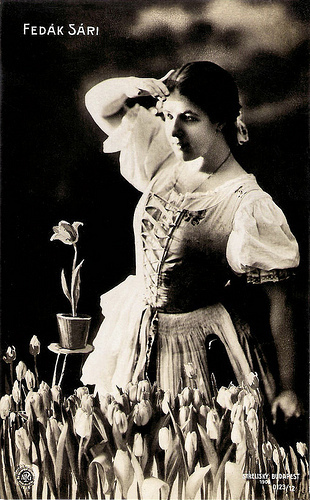
Hungarian postcard by NPG, no. 0123/12,1906. Photo: Strelisky, Budapest.
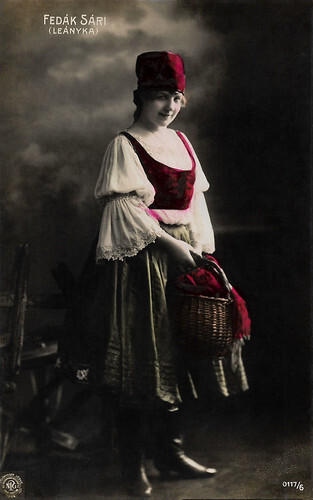
Hungarian postcard by NPG, no. 0117/6, 1906. Sári Fedák in the stage operetta 'Leányka' at the Népszínház (People's Theatre), Budapest.
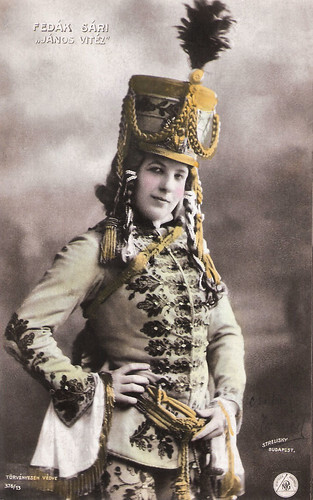
Hungarian postcard by Törvényesen Védve, no. Budapest, no. 376/13. Photo: Strelisky, Budapest. Sári Fédak in the stage play 'Janos Vitéz'. 'Janos Vitéz' (John the Valiant) was a musical play by Pongrác Kacsóh in three acts. The premiere of 'Janos Vitéz' took place on 18 November 1904. The overwhelming success of the play surprised even its creators. The audience cheered and laughed, and during Bagó's movingly beautiful song, even tears were shed here and there. When the song was over, the audience demanded a reprise, but it took a while, because Mihály Papp, who played Bagó, had tears streaming down his face, the conductor József Konti was searching for his handkerchief, and even the composer Pongrác Kacsóh's eyes were watering. Sári Fedák recalled the premiere of the piece as her greatest success to date, in which the audience played a huge part.
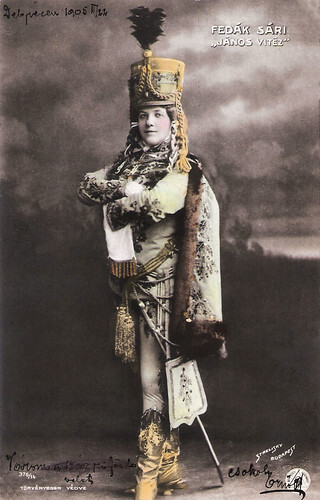
Hungarian postcard by Törvényesen Védve, Budapest, no. 376/14. Photo: Strelisky, Budapest. Sári Fédak in the stage play 'Janos Vitéz'. Sent by mail in 1905.
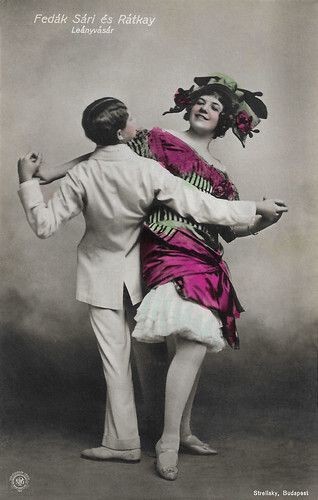
Hungarian postcard by NPG. Photo: Strelisky, Budapest. Sári Fedák and Márton Rátkai in the stage operetta 'Leányvásár' (Girls for sale) which premiered in 1911 at the Király Színház (Royal Theatre in Budapest.
Angry crowds stormed her house
Sári Fedák or Fédak Sári was born in Beregszász, Hungary (now Berehove, Ukraine) in 1879.
She studied acting with Szidi Rákosi until 1899 and began her career the same year with the Magyar Színház theatre company. From 1900, she played in Pozsony (now Bratislava), and in several theatres in Budapest.
In 1907, she was mixed up in a scandal after the suicide of the famous playwright Paul Widor. According to an article in The Los Angeles Herald, angry crowds stormed her house and threatened her with death if she fell into their hands. Fedák was the well-paid star in a disastrous stage production of Widor, which ruined him and caused his suicide.
Sári left Hungary and conquered Berlin in 1908, Vienna in 1909, and London and Paris in 1910. When she returned to Budapest the public welcomed her back.
In 1912, she made her film debut in the short comedy Gazdag ember kabátja/Rich man’s coat (Andor K. Kovács, 1912) based on a story by the famous Hungarian playwright and novelist Ferenc Molnár. The following year, she co-starred with Alfréd Deésy in Rablélek (1913), directed by Mihály Kertész who later became the famous Hollywood director Michael Curtiz.
In Márta (Ödön Uher ifj., 1913), she co-starred with Várkonyi Mihály, who became internationally known as Victor Varconi . Another silent film was Három hét/Three Weeks (Márton Garas, 1917), based on a novel by Elinor Glyn.
Following World War I, she spoke out against the Austro-Hungarian monarchy. In 1919, during the short run of the Hungarian Soviet Republic, she agitated for joining the Red Army. After the fall of the Republic, Fedák fled to Vienna but was captured and held in prison at Wiener Neustadt for a short time.
As a supporter of the Republic, she could only play in Vienna from 1920-1921. She made appearances in Berlin and Paris in 1921 and 1925. In 1923, she became a member of the Fővárosi Operettszínház theatre.
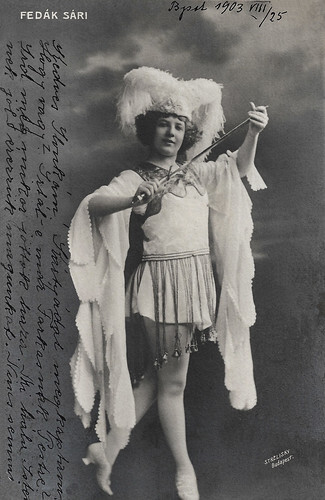
Hungarian postcard. Photo: Strelisky, Budapest. Sent by mail in 1903.
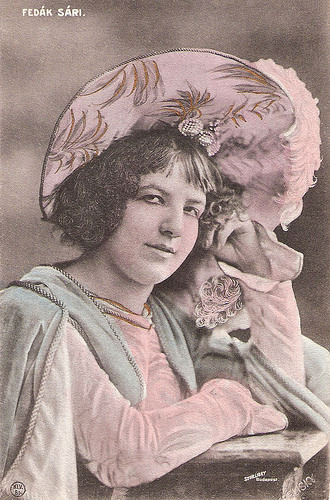
Hungarian postcard by KIV, Budapest. Photo: Strelisky, Budapest.
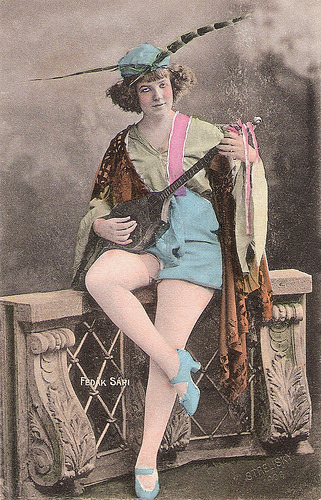
Hungarian postcard by S.J., Budapest. Photo: Strelisky, Budapest.
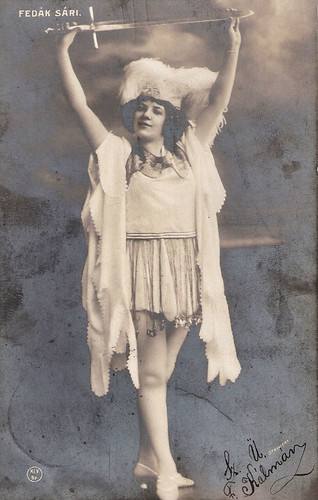
Hungarian postcard by KIV, Budapest. Photo: Strelisky, Budapest.
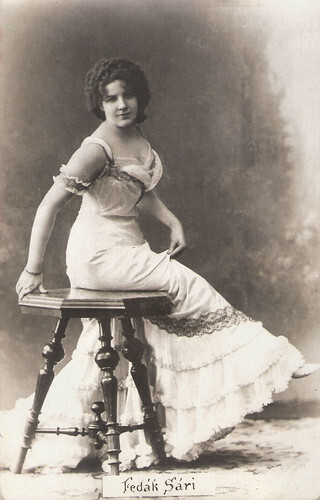
Hungarian postcard.
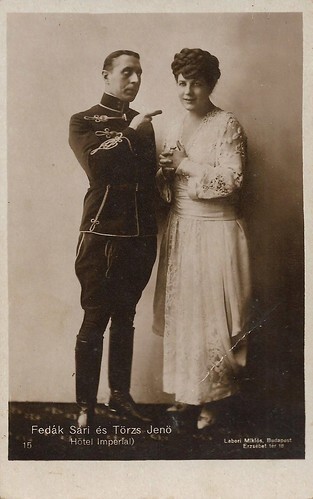
Hungarian postcard. Photo: Miklos Labori, Budapest. Sári Fedák and Jenö Törzs in the play 'Hotel Imperial' (1917), written by Lajos Bíró, at the Magyar Shinhaz (Hungarian Theatre).
Intimate relationships with 42 gentlemen
In 1922 Sári Fedák married Ferenc Molnár, after a six-year relationship. The couple divorced in 1925 or 1926 after he reportedly had accused her of intimate relationships with 42 gentlemen, and she had replied in kind with a list of 142 ladies who were said to have received his favours.
In 1927 there was another scandal when Fedák was sued by rival actress Vilma Banky . Fedák would have called her ‘that little lowdown Budapest cat’. Time magazine published a report of the trial including a description of Fedák’s entrance in the courtroom “clad in a black gown tight as a snake skin, looking perhaps half her 43 years”. The court dismissed the case.
After the introduction of sound film, she made her come-back in the cinema with Iza néni/Miss Iza (Székely István a.k.a. Steve Sekely, 1933) opposite Pál Jávor . In 1934, she toured several American cities. She used her American experiences for the script of Mámi (Vaszari János a.k.a. Johann von Vásáry, 1937) in which she played the title figure, a Hungarian woman returning from Texas.
The success lead to other films like Az örök titok/The Eternal Secret (István György, 1938), Érik a búzakalász/The Wheat Ripens (Béla Gaál, 1939) and Bob herceg/Prince Bob (László Kalmár, 1941).
Starting in 1940, she was the leading actress in the Új Magyar Színház theatre. In 1944, working at the Donausender radio station in Vienna, she rallied Hungary to continue the fight in World War II on the side of Nazi Germany. For this act, she was sentenced to eight months in prison after the war, and she was banned from playing in theatres for three years. The court order broke her career: she never appeared on stage again.
After being released from prison, she moved to Nyáregyháza, retiring from active life. Sári Fedák died in 1955 in Budapest, Hungary, aged 75, and was interred in Budapest's Farkasréti Cemetery.
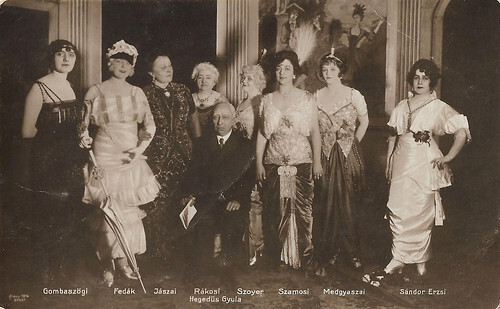
Hungarian postcard. Photo: Alexy, Budapest, 1914. Left to right: Frida Gombaszögi , Sári Fedák, Mari Jászai, [Szidi] Rákosi, Gyula Hegedüs, Ilona Szoyer, [Elza] Szamosi, Vilma Medgyaszai, and Erzsi Sándor.
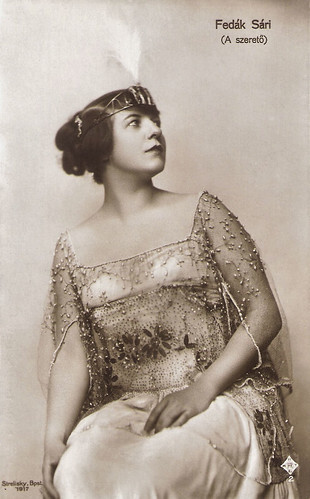
Hungarian postcard by MRT, Budapest, no. 2. Photo: Strelisky, Budapest, 1917. Sári Fédak in A szeretö/The lover (Márton Garas, 1918).
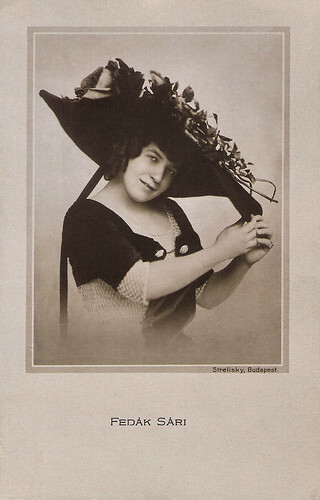
Hungarian postcard by Kiadja Reinitz Jòzsef, Budapest. Photo: Strelisky, Budapest.
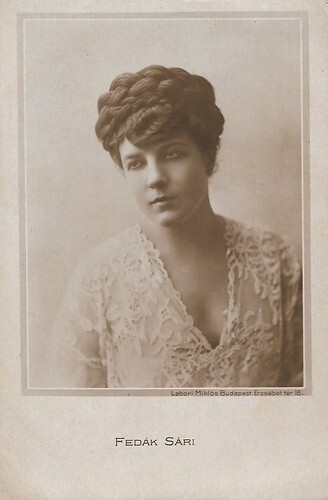
Hungarian postcard. Photo: Miklós Labori, Budapest.
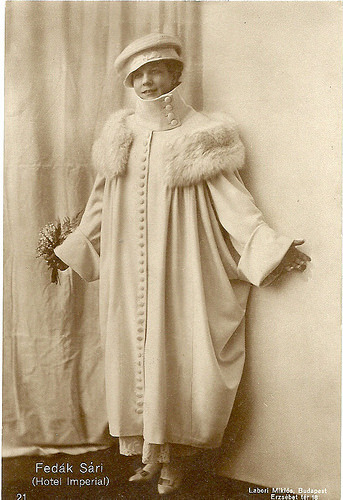
Hungarian postcard, no. 21. Photo: Miklós Labori, Budapest. Collection: Didier Hanson.
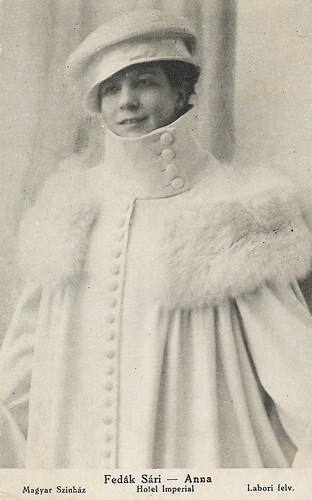
Vintage Hungarian postcard. Photo by Miklós Labori, Budapest. Sári Fedák as Anna in the play 'Hotel Imperial' (1917), written by Lajos Bíró, at the Magyar Shinhaz (Hungarian Theatre).
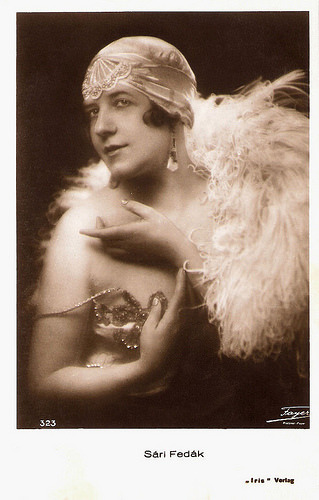
Austrian postcard by Iris Verlag, no. 323. Photo: Fayer.
Sources: Los Angeles Herald, Magyar Színházmüveszeti Lexikon (Hungarian), Wikipedia and .

Hungarian postcard. no. 5668. Ca. 1903-1908. Photo: [Lipot Strelisky]. Sári Fedák as the title character in the operetta 'Bob herceg' (Prince Bob/ Duke Bob, 1902) by Jenő Huszka. The premiere took place on December 20, 1902 at the Népszínház in Budapest. The libretto was written by Ferenc Martos and Károly Bakonyi. It was the author's first operetta and he was successful both at home and abroad. He thus opened the way to fame for other Hungarian authors (especially Viktor Jacobi and Emmerich Kálmán). The operetta was filmed in 1941 (director: László Kalmár). The play by Huszka was extremely popular, especially because of Fedak's performance. By February 1903 she had already done 50 performances with the play at the Népszínház theatre.

Hungarian postcard by NPG, no. 0123/12,1906. Photo: Strelisky, Budapest.

Hungarian postcard by NPG, no. 0117/6, 1906. Sári Fedák in the stage operetta 'Leányka' at the Népszínház (People's Theatre), Budapest.

Hungarian postcard by Törvényesen Védve, no. Budapest, no. 376/13. Photo: Strelisky, Budapest. Sári Fédak in the stage play 'Janos Vitéz'. 'Janos Vitéz' (John the Valiant) was a musical play by Pongrác Kacsóh in three acts. The premiere of 'Janos Vitéz' took place on 18 November 1904. The overwhelming success of the play surprised even its creators. The audience cheered and laughed, and during Bagó's movingly beautiful song, even tears were shed here and there. When the song was over, the audience demanded a reprise, but it took a while, because Mihály Papp, who played Bagó, had tears streaming down his face, the conductor József Konti was searching for his handkerchief, and even the composer Pongrác Kacsóh's eyes were watering. Sári Fedák recalled the premiere of the piece as her greatest success to date, in which the audience played a huge part.

Hungarian postcard by Törvényesen Védve, Budapest, no. 376/14. Photo: Strelisky, Budapest. Sári Fédak in the stage play 'Janos Vitéz'. Sent by mail in 1905.

Hungarian postcard by NPG. Photo: Strelisky, Budapest. Sári Fedák and Márton Rátkai in the stage operetta 'Leányvásár' (Girls for sale) which premiered in 1911 at the Király Színház (Royal Theatre in Budapest.
Angry crowds stormed her house
Sári Fedák or Fédak Sári was born in Beregszász, Hungary (now Berehove, Ukraine) in 1879.
She studied acting with Szidi Rákosi until 1899 and began her career the same year with the Magyar Színház theatre company. From 1900, she played in Pozsony (now Bratislava), and in several theatres in Budapest.
In 1907, she was mixed up in a scandal after the suicide of the famous playwright Paul Widor. According to an article in The Los Angeles Herald, angry crowds stormed her house and threatened her with death if she fell into their hands. Fedák was the well-paid star in a disastrous stage production of Widor, which ruined him and caused his suicide.
Sári left Hungary and conquered Berlin in 1908, Vienna in 1909, and London and Paris in 1910. When she returned to Budapest the public welcomed her back.
In 1912, she made her film debut in the short comedy Gazdag ember kabátja/Rich man’s coat (Andor K. Kovács, 1912) based on a story by the famous Hungarian playwright and novelist Ferenc Molnár. The following year, she co-starred with Alfréd Deésy in Rablélek (1913), directed by Mihály Kertész who later became the famous Hollywood director Michael Curtiz.
In Márta (Ödön Uher ifj., 1913), she co-starred with Várkonyi Mihály, who became internationally known as Victor Varconi . Another silent film was Három hét/Three Weeks (Márton Garas, 1917), based on a novel by Elinor Glyn.
Following World War I, she spoke out against the Austro-Hungarian monarchy. In 1919, during the short run of the Hungarian Soviet Republic, she agitated for joining the Red Army. After the fall of the Republic, Fedák fled to Vienna but was captured and held in prison at Wiener Neustadt for a short time.
As a supporter of the Republic, she could only play in Vienna from 1920-1921. She made appearances in Berlin and Paris in 1921 and 1925. In 1923, she became a member of the Fővárosi Operettszínház theatre.

Hungarian postcard. Photo: Strelisky, Budapest. Sent by mail in 1903.

Hungarian postcard by KIV, Budapest. Photo: Strelisky, Budapest.

Hungarian postcard by S.J., Budapest. Photo: Strelisky, Budapest.

Hungarian postcard by KIV, Budapest. Photo: Strelisky, Budapest.

Hungarian postcard.

Hungarian postcard. Photo: Miklos Labori, Budapest. Sári Fedák and Jenö Törzs in the play 'Hotel Imperial' (1917), written by Lajos Bíró, at the Magyar Shinhaz (Hungarian Theatre).
Intimate relationships with 42 gentlemen
In 1922 Sári Fedák married Ferenc Molnár, after a six-year relationship. The couple divorced in 1925 or 1926 after he reportedly had accused her of intimate relationships with 42 gentlemen, and she had replied in kind with a list of 142 ladies who were said to have received his favours.
In 1927 there was another scandal when Fedák was sued by rival actress Vilma Banky . Fedák would have called her ‘that little lowdown Budapest cat’. Time magazine published a report of the trial including a description of Fedák’s entrance in the courtroom “clad in a black gown tight as a snake skin, looking perhaps half her 43 years”. The court dismissed the case.
After the introduction of sound film, she made her come-back in the cinema with Iza néni/Miss Iza (Székely István a.k.a. Steve Sekely, 1933) opposite Pál Jávor . In 1934, she toured several American cities. She used her American experiences for the script of Mámi (Vaszari János a.k.a. Johann von Vásáry, 1937) in which she played the title figure, a Hungarian woman returning from Texas.
The success lead to other films like Az örök titok/The Eternal Secret (István György, 1938), Érik a búzakalász/The Wheat Ripens (Béla Gaál, 1939) and Bob herceg/Prince Bob (László Kalmár, 1941).
Starting in 1940, she was the leading actress in the Új Magyar Színház theatre. In 1944, working at the Donausender radio station in Vienna, she rallied Hungary to continue the fight in World War II on the side of Nazi Germany. For this act, she was sentenced to eight months in prison after the war, and she was banned from playing in theatres for three years. The court order broke her career: she never appeared on stage again.
After being released from prison, she moved to Nyáregyháza, retiring from active life. Sári Fedák died in 1955 in Budapest, Hungary, aged 75, and was interred in Budapest's Farkasréti Cemetery.

Hungarian postcard. Photo: Alexy, Budapest, 1914. Left to right: Frida Gombaszögi , Sári Fedák, Mari Jászai, [Szidi] Rákosi, Gyula Hegedüs, Ilona Szoyer, [Elza] Szamosi, Vilma Medgyaszai, and Erzsi Sándor.

Hungarian postcard by MRT, Budapest, no. 2. Photo: Strelisky, Budapest, 1917. Sári Fédak in A szeretö/The lover (Márton Garas, 1918).

Hungarian postcard by Kiadja Reinitz Jòzsef, Budapest. Photo: Strelisky, Budapest.

Hungarian postcard. Photo: Miklós Labori, Budapest.

Hungarian postcard, no. 21. Photo: Miklós Labori, Budapest. Collection: Didier Hanson.

Vintage Hungarian postcard. Photo by Miklós Labori, Budapest. Sári Fedák as Anna in the play 'Hotel Imperial' (1917), written by Lajos Bíró, at the Magyar Shinhaz (Hungarian Theatre).

Austrian postcard by Iris Verlag, no. 323. Photo: Fayer.
Sources: Los Angeles Herald, Magyar Színházmüveszeti Lexikon (Hungarian), Wikipedia and .
Published on August 22, 2022 22:00
August 21, 2022
André van Duin
Funny-looking, reddish André van Duin (1947) is a famous comedian and actor in Dutch-speaking countries. He is also a singer, writer, and creator of many popular television programs, and he starred in three Dutch film comedies.
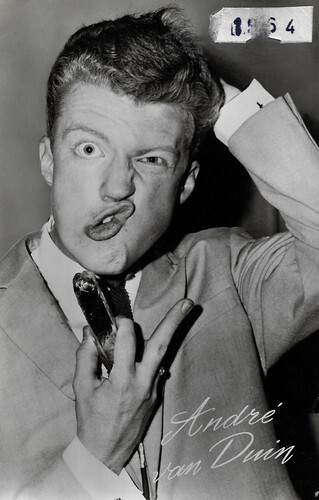
Dutch postcard by Uitgeverij Takken, Utrecht, no. AX 5985, 1964.
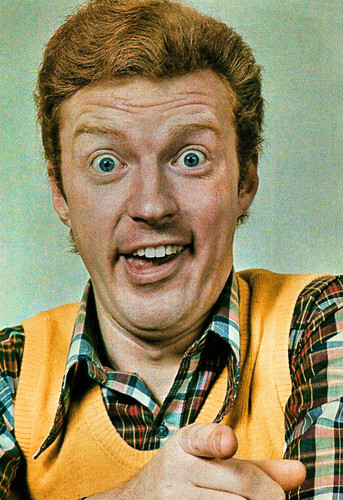
Dutch promotion card by CNR, Leiden. Photo: Weekblad Weekend.

Dutch promotion card by CNR, Weesp.
The talent of amusing people
André van Duin was born in Rotterdam, The Netherlands in 1947. His birth name was Adrianus Marinus Kloot, which he legally changed to Adrianus Marinus Kyvon in 1966, a few years after taking the pseudonym, André van Duin. Van Duin grew up in Rotterdam, was interested in performing at a young age and developed an image as the class clown, partially due to his red hair.
He developed the talent of amusing people, imitating celebrities and singing. At the age of 15, he sent letters to several TV networks, requesting an audition. In 1964 he was discovered when he won the TV talent contest show Nieuwe Oogst (New Harvest) and started appearing as a guest in a few shows, including that of singing father and daughter Willy Alberti and Willeke Alberti.
In 1965 he got the opportunity to do a television programme of his own, Een avondje teevee met André/A TV evening with André. Together with director Guus Verstraete, Van Duin created five episodes of the show which received a good critical response. From 1967 onwards, he took an apprenticeship at comedians Willy Walden and Piet Muyselaar 's Snip & Snap theatre shows.
After the good response to his first television show, theatre producer Joop van den Ende cast Van Duin for a revue production, 'n Lach in de ruimte/A laugh in space (1970). Initially, Van Duin would play the straight man to Frans van Dusschoten, but during the try-outs, Van den Ende decided that Van Duin was better suited to play the role of the everyman.
Their stage revue, 'Dag dag heerlijke lach/Hello hello delicious laugh' (1973-1974) with Corrie van Gorp became a great success in the theatres. The show was televised from 1974-1975 and in 1975 Van Duin won the Gouden Televizier-ring, a major Dutch TV award, for Dag dag heerlijke lach/Hello hello delicious laugh. During this decade Van Duin also recorded several hit songs such as 'Het bananenlied' (1972), a parody of The Banana Boat Song.
In 1972, André van Duin began the radio show Dik Voormekaar Show. First with broadcasting company Radio Noordzee Internationaal, later with the NCRV and TROS. He involved his then technician, Ferry de Groot, in the show, becoming the character Meneer de Groot (Mister de Groot). The show continued to air on the radio (and for a period also on TV) as recently as 2009.
André van Duin debuted as an actor in the TV series Het meisje met de blauwe hoed/The Girl With The Blue Hat (Dick van 't Sant, 1972), playing an army recruit opposite Jenny Arean. It was a TV version of the film musical Het meisje met den blauwe hoed/The Girl With The Blue Hat (Rudolf Meinert, 1934), with Truus van Aalten and Lou Bandy in the Van Duin part.
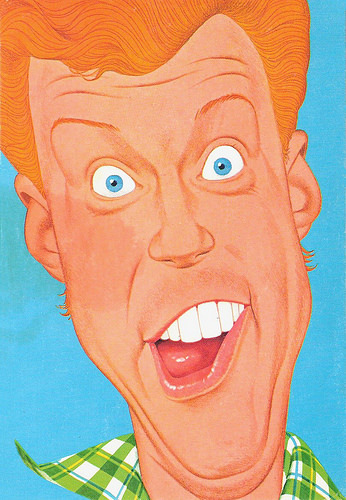
Dutch postcard by Postcheque en Girodienst, 's-Gravenhage. Illustration: n.n.
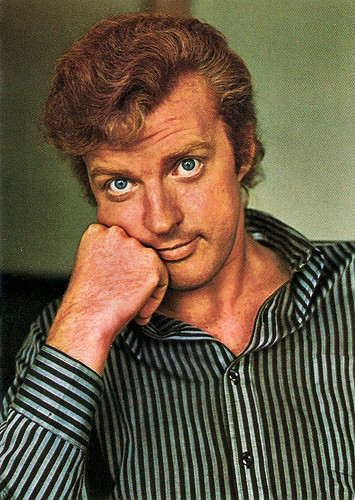
Dutch postcard by Nederlands Artisten Management, Rotterdam.
Both serious and wacky
André van Duin made his film debut with Pretfilm/Fun Film (Robert Kaesen, 1976) in which he played various characters with his cronies from his stage and TV comedies, Frans van Dusschoten and Corrie van Gorp. In 1981 he starred with the same team in another comedy, Ik Ben Joep Meloen/I am Joep Melon (Guus Verstraete, 1981), which was another reasonable success.
In 1982 followed his most ambitious film, De Boezemvriend/The Bosom Buddy (Dimitri Frenkel Frank, 1982), partly an adaptation of the Danny Kaye film The Inspector General (Henry Koster, 1949). Van Duin portrayed charlatan dentist Fred van der Zee who is mistaken for Napoleon's delegate. De Boezemvriend was considered a failure and Van Duin hasn't returned to the big screen since.
In 1976, Van Duin had a massive hit with the song 'Willempie'. Parents of mentally challenged children considered his performance offensive. Van Duin escaped legal action by apologising on television. Later that year, Van Duin released 'And're Andre' (The Other Andre), an album stripped of wackiness that became the first of five volumes.
During the 1980s Van Duin stayed unchangingly popular as a comedian in the Netherlands. In the mid-1980s he became especially known for several of his alter egos, which he sometimes performed alongside Corrie van Gorp. In 1981, he presented the Flip Fluitketel Show as his alter ego Flip Fluitketel, which at its peak attracted an estimated 5.8 million viewers in the Netherlands.
Cartoonist Toon van Driel created André's own comic book series in 1987. Very popular was the WWF-promoting TV series Animal Crackers (1988). Van Duin and his new stable-mate Ron Brandsteder were team-captains in the TV show Wie ben ik?/Who am I? (1989), hosted by Caroline Tensen.
Between 1993 and 1999 Van Duin made television shows for RTL. In 2007 'André's Nieuwe Revue-tour' was launched. Belgium was visited in November 2008 for five shows in Antwerp. In 2009 he made a new series of Dik Voormekaar Shows. In 2010, Van Duin released the cd 'Dubbel' (Double), made up of both serious and wacky songs.
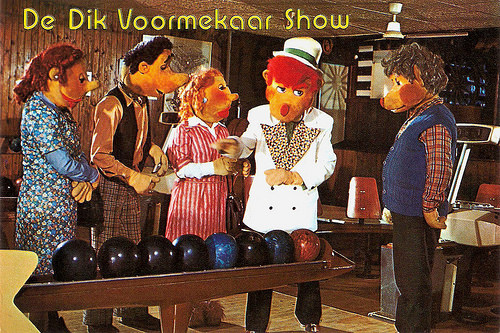
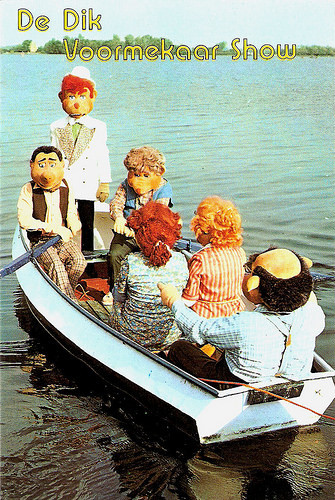
Dutch postcards by Gebr. Spanjersberg, Rotterdam / Antwerpen, 1979. Photos: NAM / Direct Promotion. Publicity stills for the TV series De Dik Voormekaar Show (Guus Verstraete, 1977-1979). A TV version of the popular radio program with André van Duin and Ferry de Groot in which the various characters were portrayed on screen by hand puppets in the first season (1977-1978) and full body costumes in the second (1978-1979).
The Great Dutch Bake Off
During his career, André van Duin had 41 singles in the Dutch Top 40, 22 of those reached the Top 10 of which 3 singles became number one. André van Duin was in a relationship with Wim van der Pluym from 1974 until 1995 when Van der Pluym died. Van Duin married Martin Elferink in 2006.
In 2013, he returned to TV as Petrus in the hit series 't Schaep met de 5 pooten/The Sheep with five legs (Frank Krom, a.o., 2007-2015). On stage, he impressed critics with his role in The Sunshine Boys (2015).
In 2016, he took over the presentation of the very popular TV show Heel Holland Bakt/Holland bakes from Martine Bijl, after her brain haemorrhage in 2015. The show is the Dutch version of The Great British Bake Off.
In 2017 and 2019, Van Duin played in the TV series Het geheime dagboek van Hendrik Groen/The Secret Diary of Hendrik Groen, 83 ¼ Years Old (Tim Oliehoek, 2017-2019). In this drama series, he starred alongside Kees Hulst and Olga Zuiderhoek.
He also appeared on television with the programme Denkend aan Holland (2019-2022). Together with Janny van der Heijden, with whom Van Duin had already worked in the television programme Heel Holland Bakt, he explored parts of the Netherlands, especially from the water.
In 2020, his husband, Martin Elferink died at the age of 55 from the effects of bone cancer. Van Duin himself was found to have colon cancer in the summer of 2020. He underwent surgery for this in January 2021. In February 2022, Van Duin announced his new relationship with Fernando Reyes.
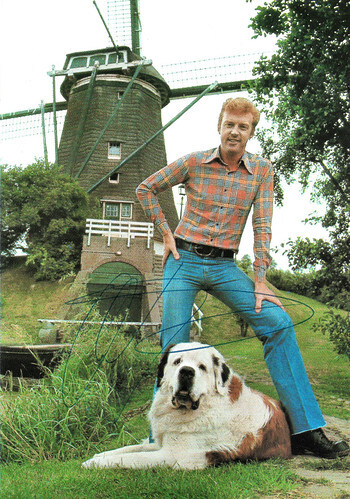
Dutch promotion card by CNR, Weesp. Photo: Hans Hofman.
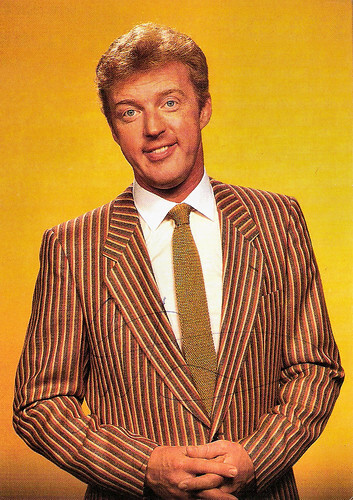
Dutch promotion card by CNR, Weesp.
Sources: Wikipedia and .

Dutch postcard by Uitgeverij Takken, Utrecht, no. AX 5985, 1964.

Dutch promotion card by CNR, Leiden. Photo: Weekblad Weekend.

Dutch promotion card by CNR, Weesp.
The talent of amusing people
André van Duin was born in Rotterdam, The Netherlands in 1947. His birth name was Adrianus Marinus Kloot, which he legally changed to Adrianus Marinus Kyvon in 1966, a few years after taking the pseudonym, André van Duin. Van Duin grew up in Rotterdam, was interested in performing at a young age and developed an image as the class clown, partially due to his red hair.
He developed the talent of amusing people, imitating celebrities and singing. At the age of 15, he sent letters to several TV networks, requesting an audition. In 1964 he was discovered when he won the TV talent contest show Nieuwe Oogst (New Harvest) and started appearing as a guest in a few shows, including that of singing father and daughter Willy Alberti and Willeke Alberti.
In 1965 he got the opportunity to do a television programme of his own, Een avondje teevee met André/A TV evening with André. Together with director Guus Verstraete, Van Duin created five episodes of the show which received a good critical response. From 1967 onwards, he took an apprenticeship at comedians Willy Walden and Piet Muyselaar 's Snip & Snap theatre shows.
After the good response to his first television show, theatre producer Joop van den Ende cast Van Duin for a revue production, 'n Lach in de ruimte/A laugh in space (1970). Initially, Van Duin would play the straight man to Frans van Dusschoten, but during the try-outs, Van den Ende decided that Van Duin was better suited to play the role of the everyman.
Their stage revue, 'Dag dag heerlijke lach/Hello hello delicious laugh' (1973-1974) with Corrie van Gorp became a great success in the theatres. The show was televised from 1974-1975 and in 1975 Van Duin won the Gouden Televizier-ring, a major Dutch TV award, for Dag dag heerlijke lach/Hello hello delicious laugh. During this decade Van Duin also recorded several hit songs such as 'Het bananenlied' (1972), a parody of The Banana Boat Song.
In 1972, André van Duin began the radio show Dik Voormekaar Show. First with broadcasting company Radio Noordzee Internationaal, later with the NCRV and TROS. He involved his then technician, Ferry de Groot, in the show, becoming the character Meneer de Groot (Mister de Groot). The show continued to air on the radio (and for a period also on TV) as recently as 2009.
André van Duin debuted as an actor in the TV series Het meisje met de blauwe hoed/The Girl With The Blue Hat (Dick van 't Sant, 1972), playing an army recruit opposite Jenny Arean. It was a TV version of the film musical Het meisje met den blauwe hoed/The Girl With The Blue Hat (Rudolf Meinert, 1934), with Truus van Aalten and Lou Bandy in the Van Duin part.

Dutch postcard by Postcheque en Girodienst, 's-Gravenhage. Illustration: n.n.

Dutch postcard by Nederlands Artisten Management, Rotterdam.
Both serious and wacky
André van Duin made his film debut with Pretfilm/Fun Film (Robert Kaesen, 1976) in which he played various characters with his cronies from his stage and TV comedies, Frans van Dusschoten and Corrie van Gorp. In 1981 he starred with the same team in another comedy, Ik Ben Joep Meloen/I am Joep Melon (Guus Verstraete, 1981), which was another reasonable success.
In 1982 followed his most ambitious film, De Boezemvriend/The Bosom Buddy (Dimitri Frenkel Frank, 1982), partly an adaptation of the Danny Kaye film The Inspector General (Henry Koster, 1949). Van Duin portrayed charlatan dentist Fred van der Zee who is mistaken for Napoleon's delegate. De Boezemvriend was considered a failure and Van Duin hasn't returned to the big screen since.
In 1976, Van Duin had a massive hit with the song 'Willempie'. Parents of mentally challenged children considered his performance offensive. Van Duin escaped legal action by apologising on television. Later that year, Van Duin released 'And're Andre' (The Other Andre), an album stripped of wackiness that became the first of five volumes.
During the 1980s Van Duin stayed unchangingly popular as a comedian in the Netherlands. In the mid-1980s he became especially known for several of his alter egos, which he sometimes performed alongside Corrie van Gorp. In 1981, he presented the Flip Fluitketel Show as his alter ego Flip Fluitketel, which at its peak attracted an estimated 5.8 million viewers in the Netherlands.
Cartoonist Toon van Driel created André's own comic book series in 1987. Very popular was the WWF-promoting TV series Animal Crackers (1988). Van Duin and his new stable-mate Ron Brandsteder were team-captains in the TV show Wie ben ik?/Who am I? (1989), hosted by Caroline Tensen.
Between 1993 and 1999 Van Duin made television shows for RTL. In 2007 'André's Nieuwe Revue-tour' was launched. Belgium was visited in November 2008 for five shows in Antwerp. In 2009 he made a new series of Dik Voormekaar Shows. In 2010, Van Duin released the cd 'Dubbel' (Double), made up of both serious and wacky songs.


Dutch postcards by Gebr. Spanjersberg, Rotterdam / Antwerpen, 1979. Photos: NAM / Direct Promotion. Publicity stills for the TV series De Dik Voormekaar Show (Guus Verstraete, 1977-1979). A TV version of the popular radio program with André van Duin and Ferry de Groot in which the various characters were portrayed on screen by hand puppets in the first season (1977-1978) and full body costumes in the second (1978-1979).
The Great Dutch Bake Off
During his career, André van Duin had 41 singles in the Dutch Top 40, 22 of those reached the Top 10 of which 3 singles became number one. André van Duin was in a relationship with Wim van der Pluym from 1974 until 1995 when Van der Pluym died. Van Duin married Martin Elferink in 2006.
In 2013, he returned to TV as Petrus in the hit series 't Schaep met de 5 pooten/The Sheep with five legs (Frank Krom, a.o., 2007-2015). On stage, he impressed critics with his role in The Sunshine Boys (2015).
In 2016, he took over the presentation of the very popular TV show Heel Holland Bakt/Holland bakes from Martine Bijl, after her brain haemorrhage in 2015. The show is the Dutch version of The Great British Bake Off.
In 2017 and 2019, Van Duin played in the TV series Het geheime dagboek van Hendrik Groen/The Secret Diary of Hendrik Groen, 83 ¼ Years Old (Tim Oliehoek, 2017-2019). In this drama series, he starred alongside Kees Hulst and Olga Zuiderhoek.
He also appeared on television with the programme Denkend aan Holland (2019-2022). Together with Janny van der Heijden, with whom Van Duin had already worked in the television programme Heel Holland Bakt, he explored parts of the Netherlands, especially from the water.
In 2020, his husband, Martin Elferink died at the age of 55 from the effects of bone cancer. Van Duin himself was found to have colon cancer in the summer of 2020. He underwent surgery for this in January 2021. In February 2022, Van Duin announced his new relationship with Fernando Reyes.

Dutch promotion card by CNR, Weesp. Photo: Hans Hofman.

Dutch promotion card by CNR, Weesp.
Sources: Wikipedia and .
Published on August 21, 2022 22:00
August 20, 2022
Betty Hutton
American actress Betty Hutton (1921-2007) was an energetic, 'blonde bombshell' of the 1940s. She appeared in successful musicals and comedies, including The Miracle of Morgan's Creek (1943), Red, Hot and Blue (1949), Annie Get Your Gun (1950) and The Greatest Show on Earth (1952).
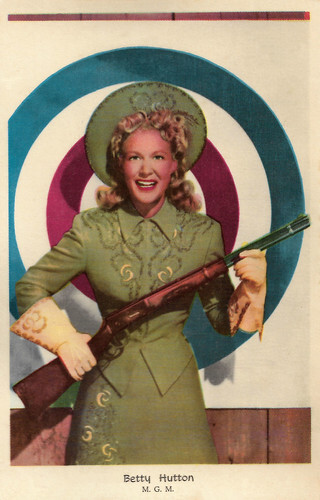
Vintage postcard. Photo: M.G.M. Betty Hutton in Annie Get Your Gun (George Sidney, 1950).
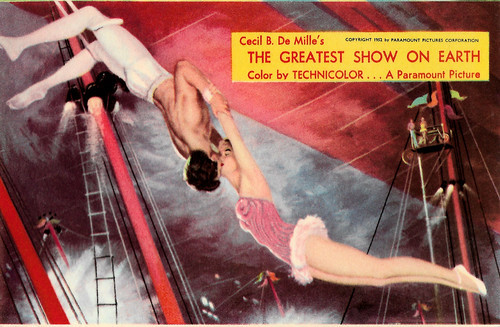
Dutch promotion card by Paramount Pictures. Photo: Paramount Pictures. Betty Hutton and Cornel Wilde in The Greatest Show on Earth (Cecil B. DeMille, 1952). Caption: Acrobatic tours in the skies of the cold-blooded Cornel Wilde and the no less skilled Betty Hutton in one of the most sensational scenes of The Greatest Show of Earth. Further protagonists are Charlton Heston , Dorothy Lamour, Gloria Grahame , and James Stewart .
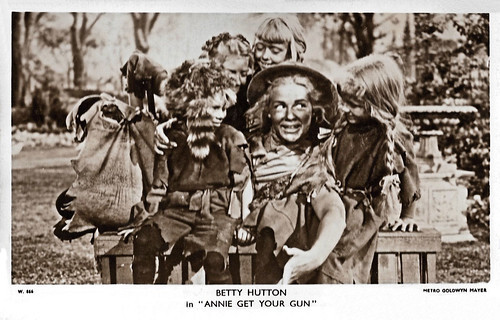
British postcard in the Picturegoer series, London, no. W. 866. Photo: Metro Goldwyn Mayer. Betty Hutton in Annie Get Your Gun (George Sidney, 1950).
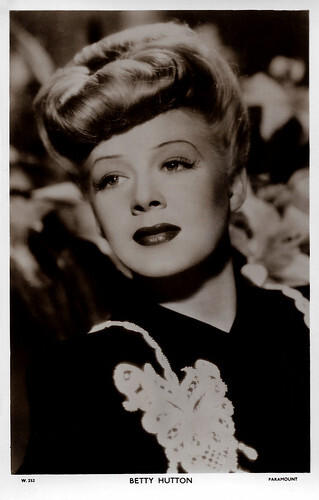
British postcard in the Picturegoer Series, London, no. W 252. Photo: Paramount. Betty Hutton in Dream Girl (Mitchell Leisen, 1948).
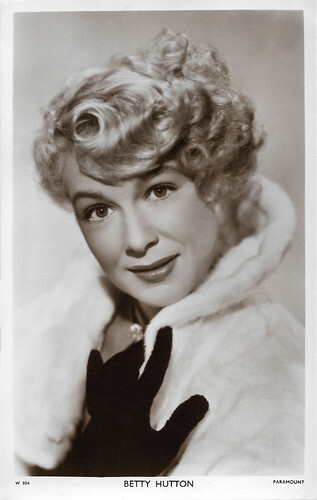
British postcard in the Picturegoer Series, London, no. W 804. Photo: Paramount.
Singing to any group that would listen
Betty Hutton was born Elizabeth June Thornburg in Battle Creek, Michigan, in 1921. She was the younger sister of Marion Hutton who later became popular as a solo singer with Glenn Miller's big band.
Two years later, Betty's father left the family and committed suicide 16 years later. Having to fend for themselves, Mrs. Thornburg moved the family to Detroit to find work in the numerous auto factories there, but times were hard. She decided to take advantage of Prohibition and opened a small tavern, at the time called a speakeasy.
At nine years old, Betty began singing publicly for the first time in a school production. Realising the voice Betty had, her mother took her around Detroit to have her sing to any group that would listen. This was a small way of getting some money for the poor family.
When she was 13, Betty got a few singing jobs with local bands in the area. Thinking she was good enough to make it big time, she left for New York two years later to try a professional career. Unfortunately, she was rejected and Betty headed back to Detroit.
In 1937, she was discovered by Vincent Lopez who had a popular band that appeared on the local radio. He ensured that Hutton got roles in two Warner Brothers short films. In 1940, she would return to New York and on Broadway, her career took off. Betty starred in the Broadway shows 'Panama Hattie' and 'Two for the Show'.
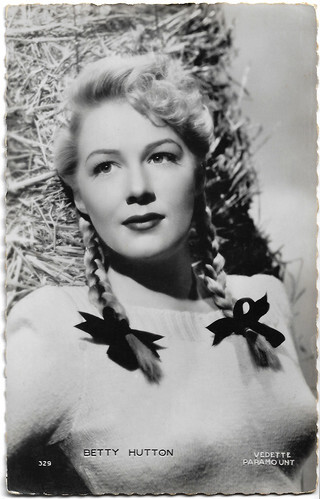
French postcard by Editions P.I., no. 329, 1954. Photo: Paramount Pictures Inc.
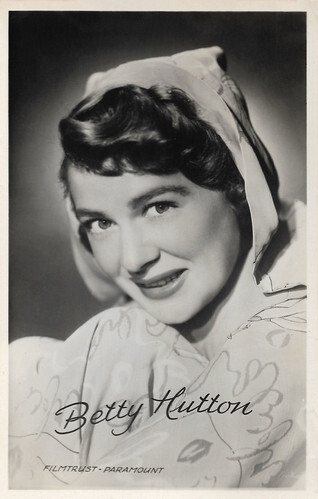
Vintage postcard. Photo: Filmtrust / Paramount.
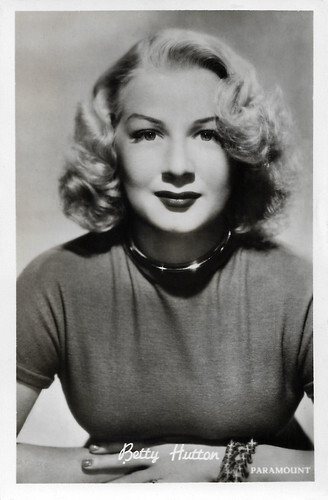
Belgian postcard by Nieuwe Merksemsche Chocolaterie S.P.R.L., Merksem (Antwerp). Photo: Paramount.
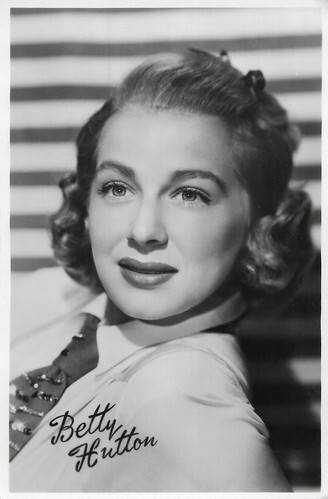
Dutch postcard. Photo: Paramount.
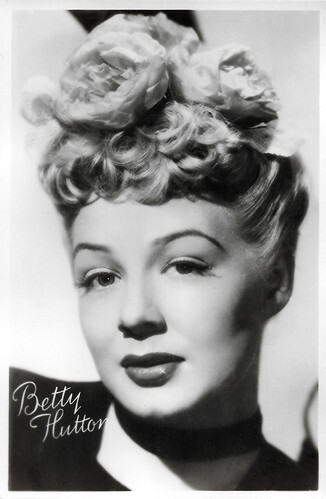
Dutch postcard. Photo: Paramount.
Sharpshooter Annie Oakley
The following year, Betty Hutton left New York for Hollywood, where she was to find new life in films. She was signed by Paramount Pictures and made her debut, at 21, in The Fleet's In (Victor Schertzinger, 1942), along with Eddie Bracken, William Holden , and Dorothy Lamour .
Reviews were better than expected, with critics looking favourably upon her work. Hutton appeared in many films in the 1940s. These were mainly comedies and musicals. In 1944, she tried to break away from musicals and try her hand at a screwball comedy, The Miracle of Morgan's Creek (Preston Sturges, 1944).
She proved - to herself, the public, and the critics - that she was marketable outside musicals. Her most famous role was in Annie Get Your Gun (George Sidney, 1950) opposite Howard Keel. The film's screenplay is based on the 1946 musical of the same name by Herbert and Dorothy Fields and Irving Berlin.
The musical's libretto is loosely based on the life of sharpshooter Annie Oakley (1860-1926) who was part of Buffalo Bill's Wild West Show, along with her husband Frank Butler and Sitting Bull, among others. The role of Annie Oakley was originally intended for Judy Garland, but she could not play the role because of health problems. Annie Get Your Gun was a huge success in cinemas and made $8 million. The film won an Oscar for best music.
Two years later, Hutton played one of the main roles in The Greatest Show on Earth (Cecil B. De Mille, 1952) with Cornel Wilde, Charlton Heston , and James Stewart . This film about circus life was a box-office success, bringing in $14 million at the time of its release. It was also much appreciated by critics and won the Academy Award for Best Picture.
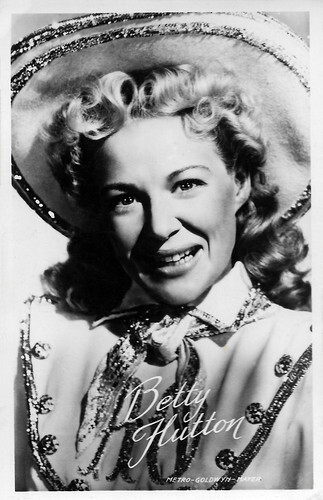
Vintage postcard, no. 247. Photo: Metro-Goldwyn-Mayer. Betty Hutton in Annie Get Your Gun (George Sidney, 1950).
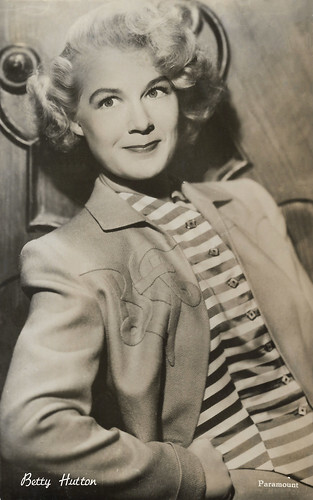
Vintage postcard. Photo: Paramount.
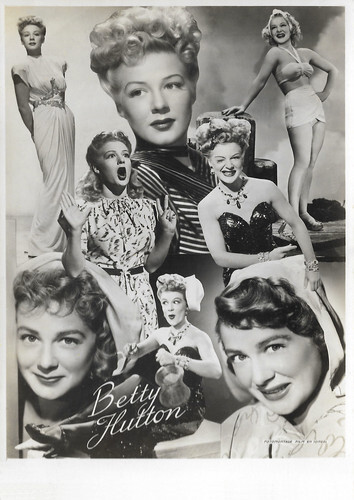
Big Dutch postcard by 't Sticht / Takken, no. 3148. Image: Film en Toneel.
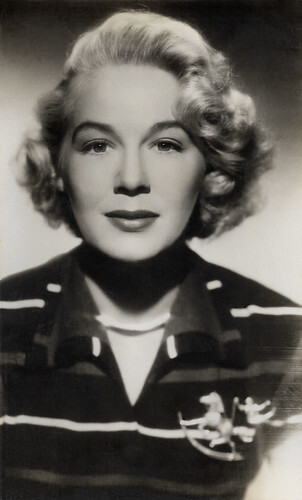
Spanish postcard, no. 2441.
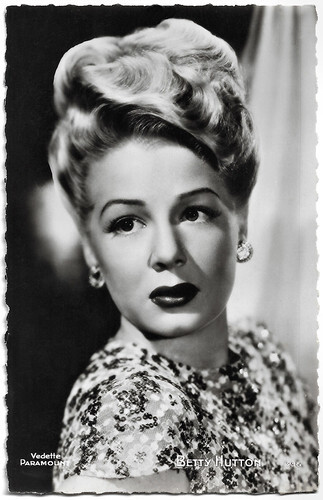
French postcard by Editions P.I., Paris, no. 235, offered by Victoria, Brussels, no. 639. Photo: Paramount, 1950.
The temper tantrum-prone Betty
After filming Somebody Loves Me (Irving Brecher, 1952), Betty Hutton was all but finished. She had married Charles O'Curran that year and he wanted to direct her in an upcoming film. Paramount didn't like the idea and the temper tantrum-prone Betty walked out of her contract and movies.
She did concentrate on the relatively new medium of television and the stage, but she never recovered her previous form. Her final film was a minor one, Spring Reunion (Robert Pirosh, 1956) with Dana Andrews . Hutton could mainly be seen in nightclubs in Las Vegas and did a lot of television work.
In 1959, for example, she had her own show, The Betty Hutton Show, but it didn't fare too well at all. In the 1970s, Hutton declined sharply. She stopped getting roles and her singing talent faded. She fled to alcohol, had a nervous breakdown, and tried to commit suicide.
She died in 2007 in Palm Springs, California, of the consequences of colon cancer. She was 86 years old. The news of her death was announced at her request after the funeral.
'It's Oh So Quiet', released in 1951 as the B-side of Hutton's single 'Murder, He Says', is a cover of the German song 'Und jetzt ist es still' by Horst Winter in 1948 to music by Austrian composer Hans Lang with German lyrics by Erich Meder. The English lyrics were written by Bert Reisfeld. 'It's Oh So Quiet' was exactly replicated by Björk in 1995 and became her most successful song.
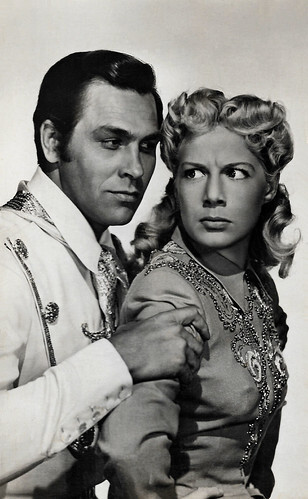
Spanish postcard by Archivo Bermejo, no. 4820. Photo: M.G.M. Howard Keel and Betty Hutton in Annie Get Your Gun (George Sidney, 1950). The Spanish title was La reina del oeste.
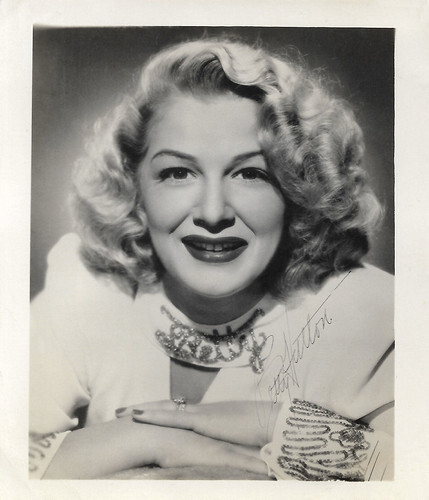
Small autograph card.
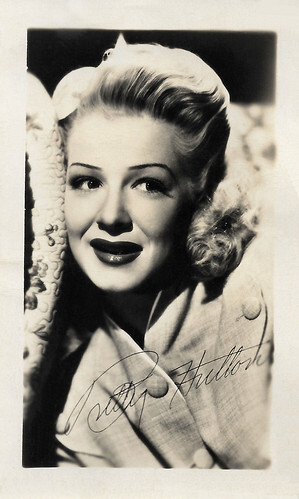
Small autograph card.
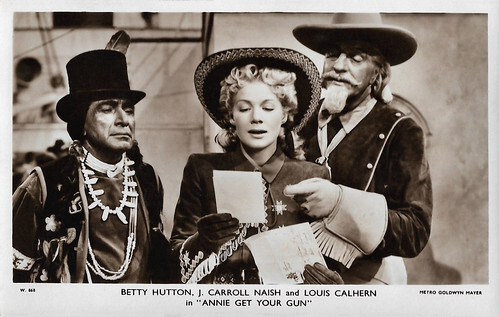
British postcard in the Picturegoer series, London, no. W. 868. Photo: Metro Goldwyn Mayer. Betty Hutton, J. Carrol Naish and Louis Calhern in Annie Get Your Gun (George Sidney, 1950).
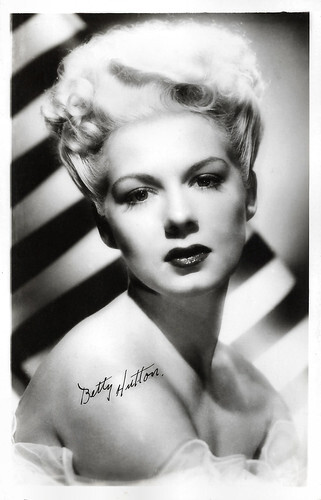
American postcard.
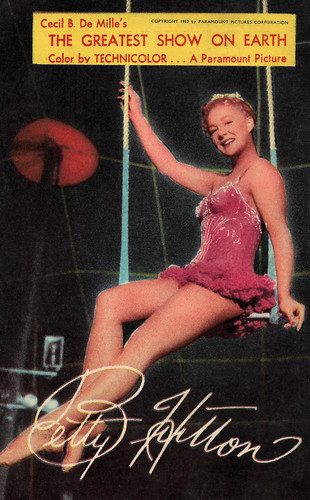
Dutch promotion card by Paramount Pictures. Photo: Paramount Pictures. Publicity still for The Greatest Show on Earth (Cecil B. DeMille, 1952).
Sources: (IMDb), Wikipedia (Dutch), and .

Vintage postcard. Photo: M.G.M. Betty Hutton in Annie Get Your Gun (George Sidney, 1950).

Dutch promotion card by Paramount Pictures. Photo: Paramount Pictures. Betty Hutton and Cornel Wilde in The Greatest Show on Earth (Cecil B. DeMille, 1952). Caption: Acrobatic tours in the skies of the cold-blooded Cornel Wilde and the no less skilled Betty Hutton in one of the most sensational scenes of The Greatest Show of Earth. Further protagonists are Charlton Heston , Dorothy Lamour, Gloria Grahame , and James Stewart .

British postcard in the Picturegoer series, London, no. W. 866. Photo: Metro Goldwyn Mayer. Betty Hutton in Annie Get Your Gun (George Sidney, 1950).

British postcard in the Picturegoer Series, London, no. W 252. Photo: Paramount. Betty Hutton in Dream Girl (Mitchell Leisen, 1948).

British postcard in the Picturegoer Series, London, no. W 804. Photo: Paramount.
Singing to any group that would listen
Betty Hutton was born Elizabeth June Thornburg in Battle Creek, Michigan, in 1921. She was the younger sister of Marion Hutton who later became popular as a solo singer with Glenn Miller's big band.
Two years later, Betty's father left the family and committed suicide 16 years later. Having to fend for themselves, Mrs. Thornburg moved the family to Detroit to find work in the numerous auto factories there, but times were hard. She decided to take advantage of Prohibition and opened a small tavern, at the time called a speakeasy.
At nine years old, Betty began singing publicly for the first time in a school production. Realising the voice Betty had, her mother took her around Detroit to have her sing to any group that would listen. This was a small way of getting some money for the poor family.
When she was 13, Betty got a few singing jobs with local bands in the area. Thinking she was good enough to make it big time, she left for New York two years later to try a professional career. Unfortunately, she was rejected and Betty headed back to Detroit.
In 1937, she was discovered by Vincent Lopez who had a popular band that appeared on the local radio. He ensured that Hutton got roles in two Warner Brothers short films. In 1940, she would return to New York and on Broadway, her career took off. Betty starred in the Broadway shows 'Panama Hattie' and 'Two for the Show'.

French postcard by Editions P.I., no. 329, 1954. Photo: Paramount Pictures Inc.

Vintage postcard. Photo: Filmtrust / Paramount.

Belgian postcard by Nieuwe Merksemsche Chocolaterie S.P.R.L., Merksem (Antwerp). Photo: Paramount.

Dutch postcard. Photo: Paramount.

Dutch postcard. Photo: Paramount.
Sharpshooter Annie Oakley
The following year, Betty Hutton left New York for Hollywood, where she was to find new life in films. She was signed by Paramount Pictures and made her debut, at 21, in The Fleet's In (Victor Schertzinger, 1942), along with Eddie Bracken, William Holden , and Dorothy Lamour .
Reviews were better than expected, with critics looking favourably upon her work. Hutton appeared in many films in the 1940s. These were mainly comedies and musicals. In 1944, she tried to break away from musicals and try her hand at a screwball comedy, The Miracle of Morgan's Creek (Preston Sturges, 1944).
She proved - to herself, the public, and the critics - that she was marketable outside musicals. Her most famous role was in Annie Get Your Gun (George Sidney, 1950) opposite Howard Keel. The film's screenplay is based on the 1946 musical of the same name by Herbert and Dorothy Fields and Irving Berlin.
The musical's libretto is loosely based on the life of sharpshooter Annie Oakley (1860-1926) who was part of Buffalo Bill's Wild West Show, along with her husband Frank Butler and Sitting Bull, among others. The role of Annie Oakley was originally intended for Judy Garland, but she could not play the role because of health problems. Annie Get Your Gun was a huge success in cinemas and made $8 million. The film won an Oscar for best music.
Two years later, Hutton played one of the main roles in The Greatest Show on Earth (Cecil B. De Mille, 1952) with Cornel Wilde, Charlton Heston , and James Stewart . This film about circus life was a box-office success, bringing in $14 million at the time of its release. It was also much appreciated by critics and won the Academy Award for Best Picture.

Vintage postcard, no. 247. Photo: Metro-Goldwyn-Mayer. Betty Hutton in Annie Get Your Gun (George Sidney, 1950).

Vintage postcard. Photo: Paramount.

Big Dutch postcard by 't Sticht / Takken, no. 3148. Image: Film en Toneel.

Spanish postcard, no. 2441.

French postcard by Editions P.I., Paris, no. 235, offered by Victoria, Brussels, no. 639. Photo: Paramount, 1950.
The temper tantrum-prone Betty
After filming Somebody Loves Me (Irving Brecher, 1952), Betty Hutton was all but finished. She had married Charles O'Curran that year and he wanted to direct her in an upcoming film. Paramount didn't like the idea and the temper tantrum-prone Betty walked out of her contract and movies.
She did concentrate on the relatively new medium of television and the stage, but she never recovered her previous form. Her final film was a minor one, Spring Reunion (Robert Pirosh, 1956) with Dana Andrews . Hutton could mainly be seen in nightclubs in Las Vegas and did a lot of television work.
In 1959, for example, she had her own show, The Betty Hutton Show, but it didn't fare too well at all. In the 1970s, Hutton declined sharply. She stopped getting roles and her singing talent faded. She fled to alcohol, had a nervous breakdown, and tried to commit suicide.
She died in 2007 in Palm Springs, California, of the consequences of colon cancer. She was 86 years old. The news of her death was announced at her request after the funeral.
'It's Oh So Quiet', released in 1951 as the B-side of Hutton's single 'Murder, He Says', is a cover of the German song 'Und jetzt ist es still' by Horst Winter in 1948 to music by Austrian composer Hans Lang with German lyrics by Erich Meder. The English lyrics were written by Bert Reisfeld. 'It's Oh So Quiet' was exactly replicated by Björk in 1995 and became her most successful song.

Spanish postcard by Archivo Bermejo, no. 4820. Photo: M.G.M. Howard Keel and Betty Hutton in Annie Get Your Gun (George Sidney, 1950). The Spanish title was La reina del oeste.

Small autograph card.

Small autograph card.

British postcard in the Picturegoer series, London, no. W. 868. Photo: Metro Goldwyn Mayer. Betty Hutton, J. Carrol Naish and Louis Calhern in Annie Get Your Gun (George Sidney, 1950).

American postcard.

Dutch promotion card by Paramount Pictures. Photo: Paramount Pictures. Publicity still for The Greatest Show on Earth (Cecil B. DeMille, 1952).
Sources: (IMDb), Wikipedia (Dutch), and .
Published on August 20, 2022 22:00
Eva-Maria Hagen (1934-2022)
German actress Eva-Maria Hagen died last Tuesday, 16 August 2022, at 87. From 1957 to 1965 she appeared in some 50 films and TV productions and became known as 'East-Germany’s Brigitte Bardot'. Her daughter, the well-known singer Nina Hagen, and two of her grandchildren told the German newspaper Bild on Friday. It is not known how she died. Eva-Maria Hagen was also a well-known singer, painter and author.
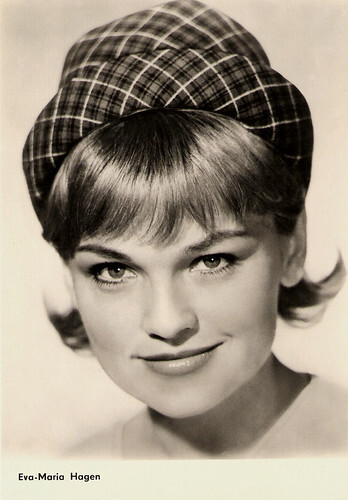
East-German postcard by VEB Progress Film-Vertrieb, Berlin, no. 1720, 1962. Retail price: 0,20 MDN. Photo: Ludwig Schirmer.
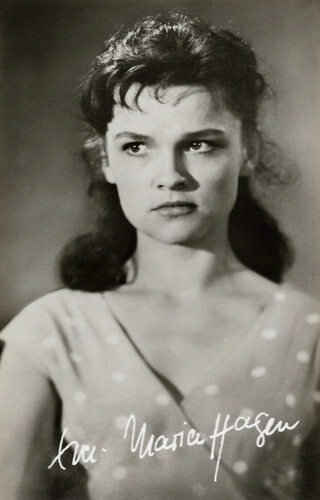
East-German postcard by VEB Progress Film-Vertrieb, Berlin, no. 245/465, 1957. Photo: DEFA / Wenzel. Eva-Maria Hagen in Vergesst mir meine Traudel nicht/Don’t Forget My Traudel (Kurt Maetzig, 1957).
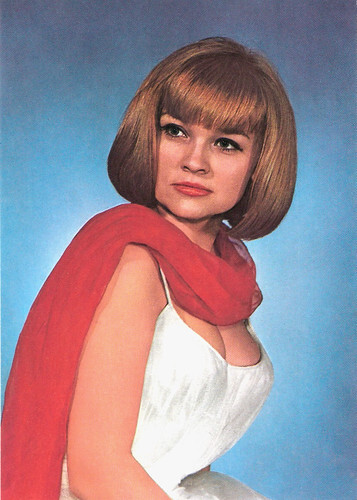
East-German postcard by VEB Progress Film-Vertrieb, Berlin, no. 2249, 1965. Retail price: 0,15 MDN. Photo: Schwarzer.
Sexy blondes
Eva-Maria Hagen was born as Eva-Maria Buchholz in Költschen, Germany (now Kolczyn, Poland) in 1934. She grew up in Kremlin at the edge of Pommern until the age of ten.
After graduating from machine fitter training, she started to attend actor's training in East Berlin in 1952. Already a year later she played a leading part under the direction of the legendary Bertolt Brecht at the famous Berliner Ensemble Theater in the play 'Katzgraben' (Cat’s Grave) by Erwin Strittmatter.
A year later she married the author and screenplay writer Hans Oliva-Hagen, but they divorced in 1959. In 1955 their daughter Catherina was born, who would later become pop star Nina Hagen . In 1956 she continued her acting studies at the Fritz-Kirchoff-Akademie in West Berlin.
Eva-Maria Hagen began her film career in the heart-warming DEFA comedy Vergesst mir meine Traudel nicht/Don’t Forget My Traudel (Kurt Maetzig, 1957). According to IMDb reviewer Lillian Hartman, Hagen refreshingly played a silly but also very anxious girl who has no place in this world due to World War II.
In 1958 she obtained an engagement at the Maxim-Gorki-Theater in Berlin, and in the following years, Hagen became one of the most important actresses on the East-German theatre scene. Although she is dark-haired by nature she had to dye her hair blonde to play sexy blondes, which gave her the nickname ’Brigitte Bardot der DDR’ ( Brigitte Bardot of the German Democratic Republic).
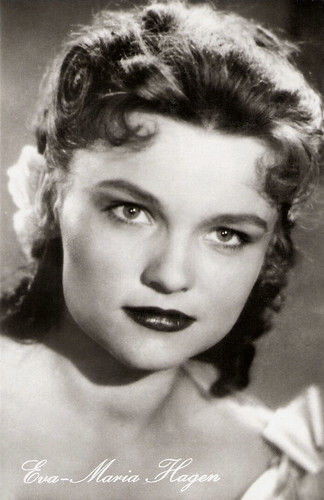
East-German postcard by VEB Progress Film-Vertrieb, Berlin, no. 106/632, 1958. Retail price: 0,20 DM. Photo: DEFA-Neufeld.
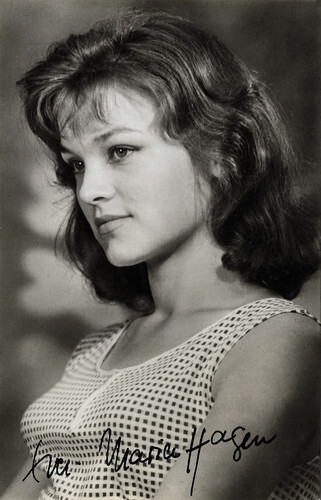
East-German postcard by VEB Progress Film-Vertrieb, Berlin, no. 11851, 1957. Photo: Franz Radocay.
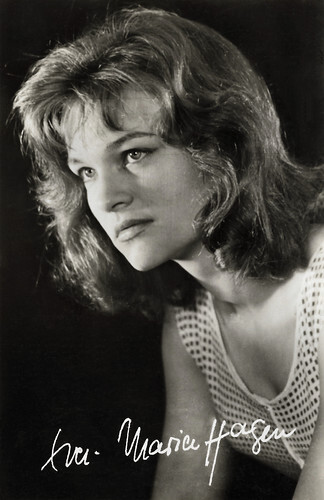
East-German postcard by VEB Progress Film-Vertrieb, Berlin, no. 11851 b, 1957. Photo: Franz Radocay.
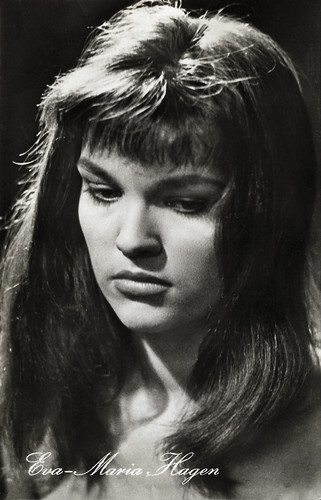
East-German postcard by VEB Progress Film-Vertrieb, Berlin, no. 688, 1958. Photo: Kiesling.
Defamation of the State
From 1957 to 1965, Eva-Maria Hagen appeared in some 50 films and TV productions, like Nur eine Frau/Just A Woman (Carl Balhaus, 1958), the thriller For Eyes Only (János Veiczi, 1963), and the comedy Reise ins Ehebett/Journey in a Marriage Bed (Joachim Hasler, 1966) with Anna Prucnal .
She was a star guest at the Filmfestival in Karlovy Vary and other events. In 1965 she met songwriter and poet Wolf Biermann. The two became life partners from 1965 till 1972.
In 1966, Biermann got a 'berufsverbot' to play and publish by the Socialist Unity Party of Germany (SED). This also put Hagen in the line of fire of the GDR government. There was a lawsuit against her concerning ‘defamation of the state’.
Job opportunities got heavily restricted so that Hagen at times had to work for provincial theatres and she could only play small roles in films like Die Fahne von Kriwoj Rog/The Flag of Krivoy Rog (Kurt Maetzig, 1967) and Die Legende von Paul und Paula/The Legend of Paul and Paula (Heiner Carow, 1973) with Angelica Domröse .
Furthermore, she was discriminated against and observed by the Stasi, the official state security service of the German Democratic Republic. In 1977, after she protested against Biermann's expulsion from the GDR in 1976, she was finally also stripped of her GDR citizenship. She was forced to emigrate with Nina and settled in Hamburg.
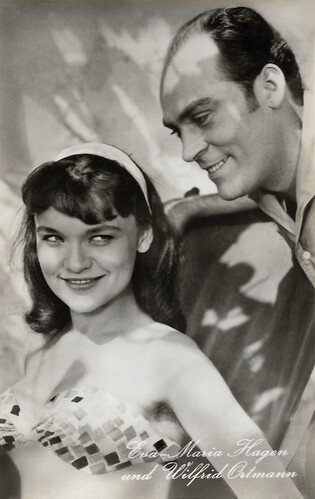
East-German postcard by VEB Progress Film-Vertrieb, Berlin, no. 957. Photo: DEFA / Pathenheimer. Eva-Maria Hagen and Wilfrid Ortmann in Ware für Katalonien/Goods for Catalonia (Richard Groschopp, 1959).
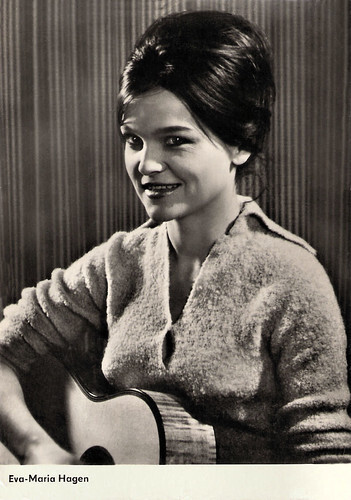
East-German postcard by VEB Progress Film-Vertrieb, Berlin, no. 1454, 1961. Retail price: 0,20 MDN. Photo: Kurt Mihatsch.
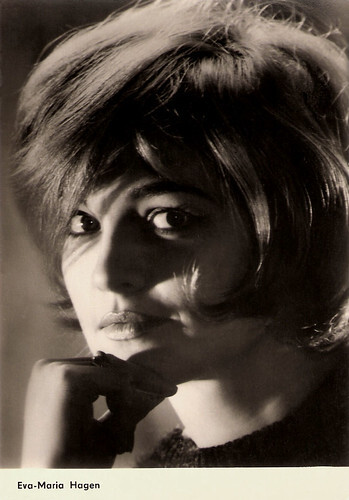
East-German postcard by VEB Progress Film-Vertrieb, Berlin, no. 1668, 1962. Retail price: 0,20 MDN. Photo: Harry Hirschfeld.
After the Fall of the Wall
In West Germany, Eva-Maria Hagen started a successful career interpreting songs by Wolf Biermann and Bertolt Brecht. Her debut album, 'Nicht Liebe Ohne die Liebe' (Not Without Love, 1979), was a collection of Russian and Gypsy folk songs translated into German by Wolf Biermann.
Biermann started to write songs for her which she released on the album 'Ich Leb' Mein Leben' (I Live My Life) in 1981. On 'Das mit den Männern und Den Frau'n' (That Thing Between Men and Women, 1985) and 'Michael, Michael' (1986) she continued the collaboration with Biermann.
After the fall of the wall in 1989, she was finally allowed to perform again in East Germany, like with Biermann at the Leipziger Messe.
She also played supporting roles in films like Gibbi - Westgermany (Christel Buschmann, 1980) with Eric Burdon, and Marmor, Stein und Eisen bricht/Marble, Stone and Iron Break (Hans-Christof Stenzel, 1982), a biopic of tragic Schlager singer Drafi Deutscher.
At the time she lived together with director Matti Geschonneck, and later with pianist Siegfried Gerlich.
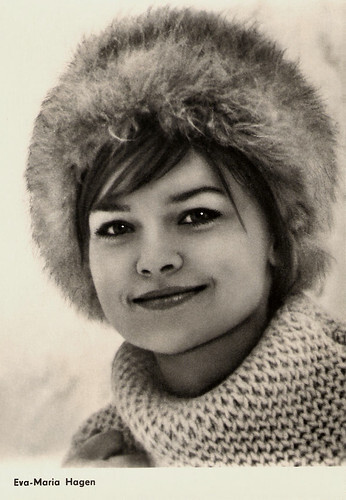
East-German postcard by VEB Progress Film-Vertrieb, Berlin, no. 1.812, 1963. Retail price: 0,20 MDN. Photo: Christa Benjack.
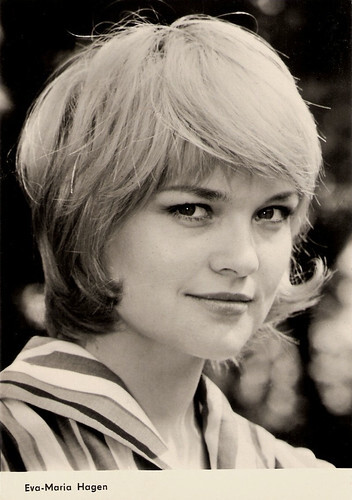
East-German postcard by VEB Progress Film-Vertrieb, Berlin, no. 1.816, 1963. Retail price: 0,20 DM. Photo: Ludwig Schirmer.
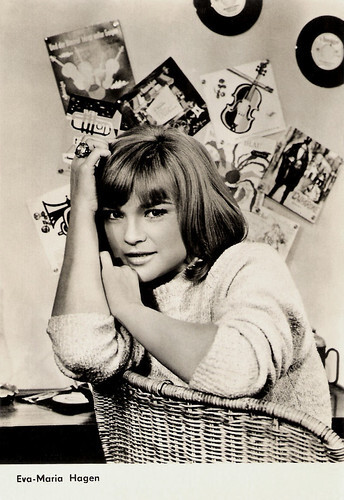
East-German postcard by VEB Progress Film-Vertrieb, Berlin, no. 2331, 1965. Retail price: 0,20 MDN. Photo: Raddatz.
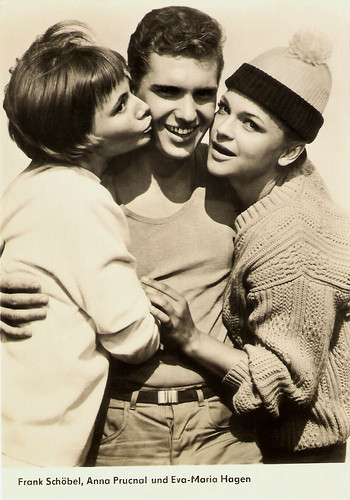
East-German postcard by VEB Progress Film-Vertrieb, Berlin, no. 2511, 1965. Retail price: 0,20 MDN. Photo: Kroiss. Frank Schöbel , Anna Prucnal and Eva-Maria Hagen in Reise ins Ehebett/Journey into the Nuptial Bed (Joachim Hasler, 1966).
Eva and the Wolf
Eva Maria Hagen regularly appeared on German TV, like in the popular adventure series 4 gegen Z/Four Against Z (2005-2007) starring Udo Kier. Together with her daughter Nina and her granddaughter Cosma Shiva, she appeared in the TV film Ein Mann für gewisse Sekunden/A Man For Certain Seconds (Bernhard Stephan, 1999).
Besides her theatre and film projects, as well as exhibitions of her paintings, she continued to release CDs: 'Wenn Ich Erstmal Losleg' (Once When I get Started, 1996) with new Biermann songs using Baltic folk material, and on occasion of Brecht's 100th birthday she released 'Joe, Mach die Musik von Damals Nach' (Joe, Play That Music from Then Again, 1997).
Her book 'Eva und der Wolf' (1998, Eva and Wolf) about her time together with Biermann was a big success in Germany. She was awarded the Carl Zuckmayr medal for her book. In 1999 she released another album with Biermann songs: 'Eva Singt Wolfslieder' (Eva Sings Wolf’s Songs). In 2006 she published another autobiographical book, 'Eva jenseits vom Paradies' (Eva Out of Paradise).
She returned in the cinema in Dinosaurier/Dinosaurs (Leander Haußmann, 2009) with Walter Giller and Nadja Tiller . This crime comedy was a remake of the film Lina Braake (Bernhard Sinkel, 1975) about an 81-year-old lady bank robber. Her last appearance on the big screen was in the international co-production Lore (Cate Shortland, 2012).
On 16 August 2022, Eva-Maria Hagen died in Hamburg at the age of 87. Besides her daughter Nina Hagen , her granddaughter Cosma Shiva Hagen is also active as an actress.
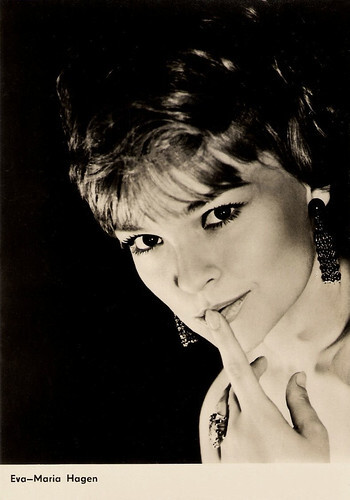
East-German postcard by VEB Progress Film-Vertrieb, Berlin, no. 2601, 1966. Retail price: 0,20 MDN. Photo: S. Peters.
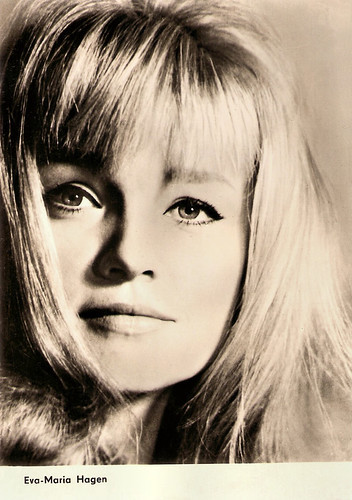
East-German postcard by VEB Progress Film-Vertrieb, Berlin, no. 2730, 1966. Retail price: 0,20 MDN.
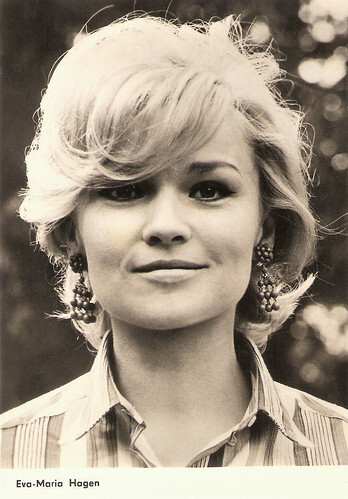
East-German postcard by VEB Progress Film-Vertrieb, Berlin, no. 2925, 1967. Retail price: 0,20 MDN. Photo: Melies.
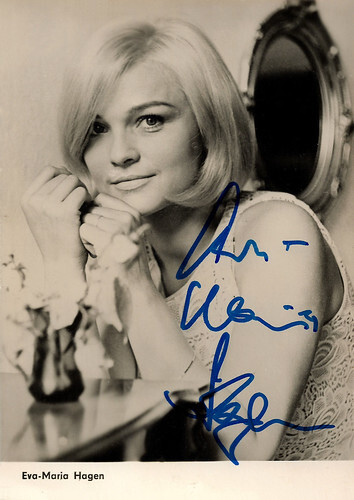
East-German postcard by VEB Progress Film-Vertrieb, Berlin, no. 3092, 1968. Photo: Schwarz / DEFA.
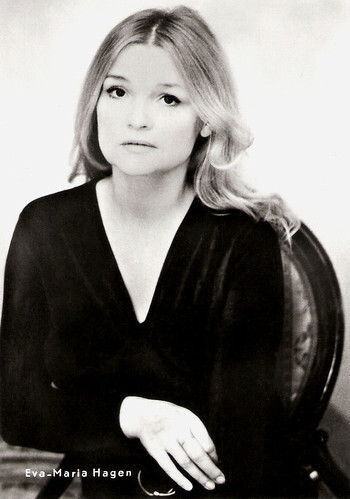
East-German postcard by VEB Progress Film-Vertrieb, Berlin, no. 63/76, 1976. Retail price: 0,20 M. Photo: Bergemann.
Eva Maria Hagen and Nina Hagen sing two songs by Bertolt Brecht together, 'Eifersuchtsduett' (Duet of jealousy) and 'Alabama Song. It was their first duet in public. Source: gnapgnapgnap (YouTube).
Sources: Frank Eisenhuth (AllMusic), Filmportal.de, Wikipedia (German) and .

East-German postcard by VEB Progress Film-Vertrieb, Berlin, no. 1720, 1962. Retail price: 0,20 MDN. Photo: Ludwig Schirmer.

East-German postcard by VEB Progress Film-Vertrieb, Berlin, no. 245/465, 1957. Photo: DEFA / Wenzel. Eva-Maria Hagen in Vergesst mir meine Traudel nicht/Don’t Forget My Traudel (Kurt Maetzig, 1957).

East-German postcard by VEB Progress Film-Vertrieb, Berlin, no. 2249, 1965. Retail price: 0,15 MDN. Photo: Schwarzer.
Sexy blondes
Eva-Maria Hagen was born as Eva-Maria Buchholz in Költschen, Germany (now Kolczyn, Poland) in 1934. She grew up in Kremlin at the edge of Pommern until the age of ten.
After graduating from machine fitter training, she started to attend actor's training in East Berlin in 1952. Already a year later she played a leading part under the direction of the legendary Bertolt Brecht at the famous Berliner Ensemble Theater in the play 'Katzgraben' (Cat’s Grave) by Erwin Strittmatter.
A year later she married the author and screenplay writer Hans Oliva-Hagen, but they divorced in 1959. In 1955 their daughter Catherina was born, who would later become pop star Nina Hagen . In 1956 she continued her acting studies at the Fritz-Kirchoff-Akademie in West Berlin.
Eva-Maria Hagen began her film career in the heart-warming DEFA comedy Vergesst mir meine Traudel nicht/Don’t Forget My Traudel (Kurt Maetzig, 1957). According to IMDb reviewer Lillian Hartman, Hagen refreshingly played a silly but also very anxious girl who has no place in this world due to World War II.
In 1958 she obtained an engagement at the Maxim-Gorki-Theater in Berlin, and in the following years, Hagen became one of the most important actresses on the East-German theatre scene. Although she is dark-haired by nature she had to dye her hair blonde to play sexy blondes, which gave her the nickname ’Brigitte Bardot der DDR’ ( Brigitte Bardot of the German Democratic Republic).

East-German postcard by VEB Progress Film-Vertrieb, Berlin, no. 106/632, 1958. Retail price: 0,20 DM. Photo: DEFA-Neufeld.

East-German postcard by VEB Progress Film-Vertrieb, Berlin, no. 11851, 1957. Photo: Franz Radocay.

East-German postcard by VEB Progress Film-Vertrieb, Berlin, no. 11851 b, 1957. Photo: Franz Radocay.

East-German postcard by VEB Progress Film-Vertrieb, Berlin, no. 688, 1958. Photo: Kiesling.
Defamation of the State
From 1957 to 1965, Eva-Maria Hagen appeared in some 50 films and TV productions, like Nur eine Frau/Just A Woman (Carl Balhaus, 1958), the thriller For Eyes Only (János Veiczi, 1963), and the comedy Reise ins Ehebett/Journey in a Marriage Bed (Joachim Hasler, 1966) with Anna Prucnal .
She was a star guest at the Filmfestival in Karlovy Vary and other events. In 1965 she met songwriter and poet Wolf Biermann. The two became life partners from 1965 till 1972.
In 1966, Biermann got a 'berufsverbot' to play and publish by the Socialist Unity Party of Germany (SED). This also put Hagen in the line of fire of the GDR government. There was a lawsuit against her concerning ‘defamation of the state’.
Job opportunities got heavily restricted so that Hagen at times had to work for provincial theatres and she could only play small roles in films like Die Fahne von Kriwoj Rog/The Flag of Krivoy Rog (Kurt Maetzig, 1967) and Die Legende von Paul und Paula/The Legend of Paul and Paula (Heiner Carow, 1973) with Angelica Domröse .
Furthermore, she was discriminated against and observed by the Stasi, the official state security service of the German Democratic Republic. In 1977, after she protested against Biermann's expulsion from the GDR in 1976, she was finally also stripped of her GDR citizenship. She was forced to emigrate with Nina and settled in Hamburg.

East-German postcard by VEB Progress Film-Vertrieb, Berlin, no. 957. Photo: DEFA / Pathenheimer. Eva-Maria Hagen and Wilfrid Ortmann in Ware für Katalonien/Goods for Catalonia (Richard Groschopp, 1959).

East-German postcard by VEB Progress Film-Vertrieb, Berlin, no. 1454, 1961. Retail price: 0,20 MDN. Photo: Kurt Mihatsch.

East-German postcard by VEB Progress Film-Vertrieb, Berlin, no. 1668, 1962. Retail price: 0,20 MDN. Photo: Harry Hirschfeld.
After the Fall of the Wall
In West Germany, Eva-Maria Hagen started a successful career interpreting songs by Wolf Biermann and Bertolt Brecht. Her debut album, 'Nicht Liebe Ohne die Liebe' (Not Without Love, 1979), was a collection of Russian and Gypsy folk songs translated into German by Wolf Biermann.
Biermann started to write songs for her which she released on the album 'Ich Leb' Mein Leben' (I Live My Life) in 1981. On 'Das mit den Männern und Den Frau'n' (That Thing Between Men and Women, 1985) and 'Michael, Michael' (1986) she continued the collaboration with Biermann.
After the fall of the wall in 1989, she was finally allowed to perform again in East Germany, like with Biermann at the Leipziger Messe.
She also played supporting roles in films like Gibbi - Westgermany (Christel Buschmann, 1980) with Eric Burdon, and Marmor, Stein und Eisen bricht/Marble, Stone and Iron Break (Hans-Christof Stenzel, 1982), a biopic of tragic Schlager singer Drafi Deutscher.
At the time she lived together with director Matti Geschonneck, and later with pianist Siegfried Gerlich.

East-German postcard by VEB Progress Film-Vertrieb, Berlin, no. 1.812, 1963. Retail price: 0,20 MDN. Photo: Christa Benjack.

East-German postcard by VEB Progress Film-Vertrieb, Berlin, no. 1.816, 1963. Retail price: 0,20 DM. Photo: Ludwig Schirmer.

East-German postcard by VEB Progress Film-Vertrieb, Berlin, no. 2331, 1965. Retail price: 0,20 MDN. Photo: Raddatz.

East-German postcard by VEB Progress Film-Vertrieb, Berlin, no. 2511, 1965. Retail price: 0,20 MDN. Photo: Kroiss. Frank Schöbel , Anna Prucnal and Eva-Maria Hagen in Reise ins Ehebett/Journey into the Nuptial Bed (Joachim Hasler, 1966).
Eva and the Wolf
Eva Maria Hagen regularly appeared on German TV, like in the popular adventure series 4 gegen Z/Four Against Z (2005-2007) starring Udo Kier. Together with her daughter Nina and her granddaughter Cosma Shiva, she appeared in the TV film Ein Mann für gewisse Sekunden/A Man For Certain Seconds (Bernhard Stephan, 1999).
Besides her theatre and film projects, as well as exhibitions of her paintings, she continued to release CDs: 'Wenn Ich Erstmal Losleg' (Once When I get Started, 1996) with new Biermann songs using Baltic folk material, and on occasion of Brecht's 100th birthday she released 'Joe, Mach die Musik von Damals Nach' (Joe, Play That Music from Then Again, 1997).
Her book 'Eva und der Wolf' (1998, Eva and Wolf) about her time together with Biermann was a big success in Germany. She was awarded the Carl Zuckmayr medal for her book. In 1999 she released another album with Biermann songs: 'Eva Singt Wolfslieder' (Eva Sings Wolf’s Songs). In 2006 she published another autobiographical book, 'Eva jenseits vom Paradies' (Eva Out of Paradise).
She returned in the cinema in Dinosaurier/Dinosaurs (Leander Haußmann, 2009) with Walter Giller and Nadja Tiller . This crime comedy was a remake of the film Lina Braake (Bernhard Sinkel, 1975) about an 81-year-old lady bank robber. Her last appearance on the big screen was in the international co-production Lore (Cate Shortland, 2012).
On 16 August 2022, Eva-Maria Hagen died in Hamburg at the age of 87. Besides her daughter Nina Hagen , her granddaughter Cosma Shiva Hagen is also active as an actress.

East-German postcard by VEB Progress Film-Vertrieb, Berlin, no. 2601, 1966. Retail price: 0,20 MDN. Photo: S. Peters.

East-German postcard by VEB Progress Film-Vertrieb, Berlin, no. 2730, 1966. Retail price: 0,20 MDN.

East-German postcard by VEB Progress Film-Vertrieb, Berlin, no. 2925, 1967. Retail price: 0,20 MDN. Photo: Melies.

East-German postcard by VEB Progress Film-Vertrieb, Berlin, no. 3092, 1968. Photo: Schwarz / DEFA.

East-German postcard by VEB Progress Film-Vertrieb, Berlin, no. 63/76, 1976. Retail price: 0,20 M. Photo: Bergemann.
Eva Maria Hagen and Nina Hagen sing two songs by Bertolt Brecht together, 'Eifersuchtsduett' (Duet of jealousy) and 'Alabama Song. It was their first duet in public. Source: gnapgnapgnap (YouTube).
Sources: Frank Eisenhuth (AllMusic), Filmportal.de, Wikipedia (German) and .
Published on August 20, 2022 06:34
August 19, 2022
Photo by Ghergo
Arturo Ghergo (1901-1959) was one of Italy’s great glamour and fashion photographers between 1930 and 1959. All the people who counted at that time could be found in his photography studio on Rome’s Via Condotti. His work is characterised by a special shooting technique and subsequent manipulation of the photos that were quite cutting edge for the times. His shots were very much in vogue and many Italian VIPs competed to be captured by his camera’s lens. With his camera, he immortalised the beauty and elegance of upper middle-class personalities, and descendants of noble families in the 1930s, 1940s and 1950s. He also managed to establish a special relationship with Cinecittà.

Italian postcard by Rizzoli, 1937. Photo: Ghergo.
Leda Gloria (1912-1997) was one of Federico Fellini’s favourite film actresses, having a prolific career in the 1930s and 1940s but is also remembered as the wife of Peppone in the Don Camillo films.

Italian postcard by Rizzoli & C., Milano, 1939-XVIII. Photo: Ghergo. Sent by mail in 1940.
Germana Paolieri (1906-1998) was an Italian stage and screen actress. After the war, she also worked for radio and television. As an actress, she flourished between the early 1930s and 1981, while as a film actress she peaked in the 1930s and early 1940s, but also the mid-1950s.
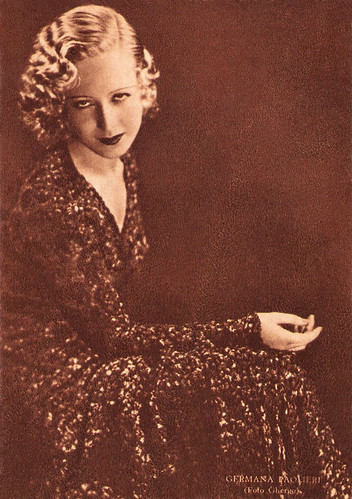
Italian postcard by Rizzoli & C., Milano, 1942-XX. Photo: Ghergo.
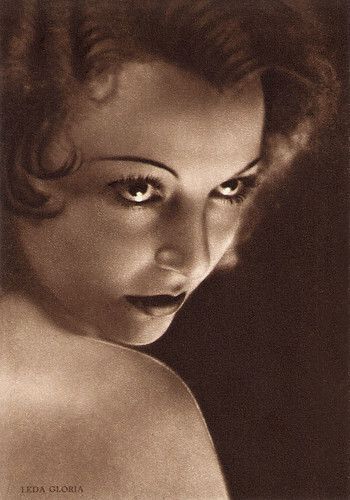
Italian postcard by Rizzoli, Milano, 1940. Photo: Ghergo.
Leda Gloria (1912-1997) was one of Federico Fellini’s favourite film actresses, having a prolific career in the 1930s and 1940s but is also remembered as the wife of Peppone in the Don Camillo films.
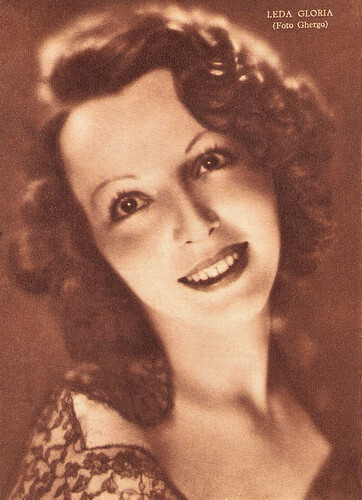
Italian postcard by Rizzoli, Milano, 1942. Photo: Ghergo.
A beauty which was not necessarily real
Arturo Ghergo was born in 1901 in Montefano in the Italian province of Macerata, the Marche region. At the age of 28, Ghergo moved to Rome in 1929 and opened a photography studio in the highly central location of Via Condotti. Within a few years, he managed to make a name for himself as the most sought-after portrait artist in Rome. His work was much in demand with film stars, politicians, and other personalities from the world of culture.
Above all, Ghergo was in demand by the Rome's high society which was anxious to use every means, including photography, to reaffirm its traditional role at the head of society which a new phase in history was in danger of calling into question, and which very often lent its prestige to the then embryonic fashion industry.
Ghergo was a pioneer of fashion photography in Italy. His photos are testimonials for the exclusive creations of the emerging fashion houses Fontana, Gabriella Sport, Galitzine, Simonetta, Carosa, and Gattinoni. The models of the day, carrying the grand-sounding names of the "beau monde", included a very young Marella Caracciolo long before she was married to Fiat's Giovanni Agnelli, or Consuelo Crespi, Mary Colonna, Josè del Drago and Irene Galitzine.
But above all, it was the world of the cinema that placed the exaltation of its photogenic qualities in Ghergo's hands. In the years in which Italy was setting off, down the path of self-sufficiency in the celluloid industry, the country's film stars were determined to use Ghergo's skilled lens to ensure that the Italian filmgoing public did not miss the celebrities from across the Atlantic.
From Isa Miranda to Mariella Lotti , Leda Gloria , Alida Valli , Marina Berti, Assia Noris , Maria Denis , Valentina Cortese , Clara Calamai , Paola Barbara , Amedeo Nazzari , Massimo Girotti and right on into the 1950s with Sophia Loren , Silvana Pampanini , Gina Lollobrigida , Silvana Mangano and Vittorio Gassman and an endless list of aspiring starlets, all transfigured by Ghergo's touch into sophisticated demigoddesses.
A connoisseur of perfection and a professional with impeccable taste, Ghergo invented his own style of sophisticated classicism, carefully constructed without fear of experimentation, through diagonal cuts, disorienting dissonances and refined illuminations. Ghergo's iconographic formula ensured that he was to enjoy a practically unchanged reputation and immense public consideration right up to his premature death in 1959.
Even as fashions changed and as new forms of expression were being introduced and tested with colour photography, advertising and painting, Ghergo remained essentially loyal to his style, continuing to evince his own personal and unfaltering allegiance to the cult of beauty - a beauty which was not necessarily real, which may have been the result of a chemical and physical recording process in analogue mode, but which was laboriously and meticulously constructed with the contrived, exalted and inspiring light that lay more in Ghergo's mind than in his sitter's features.
He also worked in advertising and painting. In the 1950s, Ghergo created paintings, influenced by Pablo Picasso's cubism and his futurist and cinematographic experience. He combined in his paintings the instinctive search for framing, typical of his craft, with the exaltation of a visual layout of broader direction, typical of painting.
From 3 April to 8 July 2012, the Palazzo delle Esposizioni in Rome presented the exhibition 'Arturo Ghergo - Fotografie 1930-1959' (Arturo Ghergo. Photographs 1930-1959), with over 250 photographs by Ghergo. The exhibition was curated by Ghergo's daughter, Cristina Ghergo.
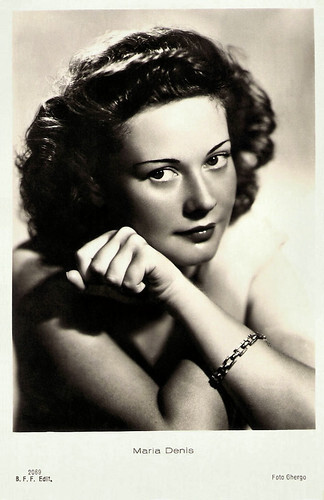
Italian postcard by B.F.F. Edit. (Casa Editr. Ballerini & Fratini, Firenze), no. 2069. Photo: Ghergo.
María Denis (1916-2004) was one of the most popular stars of Italian cinema under Fascist rule. Very successful were her Telefoni Bianchi films of the 1930s. Charges of collaboration tarnished her career after the war. Controversial were her claims that she had not been the mistress of Nazi police chief Pietro Koch and just used his infatuation with her to help anti-fascists get released, especially film director Luchino Visconti.
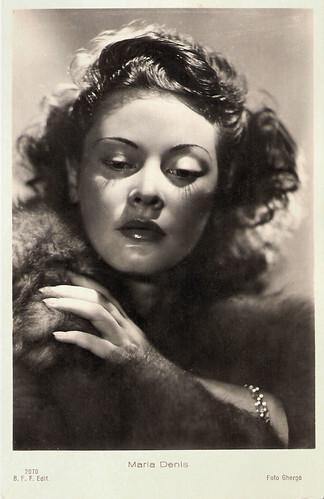
Italian postcard by B.F.F. Edit. (Casa Editr. Ballerini & Fratini, Firenze), no. 2070. Photo: Ghergo.
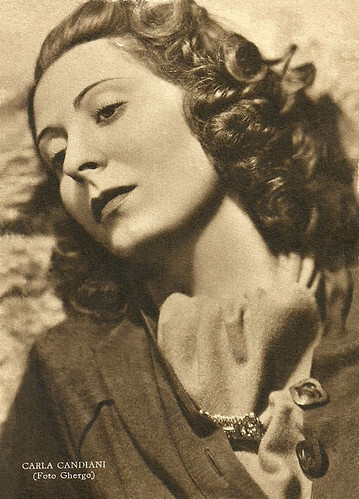
Italian postcard by Rizzoli & C., Milano, 1941. Photo: Ghergo.
Carla Candiani (1916-2005) was an Italian film actress. Discovered by the Italian public in Raffaello Matarazzo's thriller Albergo degli assenti (1939), she took part in seventeen films during her career, from the late 1930s to the late 1940s.
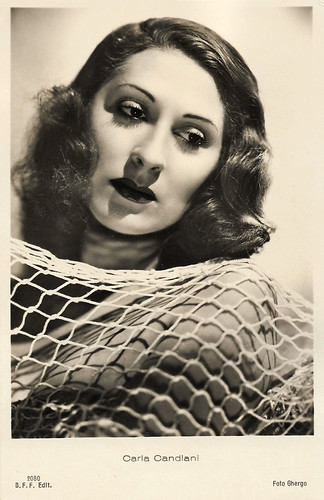
Italian postcard by B.F.F. Edit. (Casa Editr. Ballerini & Fratini, Firenze), no. 2080. Photo: Ghergo.
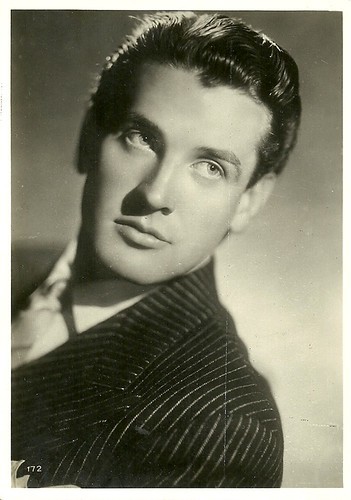
Italian postcard, no. 172. Photo: Ghergo.
Handsome, manly Italian actor Massimo Girotti (1918-2003) had a career that spanned seven decades. He is best remembered for three roles: the young wanderer Gino in Luchino Visconti's Ossessione (1943), the stern lover in Michelangelo Antonioni's Cronaca di un amore (1950) and the passionate patriot in Visconti's Senso (1954).
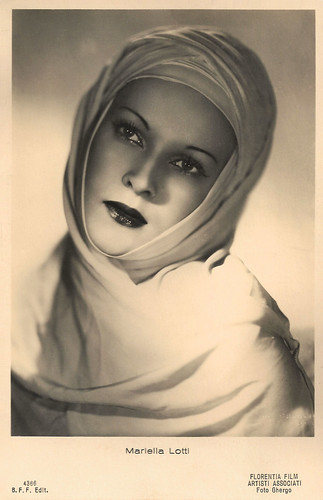
Italian postcard by B.F.F. Edit. (Casa Editr. Ballerini & Fratini, Firenze), no. 4365. Photo: Ghergo / Florentia Film Artisti Associati. Mariella Lotti in La Gorgona/The Gorgon (Guido Brignone, 1942).
Blonde Italian film actress Mariella Lotti (1921-2006) played leading ladies in a number of Fascist-era and post-war films. The refined beauty quickly became one of the most popular Italian divas of the 1940s.
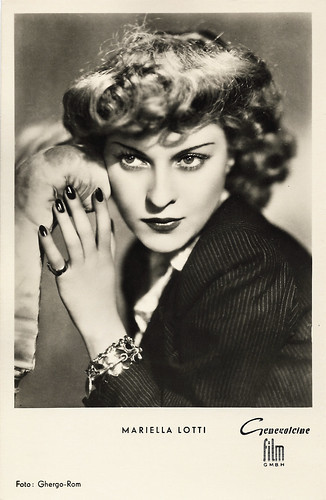
German postcard by Kunst und Bild, Berlin, no. A 570. Photo: Ghergo, Rome / Generalcine Film. Mariella Lotti in La donna che inventò l'amore/The Woman Who Invented Love (Ferruccio Cerio, 1952).
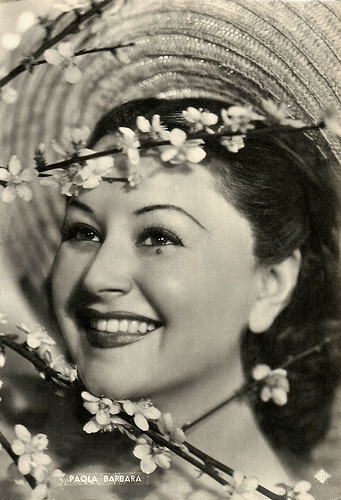
Italian postcard by ASER (A. Scarmiglia Edizioni Roma). Photo: Ghergo.
Paola Barbara (1912-1989) was an Italian actress who acted in over 60 films but also worked on stage and on television. She is best known for the film La peccatrice (1940) by Amleto Palermi.
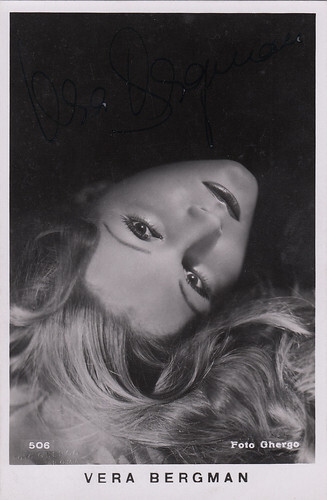
Vintage postcard, no. 506. Photo: Ghergo. Collection: Marlène Pilaete.
Vera Bergman (1920–1971) was the daughter of a German diplomat who became a star in Italian films in the 1940s.
Sources: Palazzo delle esposione, Arte (Italian), and Rome Luxury Blog.

Italian postcard by Rizzoli, 1937. Photo: Ghergo.
Leda Gloria (1912-1997) was one of Federico Fellini’s favourite film actresses, having a prolific career in the 1930s and 1940s but is also remembered as the wife of Peppone in the Don Camillo films.

Italian postcard by Rizzoli & C., Milano, 1939-XVIII. Photo: Ghergo. Sent by mail in 1940.
Germana Paolieri (1906-1998) was an Italian stage and screen actress. After the war, she also worked for radio and television. As an actress, she flourished between the early 1930s and 1981, while as a film actress she peaked in the 1930s and early 1940s, but also the mid-1950s.

Italian postcard by Rizzoli & C., Milano, 1942-XX. Photo: Ghergo.

Italian postcard by Rizzoli, Milano, 1940. Photo: Ghergo.
Leda Gloria (1912-1997) was one of Federico Fellini’s favourite film actresses, having a prolific career in the 1930s and 1940s but is also remembered as the wife of Peppone in the Don Camillo films.

Italian postcard by Rizzoli, Milano, 1942. Photo: Ghergo.
A beauty which was not necessarily real
Arturo Ghergo was born in 1901 in Montefano in the Italian province of Macerata, the Marche region. At the age of 28, Ghergo moved to Rome in 1929 and opened a photography studio in the highly central location of Via Condotti. Within a few years, he managed to make a name for himself as the most sought-after portrait artist in Rome. His work was much in demand with film stars, politicians, and other personalities from the world of culture.
Above all, Ghergo was in demand by the Rome's high society which was anxious to use every means, including photography, to reaffirm its traditional role at the head of society which a new phase in history was in danger of calling into question, and which very often lent its prestige to the then embryonic fashion industry.
Ghergo was a pioneer of fashion photography in Italy. His photos are testimonials for the exclusive creations of the emerging fashion houses Fontana, Gabriella Sport, Galitzine, Simonetta, Carosa, and Gattinoni. The models of the day, carrying the grand-sounding names of the "beau monde", included a very young Marella Caracciolo long before she was married to Fiat's Giovanni Agnelli, or Consuelo Crespi, Mary Colonna, Josè del Drago and Irene Galitzine.
But above all, it was the world of the cinema that placed the exaltation of its photogenic qualities in Ghergo's hands. In the years in which Italy was setting off, down the path of self-sufficiency in the celluloid industry, the country's film stars were determined to use Ghergo's skilled lens to ensure that the Italian filmgoing public did not miss the celebrities from across the Atlantic.
From Isa Miranda to Mariella Lotti , Leda Gloria , Alida Valli , Marina Berti, Assia Noris , Maria Denis , Valentina Cortese , Clara Calamai , Paola Barbara , Amedeo Nazzari , Massimo Girotti and right on into the 1950s with Sophia Loren , Silvana Pampanini , Gina Lollobrigida , Silvana Mangano and Vittorio Gassman and an endless list of aspiring starlets, all transfigured by Ghergo's touch into sophisticated demigoddesses.
A connoisseur of perfection and a professional with impeccable taste, Ghergo invented his own style of sophisticated classicism, carefully constructed without fear of experimentation, through diagonal cuts, disorienting dissonances and refined illuminations. Ghergo's iconographic formula ensured that he was to enjoy a practically unchanged reputation and immense public consideration right up to his premature death in 1959.
Even as fashions changed and as new forms of expression were being introduced and tested with colour photography, advertising and painting, Ghergo remained essentially loyal to his style, continuing to evince his own personal and unfaltering allegiance to the cult of beauty - a beauty which was not necessarily real, which may have been the result of a chemical and physical recording process in analogue mode, but which was laboriously and meticulously constructed with the contrived, exalted and inspiring light that lay more in Ghergo's mind than in his sitter's features.
He also worked in advertising and painting. In the 1950s, Ghergo created paintings, influenced by Pablo Picasso's cubism and his futurist and cinematographic experience. He combined in his paintings the instinctive search for framing, typical of his craft, with the exaltation of a visual layout of broader direction, typical of painting.
From 3 April to 8 July 2012, the Palazzo delle Esposizioni in Rome presented the exhibition 'Arturo Ghergo - Fotografie 1930-1959' (Arturo Ghergo. Photographs 1930-1959), with over 250 photographs by Ghergo. The exhibition was curated by Ghergo's daughter, Cristina Ghergo.

Italian postcard by B.F.F. Edit. (Casa Editr. Ballerini & Fratini, Firenze), no. 2069. Photo: Ghergo.
María Denis (1916-2004) was one of the most popular stars of Italian cinema under Fascist rule. Very successful were her Telefoni Bianchi films of the 1930s. Charges of collaboration tarnished her career after the war. Controversial were her claims that she had not been the mistress of Nazi police chief Pietro Koch and just used his infatuation with her to help anti-fascists get released, especially film director Luchino Visconti.

Italian postcard by B.F.F. Edit. (Casa Editr. Ballerini & Fratini, Firenze), no. 2070. Photo: Ghergo.

Italian postcard by Rizzoli & C., Milano, 1941. Photo: Ghergo.
Carla Candiani (1916-2005) was an Italian film actress. Discovered by the Italian public in Raffaello Matarazzo's thriller Albergo degli assenti (1939), she took part in seventeen films during her career, from the late 1930s to the late 1940s.

Italian postcard by B.F.F. Edit. (Casa Editr. Ballerini & Fratini, Firenze), no. 2080. Photo: Ghergo.

Italian postcard, no. 172. Photo: Ghergo.
Handsome, manly Italian actor Massimo Girotti (1918-2003) had a career that spanned seven decades. He is best remembered for three roles: the young wanderer Gino in Luchino Visconti's Ossessione (1943), the stern lover in Michelangelo Antonioni's Cronaca di un amore (1950) and the passionate patriot in Visconti's Senso (1954).

Italian postcard by B.F.F. Edit. (Casa Editr. Ballerini & Fratini, Firenze), no. 4365. Photo: Ghergo / Florentia Film Artisti Associati. Mariella Lotti in La Gorgona/The Gorgon (Guido Brignone, 1942).
Blonde Italian film actress Mariella Lotti (1921-2006) played leading ladies in a number of Fascist-era and post-war films. The refined beauty quickly became one of the most popular Italian divas of the 1940s.

German postcard by Kunst und Bild, Berlin, no. A 570. Photo: Ghergo, Rome / Generalcine Film. Mariella Lotti in La donna che inventò l'amore/The Woman Who Invented Love (Ferruccio Cerio, 1952).

Italian postcard by ASER (A. Scarmiglia Edizioni Roma). Photo: Ghergo.
Paola Barbara (1912-1989) was an Italian actress who acted in over 60 films but also worked on stage and on television. She is best known for the film La peccatrice (1940) by Amleto Palermi.

Vintage postcard, no. 506. Photo: Ghergo. Collection: Marlène Pilaete.
Vera Bergman (1920–1971) was the daughter of a German diplomat who became a star in Italian films in the 1940s.
Sources: Palazzo delle esposione, Arte (Italian), and Rome Luxury Blog.
Published on August 19, 2022 22:00
August 18, 2022
Angelina Jolie
American actress Angelina Jolie (1975) won an Oscar, for her role in Girl, Interrupted (1999). She gained international acclaim with her role as video game heroine Lara Croft in Lara Croft: Tomb Raider (2001) and established herself as one of the highest-paid actresses in Hollywood with the Tomb Raider sequel The Cradle of Life (2003). Jolie proved her status as an action movie star with the blockbusters Mr. & Mrs. Smith (2005) and Wanted (2008). She received rave reviews for her roles in A Mighty Heart (2007) and Changeling (2008), for which she received an Oscar nomination. Forbes named her Hollywood's highest-paid actress in 2009, 2011, and 2013.
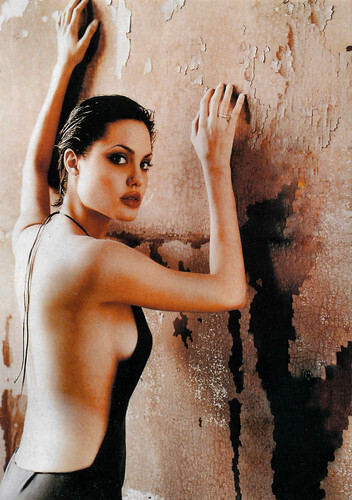
Vintage postcard.
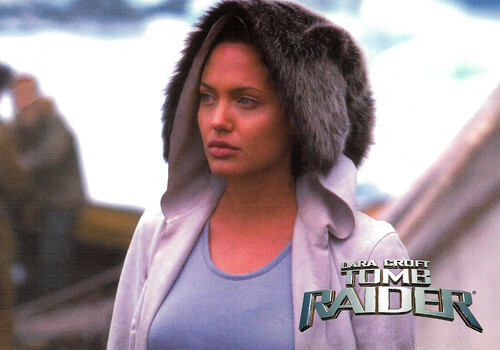
Dutch postcard by Film Freak Productions, Zoetermeer, no. FA 546. Photo: Paramount Pictures Corp. Angelina Jolie in Lara Croft Tomb Raider (2001).
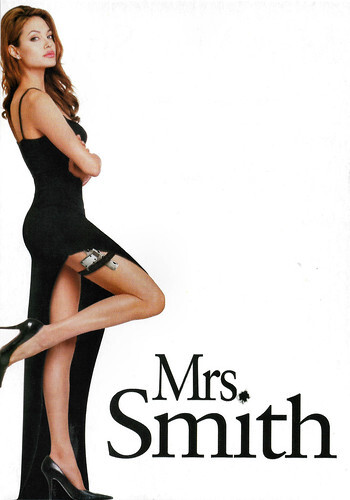
Portugese promotion card by Cinefilos. Photo: Regency / Castello Lopes / 20th Century Fox.Angelina Jolie in Mr. and Mrs. Smith (Doug Liman, 2005).
Girl, Interrupted
Angelina Jolie was born Angelina Jolie Voight in Los Angeles, in 1975. She is the daughter of actors Jon Voight and Marcheline Bertrand, and the sister of director James Haven. When Jolie was six months old, her father left the family and she moved to upstate New York with her mother and brother.
Ten years later the family returned to Los Angeles, where 11-year-old Jolie decided to become an actress and enrolled at the prestigious Lee Strasberg Theatre Institute. Although she had a happy childhood, Jolie became depressed in her teens. In high school, she was bullied by her peers for her thin body and full lips, and she cut herself.
Jolie had no personal contact with her father for many years and had the surname Voight removed from her name in 2002. Jolie and Voight reestablished contact after her mother, with whom Jolie had a very close relationship, died of ovarian cancer in 2007.
After a short-lived career as a fashion model, Jolie began her film career in 1993 with a starring role in the low-budget film Cyborg 2: Glass Shadow (Michael Schroeder, 1993). Some notable films from this period include her first Hollywood production, Hackers (Iain Softley, 1995), where she met her first husband Jonny Lee Miller, and Foxfire (Annette Haywood-Carter, 1996), where she began a relationship with co-star Jenny Shimizu.
In 1998, Jolie won a Golden Globe for her role in the biographical TV Mini-series George Wallace (John Frankenheimer, 1997) starring Gary Sinise. That same year, she played the tragic photo model Gia Marie Carangi in the biographical television film Gia (Michael Cristofer, 1998). Critics praised Jolie's performance as the lesbian, heroin-addicted Carangi; she won a Golden Globe for the second year in a row and her first Screen Actors Guild Award.
She appeared in Playing by Heart (Willard Carroll, 1998), an ensemble production which also starred Sean Connery , Gillian Anderson and Ryan Phillippe. The film in general and Jolie's performance, in particular, were well received. Next, Jolie appeared in Pushing Tin (Mike Newell, 1999) as the seductive wife of Billy Bob Thornton, whom she would marry the following year.
Jolie then worked with Denzel Washington in the crime film The Bone Collector (Phillip Noyce, 1999). The film grossed $151 million worldwide but received poor reviews. Jolie also played the psychopathic Lisa Rowe in the biographical film Girl, Interrupted (James Mangold, 1999) with Winona Ryder . Girl, Interrupted marked Jolie's breakthrough in Hollywood and she won her third Golden Globe, her second Screen Actors Guild Award, and an Academy Award for Best Supporting Actress for her performance.
The summer of that year saw the release of her first blockbuster, Gone in 60 Seconds (Dominic Sena, 2000), in which she played the ex-girlfriend of car thief Nicolas Cage. The film brought in $237 million internationally, making it her best-attended film to that point.
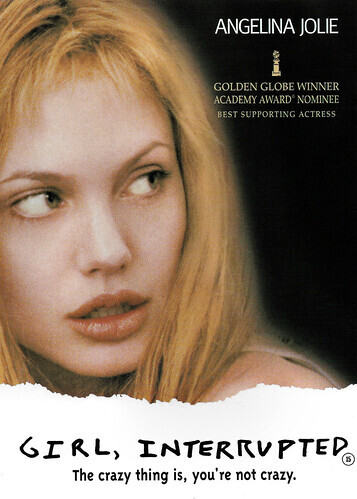
British freecard by Boomerang Media. Angelina Jolie in Girl, Interrupted (James Mangold, 1999). Caption: The crazy thing is, you're not crazy.
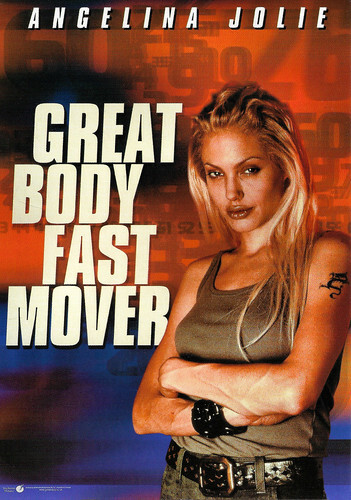
British freecard by Boomerang Media. Photo: Touchstone Pictures. Angelina Jolie in Gone in 60 Seconds (Dominic Sena, 2000).
Lara Croft
Angelina Jolie achieved international superstar status with her role as video game heroine Lara Croft in Lara Croft: Tomb Raider (Simon West, 2001) opposite her father, Jon Voight. Although Jolie was widely praised for her physical performance, the film received mainly negative reviews. The film was nevertheless an international success with sales of $275 million and launched her global reputation as a female action film star.
Jolie appeared as Antonio Banderas ' sensual but deceitful mail-order bride in Original Sin (Michael Cristofer, 2001). In 2002, she played an ambitious journalist who is told she will die within a week in Life or Something Like It (Stephen Herek, 2002). Both films received poor reviews, but Jolie's performance was again well received by critics.
In 2003, Jolie reprised her role as Lara Croft in Lara Croft Tomb Raider: The Cradle of Life (Jan de Bont, 2003). The sequel, although not as profitable as the original, had international sales of $156 million. Later that year, she appeared opposite Clive Owen in Beyond Borders (Martin Campbell, 2003), a film about development workers in Africa. The film reflected Jolie's interest in development aid but was critically and financially unsuccessful.
In 2004, Jolie appeared alongside Ethan Hawke as an FBI agent in the thriller Taking Lives (D.J. Caruso, 2004). She also provided the voice of the fish Lola in the DreamWorks animated film Shark Tale (Bibo Bergeron, Vicky Jenson, Rob Letterman, 2004) and had a supporting role in the Science Fiction/adventure film Sky Captain and the World of Tomorrow (Kerry Conran, 2004) starring Gwyneth Paltrow and Jude Law.
That same year, Jolie played the role of Olympias in Alexander (Oliver Stone, 2004), a biographical film about the life of Alexander the Great played by Colin Farrell. The film was poorly attended in America, which director Oliver Stone attributed to its depiction of Alexander's bisexuality, but was a success internationally with sales of $139 million.
Jolie starred in only one film in 2005, the action-comedy Mr. & Mrs. Smith (Doug Liman, 2005), where she met Brad Pitt . The film, which tells the story of a bored couple who discover that they are both hit men, was one of the biggest successes of 2005, with sales of $478 million worldwide. Jolie then appeared in Robert De Niro 's The Good Shepherd (Robert De Niro, 2006) as the neglected wife of a CIA agent played by Matt Damon.
Jolie next appeared in A Mighty Heart (Michael Winterbottom, 2007) as Mariane Pearl, the widow of murdered journalist Daniel Pearl. For her performance, Jolie received a fourth Golden Globe nomination and a third Screen Actors Guild Award nomination. That same year, Jolie also played the mother of Grendel (Crispin Glover) in the motion-capture-created epic film Beowulf (Robert Zemeckis, 2007). Next, Jolie played the hit woman Fox in the action film Wanted (Timur Bekmambetov, 2008), alongside James McAvoy and Morgan Freeman. The film was well-received by critics and was an international success with sales of $342 million.
She also provided the voice of Tigress in the DreamWorks animated film Kung Fu Panda (Mark Osborne, John Stevenson, 2008), which became her best-selling film to date with sales of $632 million worldwide. That same year, Jolie appeared in Clint Eastwood 's truth-based drama Changeling (Clint Eastwood, 2008), about American Christine Collins (played by Jolie) who is reunited in 1928 not with her kidnapped son but with a boy who had claimed to be her son. Jolie received a second Academy Award nomination, a fifth Golden Globe nomination, and a fourth Screen Actors Guild Award nomination for her role.
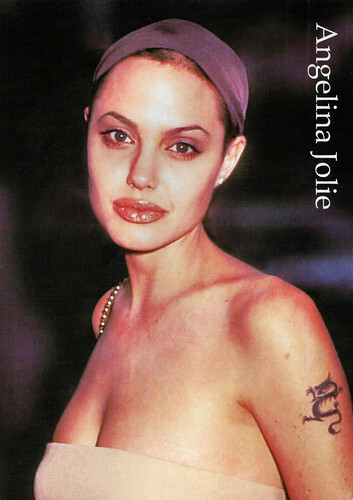
British postcard by Pyramid, Leicester, no. PC9137, 2000.
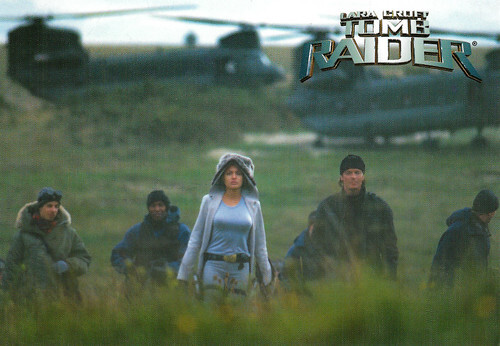
Dutch postcard by Film Freak Productions, Zoetermeer, no. FA 548. Photo: Paramount Pictures Corp. Angelina Jolie in Lara Croft Tomb Raider (2001).
Maleficent
Angelina Jolie's performance as the title character Evelyn Salt in Salt (Phillip Noyce, 2010) had many reviewers calling her the female James Bond. Jolie would provide the voice of Tigress again in the sequel Kung Fu Panda 2 (Jennifer Yuh Nelson, 2011) before taking on her next big hurdle: stepping behind the camera.
Jolie directed and produced the war drama In the Land of Blood and Honey (Angelina Jolie, 2011), a tragic love story that takes place during the Bosnian War. The film's uncompromising depiction of the war atrocities that marked the conflict caused some stir in Bosnia, Serbia, and Croatia, but her choices were largely celebrated by Bosnians, as well as most critics in the U.S. and Europe.
Jolie returned to acting in Disney's Maleficent (Robert Stromberg, 2014), playing the title character. It would prove to be Jolie's biggest live-action hit, passing the box office totals for Mr. & Mrs. Smith, taking in $600 million.
She also continued to direct and produce films including Unbroken (2014), By the Sea (2015), and First They Killed My Father (2017). Recently she starred in the Marvel movie The Eternals (Chloé Zhao, 2021) with Gemma Chan and Richard Madden.
In addition to her acting career, Jolie has been active for the UN refugee agency UNHCR since 2001, first as a Goodwill Ambassador and since 2012 as a Special Envoy. For her efforts, she received an honorary Oscar, the Jean Hersholt Humanitarian Award. She was appointed Dame Commander of the Order of St Michael and St George by Queen Elizabeth II.
After marriages with actors Jonny Lee Miller (1996-1999) and Billy Bob Thornton (2000-2003), Jolie had been in a relationship with actor Brad Pitt since 2004, with whom she has six children. In 2016, the couple separated and Jolie filed for divorce.
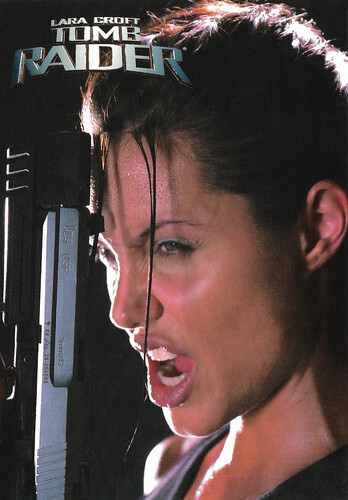
Dutch postcard by Film Freak Productions, Zoetermeer, no. FA 541. Photo: Paramount Pictures Corp. Angelina Jolie in Lara Croft Tomb Raider (2001).
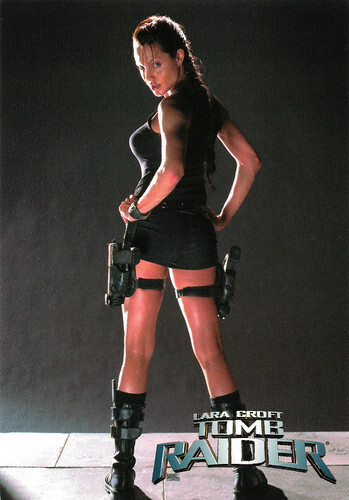
Dutch postcard by Film Freak Productions, Zoetermeer, no. FA 543. Photo: Paramount Pictures Corp. Angelina Jolie in Lara Croft Tomb Raider (Simon West, 2001).
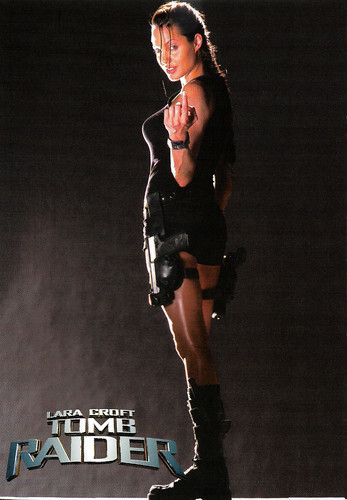
Dutch postcard by Film Freak Productions, Zoetermeer, no. FA 544. Photo: Paramount Pictures Corp. Angelina Jolie in Lara Croft Tomb Raider (Simon West, 2001).
Sources: Rebecca Flint Marx (AllMovie), Wikipedia (Dutch) and .

Vintage postcard.

Dutch postcard by Film Freak Productions, Zoetermeer, no. FA 546. Photo: Paramount Pictures Corp. Angelina Jolie in Lara Croft Tomb Raider (2001).

Portugese promotion card by Cinefilos. Photo: Regency / Castello Lopes / 20th Century Fox.Angelina Jolie in Mr. and Mrs. Smith (Doug Liman, 2005).
Girl, Interrupted
Angelina Jolie was born Angelina Jolie Voight in Los Angeles, in 1975. She is the daughter of actors Jon Voight and Marcheline Bertrand, and the sister of director James Haven. When Jolie was six months old, her father left the family and she moved to upstate New York with her mother and brother.
Ten years later the family returned to Los Angeles, where 11-year-old Jolie decided to become an actress and enrolled at the prestigious Lee Strasberg Theatre Institute. Although she had a happy childhood, Jolie became depressed in her teens. In high school, she was bullied by her peers for her thin body and full lips, and she cut herself.
Jolie had no personal contact with her father for many years and had the surname Voight removed from her name in 2002. Jolie and Voight reestablished contact after her mother, with whom Jolie had a very close relationship, died of ovarian cancer in 2007.
After a short-lived career as a fashion model, Jolie began her film career in 1993 with a starring role in the low-budget film Cyborg 2: Glass Shadow (Michael Schroeder, 1993). Some notable films from this period include her first Hollywood production, Hackers (Iain Softley, 1995), where she met her first husband Jonny Lee Miller, and Foxfire (Annette Haywood-Carter, 1996), where she began a relationship with co-star Jenny Shimizu.
In 1998, Jolie won a Golden Globe for her role in the biographical TV Mini-series George Wallace (John Frankenheimer, 1997) starring Gary Sinise. That same year, she played the tragic photo model Gia Marie Carangi in the biographical television film Gia (Michael Cristofer, 1998). Critics praised Jolie's performance as the lesbian, heroin-addicted Carangi; she won a Golden Globe for the second year in a row and her first Screen Actors Guild Award.
She appeared in Playing by Heart (Willard Carroll, 1998), an ensemble production which also starred Sean Connery , Gillian Anderson and Ryan Phillippe. The film in general and Jolie's performance, in particular, were well received. Next, Jolie appeared in Pushing Tin (Mike Newell, 1999) as the seductive wife of Billy Bob Thornton, whom she would marry the following year.
Jolie then worked with Denzel Washington in the crime film The Bone Collector (Phillip Noyce, 1999). The film grossed $151 million worldwide but received poor reviews. Jolie also played the psychopathic Lisa Rowe in the biographical film Girl, Interrupted (James Mangold, 1999) with Winona Ryder . Girl, Interrupted marked Jolie's breakthrough in Hollywood and she won her third Golden Globe, her second Screen Actors Guild Award, and an Academy Award for Best Supporting Actress for her performance.
The summer of that year saw the release of her first blockbuster, Gone in 60 Seconds (Dominic Sena, 2000), in which she played the ex-girlfriend of car thief Nicolas Cage. The film brought in $237 million internationally, making it her best-attended film to that point.

British freecard by Boomerang Media. Angelina Jolie in Girl, Interrupted (James Mangold, 1999). Caption: The crazy thing is, you're not crazy.

British freecard by Boomerang Media. Photo: Touchstone Pictures. Angelina Jolie in Gone in 60 Seconds (Dominic Sena, 2000).
Lara Croft
Angelina Jolie achieved international superstar status with her role as video game heroine Lara Croft in Lara Croft: Tomb Raider (Simon West, 2001) opposite her father, Jon Voight. Although Jolie was widely praised for her physical performance, the film received mainly negative reviews. The film was nevertheless an international success with sales of $275 million and launched her global reputation as a female action film star.
Jolie appeared as Antonio Banderas ' sensual but deceitful mail-order bride in Original Sin (Michael Cristofer, 2001). In 2002, she played an ambitious journalist who is told she will die within a week in Life or Something Like It (Stephen Herek, 2002). Both films received poor reviews, but Jolie's performance was again well received by critics.
In 2003, Jolie reprised her role as Lara Croft in Lara Croft Tomb Raider: The Cradle of Life (Jan de Bont, 2003). The sequel, although not as profitable as the original, had international sales of $156 million. Later that year, she appeared opposite Clive Owen in Beyond Borders (Martin Campbell, 2003), a film about development workers in Africa. The film reflected Jolie's interest in development aid but was critically and financially unsuccessful.
In 2004, Jolie appeared alongside Ethan Hawke as an FBI agent in the thriller Taking Lives (D.J. Caruso, 2004). She also provided the voice of the fish Lola in the DreamWorks animated film Shark Tale (Bibo Bergeron, Vicky Jenson, Rob Letterman, 2004) and had a supporting role in the Science Fiction/adventure film Sky Captain and the World of Tomorrow (Kerry Conran, 2004) starring Gwyneth Paltrow and Jude Law.
That same year, Jolie played the role of Olympias in Alexander (Oliver Stone, 2004), a biographical film about the life of Alexander the Great played by Colin Farrell. The film was poorly attended in America, which director Oliver Stone attributed to its depiction of Alexander's bisexuality, but was a success internationally with sales of $139 million.
Jolie starred in only one film in 2005, the action-comedy Mr. & Mrs. Smith (Doug Liman, 2005), where she met Brad Pitt . The film, which tells the story of a bored couple who discover that they are both hit men, was one of the biggest successes of 2005, with sales of $478 million worldwide. Jolie then appeared in Robert De Niro 's The Good Shepherd (Robert De Niro, 2006) as the neglected wife of a CIA agent played by Matt Damon.
Jolie next appeared in A Mighty Heart (Michael Winterbottom, 2007) as Mariane Pearl, the widow of murdered journalist Daniel Pearl. For her performance, Jolie received a fourth Golden Globe nomination and a third Screen Actors Guild Award nomination. That same year, Jolie also played the mother of Grendel (Crispin Glover) in the motion-capture-created epic film Beowulf (Robert Zemeckis, 2007). Next, Jolie played the hit woman Fox in the action film Wanted (Timur Bekmambetov, 2008), alongside James McAvoy and Morgan Freeman. The film was well-received by critics and was an international success with sales of $342 million.
She also provided the voice of Tigress in the DreamWorks animated film Kung Fu Panda (Mark Osborne, John Stevenson, 2008), which became her best-selling film to date with sales of $632 million worldwide. That same year, Jolie appeared in Clint Eastwood 's truth-based drama Changeling (Clint Eastwood, 2008), about American Christine Collins (played by Jolie) who is reunited in 1928 not with her kidnapped son but with a boy who had claimed to be her son. Jolie received a second Academy Award nomination, a fifth Golden Globe nomination, and a fourth Screen Actors Guild Award nomination for her role.

British postcard by Pyramid, Leicester, no. PC9137, 2000.

Dutch postcard by Film Freak Productions, Zoetermeer, no. FA 548. Photo: Paramount Pictures Corp. Angelina Jolie in Lara Croft Tomb Raider (2001).
Maleficent
Angelina Jolie's performance as the title character Evelyn Salt in Salt (Phillip Noyce, 2010) had many reviewers calling her the female James Bond. Jolie would provide the voice of Tigress again in the sequel Kung Fu Panda 2 (Jennifer Yuh Nelson, 2011) before taking on her next big hurdle: stepping behind the camera.
Jolie directed and produced the war drama In the Land of Blood and Honey (Angelina Jolie, 2011), a tragic love story that takes place during the Bosnian War. The film's uncompromising depiction of the war atrocities that marked the conflict caused some stir in Bosnia, Serbia, and Croatia, but her choices were largely celebrated by Bosnians, as well as most critics in the U.S. and Europe.
Jolie returned to acting in Disney's Maleficent (Robert Stromberg, 2014), playing the title character. It would prove to be Jolie's biggest live-action hit, passing the box office totals for Mr. & Mrs. Smith, taking in $600 million.
She also continued to direct and produce films including Unbroken (2014), By the Sea (2015), and First They Killed My Father (2017). Recently she starred in the Marvel movie The Eternals (Chloé Zhao, 2021) with Gemma Chan and Richard Madden.
In addition to her acting career, Jolie has been active for the UN refugee agency UNHCR since 2001, first as a Goodwill Ambassador and since 2012 as a Special Envoy. For her efforts, she received an honorary Oscar, the Jean Hersholt Humanitarian Award. She was appointed Dame Commander of the Order of St Michael and St George by Queen Elizabeth II.
After marriages with actors Jonny Lee Miller (1996-1999) and Billy Bob Thornton (2000-2003), Jolie had been in a relationship with actor Brad Pitt since 2004, with whom she has six children. In 2016, the couple separated and Jolie filed for divorce.

Dutch postcard by Film Freak Productions, Zoetermeer, no. FA 541. Photo: Paramount Pictures Corp. Angelina Jolie in Lara Croft Tomb Raider (2001).

Dutch postcard by Film Freak Productions, Zoetermeer, no. FA 543. Photo: Paramount Pictures Corp. Angelina Jolie in Lara Croft Tomb Raider (Simon West, 2001).

Dutch postcard by Film Freak Productions, Zoetermeer, no. FA 544. Photo: Paramount Pictures Corp. Angelina Jolie in Lara Croft Tomb Raider (Simon West, 2001).
Sources: Rebecca Flint Marx (AllMovie), Wikipedia (Dutch) and .
Published on August 18, 2022 22:00
August 17, 2022
Alien Resurrection (1997)
Alien: Resurrection (1997) is an American Science Fiction film, the third sequel to Alien (1979). 200 years after her death, Ellen Ripley is revived as a powerful human/alien hybrid clone. Along with a crew of space pirates, she must again battle the deadly aliens and stop them from reaching Earth. The film was directed by Frenchman Jean-Pierre Jeunet. The leads are played by Sigourney Weaver, Winona Ryder, Ron Perlman, and Dominique Pinon.

Vintage postcard in the Movie's Images series, no. 54. Sigourney Weaver in Alien - Resurrection (Jean-Pierre Jeunet, 1997).
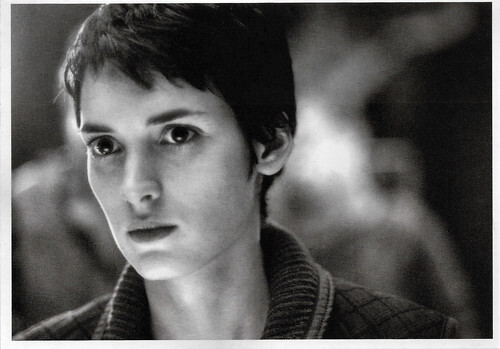
Vintage postcard in the Movie's Images series, no. 53. Winona Ryder in Alien - Resurrection (Jean-Pierre Jeunet, 1997).
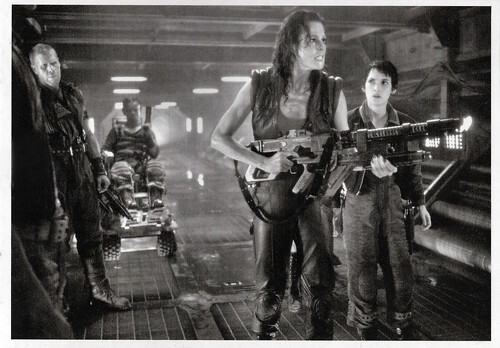
Vintage postcard in the Movie's Images series, no. 52. Ron Perlman, Dominique Pinon, Sigourney Weaver , and Winona Ryder in Alien - Resurrection (Jean-Pierre Jeunet, 1997).
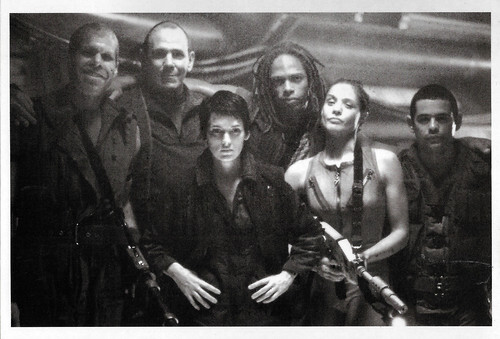
Vintage postcard in the Movie's Images series, no. 51. Sigourney Weaver in Alien - Resurrection (Jean-Pierre Jeunet, 1997).
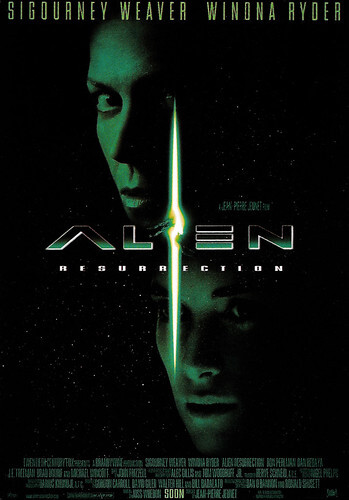
Dutch postcard by Film Freak Productions, Zoetermeer, no. FA 461, 1997. Photo: Twentieth Century Fox Film Corporation. Poster image of Alien - Resurrection (Jean-Pierre Jeunet, 1997) with Sigourney Weaver and Winona Ryder .
The new Aliens prove smarter than usual
Alien: Resurrection (1997) is set 200 years after the events of Alien³. Using blood samples, a group of scientists aboard the USM Auriga creates a clone of Ellen Ripley ( Sigourney Weaver ). The scientists work for the company United Systems Military, a kind of successor of Weyland-Yutani from the previous films. Like its predecessor, this company has set its sights on using the Aliens as a biological weapon.
Since Ripley was carrying the embryo of an Alien queen when she died, the scientists hope to obtain such an Alien embryo by cloning it. The plan succeeds and an Alien queen is extracted from the Ripley clone. The clone itself is kept alive for further research, while a nest of Aliens is created through the Alien Queen with a series of hosts kidnapped by smugglers for the first time in two centuries.
The smugglers find Ripley aboard the ship. The youngest member of the group, Call ( Winona Ryder ), recognises her name. Meanwhile, the new Aliens prove smarter than usual. Soon they escape and pose a threat to everyone aboard the Auriga. Most of the people on board are killed.
Ripley and scientist Dr. Wren (J.E. Freeman) realise that the Auriga is programmed to return to Earth. When the ship arrives there, the aliens will be released on the planet. Ripley, now with part alien DNA and superhuman powers, tries to escape with the smugglers of the spaceship before it reaches Earth.
During their escape, Ripley discovers more about the Aliens; for example, the new Alien Queen has part of her human DNA and is now able to produce living offspring without the need for eggs. The Aliens thus created see Ripley as their mother.
Eventually, Call turns out to be an android. She can break into the Auriga's computer system and programs the ship to crash into Earth in the hope that the crash will kill all the aliens. Just before the impact, Ripley and the last smugglers are able to escape with another ship.
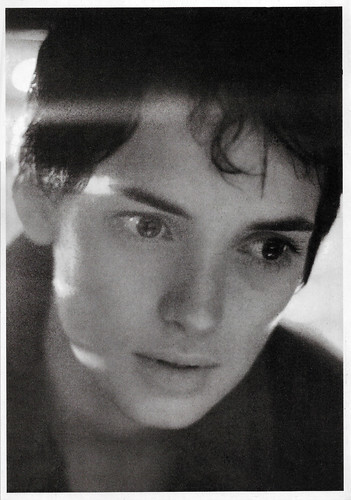
Vintage postcard in the Movie's Images series, no. 50. Winona Ryder in Alien - Resurrection (Jean-Pierre Jeunet, 1997).
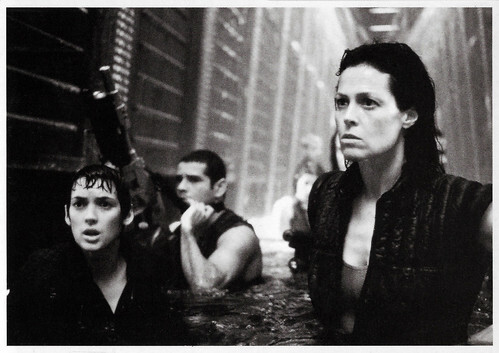
Vintage postcard in the Movie's Images series, no. 55. Winona Ryder and Sigourney Weaver in Alien - Resurrection (Jean-Pierre Jeunet, 1997).
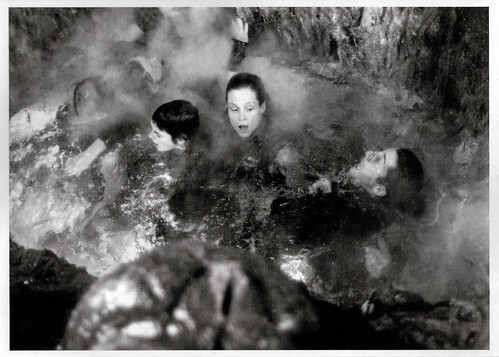
Winona Ryder Vintage postcard in the Movie's Images series, no. 56. Winona Ryder , Sigourney Weaver and Leland Orser in Alien - Resurrection (Jean-Pierre Jeunet, 1997).
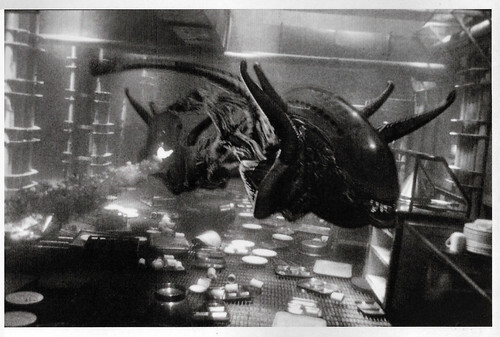
Vintage postcard in the Movie's Images series, no. 57. Publicity still for Alien - Resurrection (Jean-Pierre Jeunet, 1997).
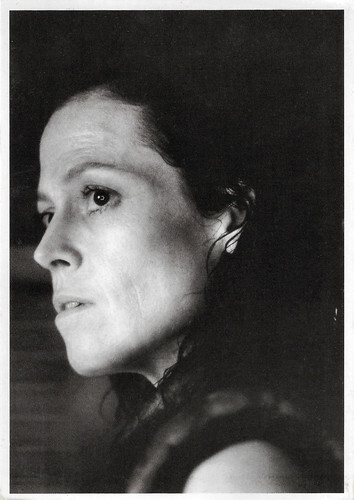
Vintage postcard in the Movie's Images series, no. 59. Sigourney Weaver in Alien - Resurrection (Jean-Pierre Jeunet, 1997).
Resurrecting Ripley
20th Century Fox hired Joss Whedon to write the script for Alien: Resurrection as they were impressed with his previous work. Initially, Fox wanted the film to revolve around a clone of the Newt character from Aliens (James Cameron, 1987). Whedon wrote a short script around this idea when Fox decided to try to have Ellen Ripley return in the film.
At first, it was a bit of a mystery how to make an Alien 4, as Ripley died in the previous film, Alien³ (David Fincher, 1992). In the 1990s, cloning was in the spotlight, and that became the basis for the resurrection of Ripley and the xenomorph. Whedon personally found it difficult to incorporate Ripley's return into the script.
Sigourney Weaver , who had played Ripley in all the previous films, initially saw nothing in yet another return of her character. She felt it would be too much of the same. However, she was so impressed by Whedon's script that she agreed to play the role again. It was her idea to give her character some new characteristics, such as the Alien DNA. Weaver also gained mention as a co-producer and an $11 million salary as a result of her input.
Amalgamated Dynamics Incorporated (ADI) was hired to provide the effects for the film, and to design the Aliens for the film. In the previous Alien sequels, H.R. Giger's original Alien (Ridley Scott, 1986) design had already been reworked, for example, the creatures in Aliens (James Cameron, 1987) had a ribbed skull roof (in the previous film it was smooth), the chestburster had arms and the eggs looked different. In Alien³, they went a step further, turning the Alien into a reddish-brown, lightning-fast quadruped.
For the fourth instalment in the series, some changes were made again. In the past, the legs of the aliens were never shown, because in terms of joints they were clearly human. Because in 1997 the computer was now available, digital Aliens could be fully portrayed. To give them a more animal-like appearance, an extra joint was added to the ankle. The tail was also made flatter, as a paddle for the swimming scenes in the film. The old hissing and screeching noises were replaced by growling and roaring, and the Alien eggs were made much more mobile. The appearance of the eggs was brought back to that of the original Alien.
Alien: Resurrection was shot at Fox Studios in Los Angeles. Filming lasted from October 1996 to February 1997. Jeunet had difficulty finding a studio as the production of Alien: Resurrection coincided with several other films such as Titanic (James Cameron, 1997), Starship Troopers (Paul Verhoeven, 1997) and The Lost World: Jurassic Park (Steven Spielberg, 1997).
Jeunet wanted to emphasise Ripley's new powers, including in a scene where Ripley throws a basketball through the net in a gym without looking. This shot is real. Sigourney Weaver insisted on doing it herself, though it was said to be almost impossible to do without a machine or digital ball. When it was done, actor Ron Perlman was so impressed that he started cursing in amazement while the camera was still rolling. This 'character break' could be cut out without losing the scene.
Alien: Resurrection officially premiered on 26 November 1997 after a preview in Camarillo, California. In North America, the film grossed $47.7 million, making it the least successful film in the franchise in America. Internationally, the film did better. Its worldwide box office was $161.2 million. Like Alien 3, Alien: Resurrection was met with mixed reviews.
Roger Ebert in The Chicago Sun-Times: "The 'Alien' movies always have expert production design. Alien Resurrection was directed by the French visionary Jean-Pierre Jeunet (City of Lost Children), who with his designers has placed it in what looks like a large, empty hangar filled with prefabricated steel warehouse parts. There is not a single shot in the movie to fill one with wonder - nothing like the abandoned planetary station in Aliens. Even the standard shots of vast spaceships, moving against a backdrop of stars, are murky here, and perfunctory."
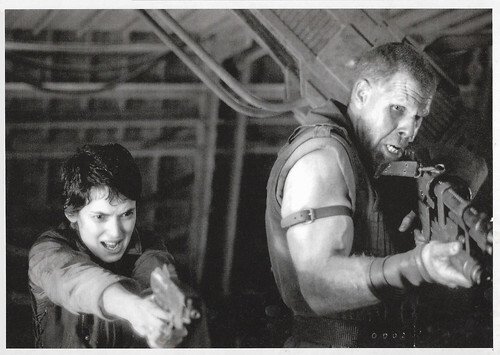
Vintage postcard in the Movie's Images series, no. 60. Winona Ryder and Ron Perlman in Alien - Resurrection (Jean-Pierre Jeunet, 1997).
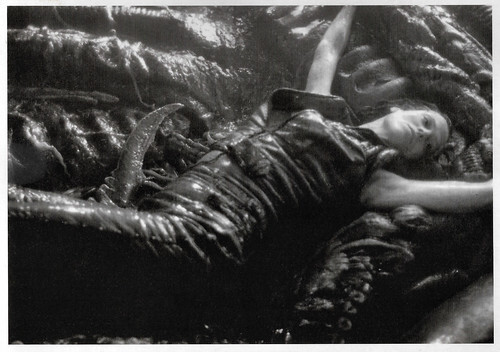
Vintage postcard in the Movie's Images series, no. 63. Sigourney Weaver in Alien - Resurrection (Jean-Pierre Jeunet, 1997).
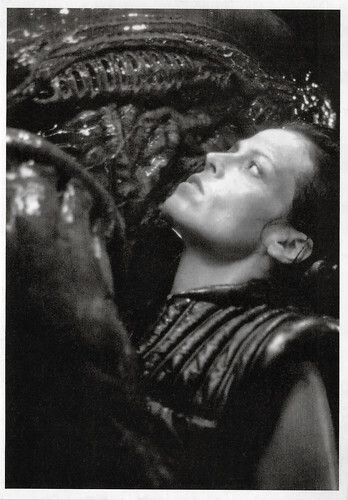
Vintage postcard in the Movie's Images series, no. 64. Sigourney Weaver in Alien - Resurrection (Jean-Pierre Jeunet, 1997).
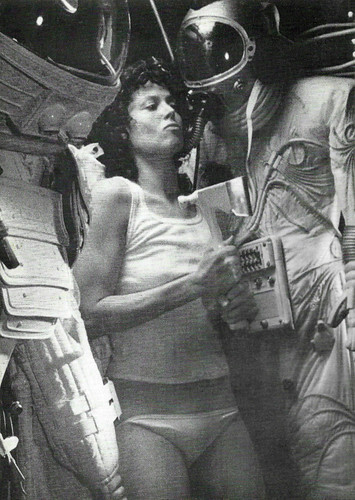
British postcard in the Mini Series by Lilliput Production, London, no. 505. Sigourney Weaver in Alien (Ridley Scott, 1979).
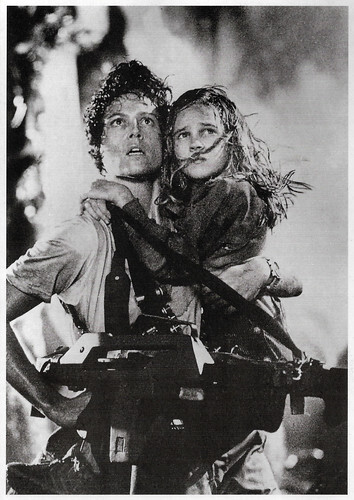
Canadian postcard by Canadian Postcard, no. A-433. Sigourney Weaver and Carrie Henn in Aliens (James Cameron, 1996).
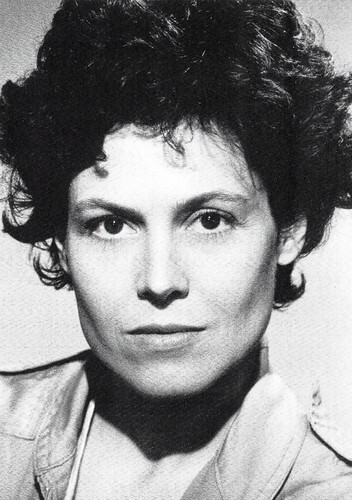
British postcard in the Mini Series by Lilliput Production, London, no. 502.
Sources: Roger Ebert (RogerEbert.com), Wikipedia (Dutch), and IMDb.

Vintage postcard in the Movie's Images series, no. 54. Sigourney Weaver in Alien - Resurrection (Jean-Pierre Jeunet, 1997).

Vintage postcard in the Movie's Images series, no. 53. Winona Ryder in Alien - Resurrection (Jean-Pierre Jeunet, 1997).

Vintage postcard in the Movie's Images series, no. 52. Ron Perlman, Dominique Pinon, Sigourney Weaver , and Winona Ryder in Alien - Resurrection (Jean-Pierre Jeunet, 1997).

Vintage postcard in the Movie's Images series, no. 51. Sigourney Weaver in Alien - Resurrection (Jean-Pierre Jeunet, 1997).

Dutch postcard by Film Freak Productions, Zoetermeer, no. FA 461, 1997. Photo: Twentieth Century Fox Film Corporation. Poster image of Alien - Resurrection (Jean-Pierre Jeunet, 1997) with Sigourney Weaver and Winona Ryder .
The new Aliens prove smarter than usual
Alien: Resurrection (1997) is set 200 years after the events of Alien³. Using blood samples, a group of scientists aboard the USM Auriga creates a clone of Ellen Ripley ( Sigourney Weaver ). The scientists work for the company United Systems Military, a kind of successor of Weyland-Yutani from the previous films. Like its predecessor, this company has set its sights on using the Aliens as a biological weapon.
Since Ripley was carrying the embryo of an Alien queen when she died, the scientists hope to obtain such an Alien embryo by cloning it. The plan succeeds and an Alien queen is extracted from the Ripley clone. The clone itself is kept alive for further research, while a nest of Aliens is created through the Alien Queen with a series of hosts kidnapped by smugglers for the first time in two centuries.
The smugglers find Ripley aboard the ship. The youngest member of the group, Call ( Winona Ryder ), recognises her name. Meanwhile, the new Aliens prove smarter than usual. Soon they escape and pose a threat to everyone aboard the Auriga. Most of the people on board are killed.
Ripley and scientist Dr. Wren (J.E. Freeman) realise that the Auriga is programmed to return to Earth. When the ship arrives there, the aliens will be released on the planet. Ripley, now with part alien DNA and superhuman powers, tries to escape with the smugglers of the spaceship before it reaches Earth.
During their escape, Ripley discovers more about the Aliens; for example, the new Alien Queen has part of her human DNA and is now able to produce living offspring without the need for eggs. The Aliens thus created see Ripley as their mother.
Eventually, Call turns out to be an android. She can break into the Auriga's computer system and programs the ship to crash into Earth in the hope that the crash will kill all the aliens. Just before the impact, Ripley and the last smugglers are able to escape with another ship.

Vintage postcard in the Movie's Images series, no. 50. Winona Ryder in Alien - Resurrection (Jean-Pierre Jeunet, 1997).

Vintage postcard in the Movie's Images series, no. 55. Winona Ryder and Sigourney Weaver in Alien - Resurrection (Jean-Pierre Jeunet, 1997).

Winona Ryder Vintage postcard in the Movie's Images series, no. 56. Winona Ryder , Sigourney Weaver and Leland Orser in Alien - Resurrection (Jean-Pierre Jeunet, 1997).

Vintage postcard in the Movie's Images series, no. 57. Publicity still for Alien - Resurrection (Jean-Pierre Jeunet, 1997).

Vintage postcard in the Movie's Images series, no. 59. Sigourney Weaver in Alien - Resurrection (Jean-Pierre Jeunet, 1997).
Resurrecting Ripley
20th Century Fox hired Joss Whedon to write the script for Alien: Resurrection as they were impressed with his previous work. Initially, Fox wanted the film to revolve around a clone of the Newt character from Aliens (James Cameron, 1987). Whedon wrote a short script around this idea when Fox decided to try to have Ellen Ripley return in the film.
At first, it was a bit of a mystery how to make an Alien 4, as Ripley died in the previous film, Alien³ (David Fincher, 1992). In the 1990s, cloning was in the spotlight, and that became the basis for the resurrection of Ripley and the xenomorph. Whedon personally found it difficult to incorporate Ripley's return into the script.
Sigourney Weaver , who had played Ripley in all the previous films, initially saw nothing in yet another return of her character. She felt it would be too much of the same. However, she was so impressed by Whedon's script that she agreed to play the role again. It was her idea to give her character some new characteristics, such as the Alien DNA. Weaver also gained mention as a co-producer and an $11 million salary as a result of her input.
Amalgamated Dynamics Incorporated (ADI) was hired to provide the effects for the film, and to design the Aliens for the film. In the previous Alien sequels, H.R. Giger's original Alien (Ridley Scott, 1986) design had already been reworked, for example, the creatures in Aliens (James Cameron, 1987) had a ribbed skull roof (in the previous film it was smooth), the chestburster had arms and the eggs looked different. In Alien³, they went a step further, turning the Alien into a reddish-brown, lightning-fast quadruped.
For the fourth instalment in the series, some changes were made again. In the past, the legs of the aliens were never shown, because in terms of joints they were clearly human. Because in 1997 the computer was now available, digital Aliens could be fully portrayed. To give them a more animal-like appearance, an extra joint was added to the ankle. The tail was also made flatter, as a paddle for the swimming scenes in the film. The old hissing and screeching noises were replaced by growling and roaring, and the Alien eggs were made much more mobile. The appearance of the eggs was brought back to that of the original Alien.
Alien: Resurrection was shot at Fox Studios in Los Angeles. Filming lasted from October 1996 to February 1997. Jeunet had difficulty finding a studio as the production of Alien: Resurrection coincided with several other films such as Titanic (James Cameron, 1997), Starship Troopers (Paul Verhoeven, 1997) and The Lost World: Jurassic Park (Steven Spielberg, 1997).
Jeunet wanted to emphasise Ripley's new powers, including in a scene where Ripley throws a basketball through the net in a gym without looking. This shot is real. Sigourney Weaver insisted on doing it herself, though it was said to be almost impossible to do without a machine or digital ball. When it was done, actor Ron Perlman was so impressed that he started cursing in amazement while the camera was still rolling. This 'character break' could be cut out without losing the scene.
Alien: Resurrection officially premiered on 26 November 1997 after a preview in Camarillo, California. In North America, the film grossed $47.7 million, making it the least successful film in the franchise in America. Internationally, the film did better. Its worldwide box office was $161.2 million. Like Alien 3, Alien: Resurrection was met with mixed reviews.
Roger Ebert in The Chicago Sun-Times: "The 'Alien' movies always have expert production design. Alien Resurrection was directed by the French visionary Jean-Pierre Jeunet (City of Lost Children), who with his designers has placed it in what looks like a large, empty hangar filled with prefabricated steel warehouse parts. There is not a single shot in the movie to fill one with wonder - nothing like the abandoned planetary station in Aliens. Even the standard shots of vast spaceships, moving against a backdrop of stars, are murky here, and perfunctory."

Vintage postcard in the Movie's Images series, no. 60. Winona Ryder and Ron Perlman in Alien - Resurrection (Jean-Pierre Jeunet, 1997).

Vintage postcard in the Movie's Images series, no. 63. Sigourney Weaver in Alien - Resurrection (Jean-Pierre Jeunet, 1997).

Vintage postcard in the Movie's Images series, no. 64. Sigourney Weaver in Alien - Resurrection (Jean-Pierre Jeunet, 1997).

British postcard in the Mini Series by Lilliput Production, London, no. 505. Sigourney Weaver in Alien (Ridley Scott, 1979).

Canadian postcard by Canadian Postcard, no. A-433. Sigourney Weaver and Carrie Henn in Aliens (James Cameron, 1996).

British postcard in the Mini Series by Lilliput Production, London, no. 502.
Sources: Roger Ebert (RogerEbert.com), Wikipedia (Dutch), and IMDb.
Published on August 17, 2022 22:00
August 16, 2022
Lio
Belgian-Portuguese singer Lio (1962) had a huge success in 1979 in France and Belgium with her song 'Banana Split'. With more than 1 million singles sold, it became one of the most popular hits in French-language music of the 1980s. She had further pop hits with 'Amoureux solitaires' (1980), 'Amicalement votre' (1981) and 'Mona Lisa' (1982). She also appeared in several French films.

French postcard by CO, no. 937. Photo: Tony Frank (Sigma).

French postcard, no. 32. Photo: Tony Frank (Sigma).
The perfect European Electro Pop starlet
Lio was born as Vanda Maria Ribeiro Furtado Tavares de Vasconcelos in 1962 in Mangualde, a small town in Portugal. Her parents were politically left-wing, and Lio has remained true to this social vision. Her parents divorced and, in 1968, Vanda moved with her mother and new stepfather to Brussels, Belgium, where her sister, actress Helena Noguerra, was born.
In her teens, she was determined to become a singer, and she was encouraged by singer-songwriter Jacques Duvall (né Eric Verwilghem), a family friend. She took her stage name, Lio, from a character in the Barbarella comic books by Jean-Claude Forest. Lio is a lolitesque teenager that Barbarella must save from the bad guys.
In 1979, together with songwriter Jay Alanski, she and Duvall began working with Marc Moulin and Dan Lacksman from the electro-trio Telex. According to Dutch Wikipedia, she owed her record deal to the Belgian tax laws, which obliged her music company to take on Belgian artists as well. To the amazement of everyone, including Lio herself, her song 'Banana Split (1979)' became a big hit in Belgium and France.
'The follow-up 'Amoureux solitaires' (1980), a song originally by punk rock band Stinky Toys, also became a hit in the Netherlands. Moulin and Lacksman produced her self-titled first album which established Lio as the perfect European Electro Pop starlet. Other songs like 'Amicalement votre' (1981) and 'Mona Lisa' (1982) also sold well.
Lio has, in her own words, "a voice with a high acidity content". Her repertoire meets this requirement by its lack of sentimentality, which is quite exceptional in French light music. In 1982 the American music duo Ron and Russell Mael, of Sparks, worked with her on the album 'Suite sixtine', on which some of her previous songs were translated into English. In 1985, she met record company executive and producer Michel Esteban, of ZE Records.
She continued to have hit singles in Europe, including 'Les brunes comptent pas pour des prunes', and travelled to Los Angeles with Esteban to record her next album 'Pop model' (1986). Several of the tracks were co-produced by John Cale, formerly of the Velvet Underground, and the album produced the hits 'Fallait pas commencer', 'Je casse tout ce que je touche'. and 'Chauffeur'. Lio performed four days of concerts at the Olympia of Paris and in 1987, she gave birth to Nubia, the first of her six children.
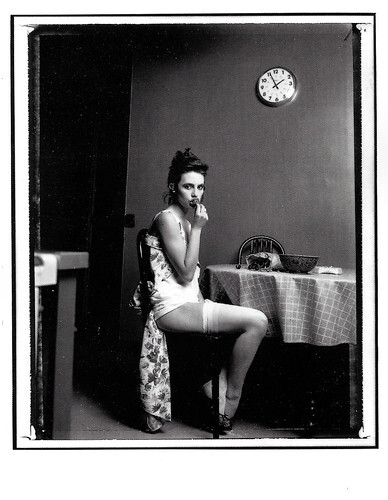
Swiss postcard by News Productions, Baulmes, no. 55959. Photo: Bettina Rheims / Musée de l'Elysée, Lausanne. Caption: Lio et les cérises, 1986.

French postcard by Humour a la Carte, Paris, no. ST-100. Photo: Jean Ber / VU.
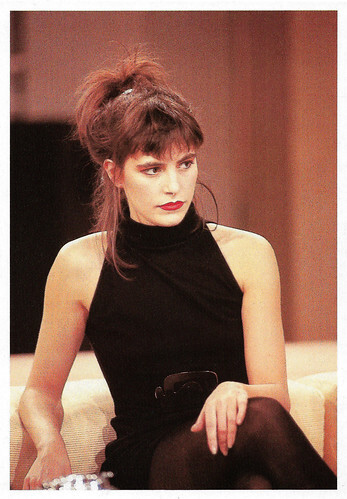
French postcard by Humour a la Carte, Paris, no. ST-145. Photo: Marie France Laval.
Getting rid of her babydoll image
Lio entered the film world in 1983. She played a carefree hairdresser in Golden Eighties (Chantal Akerman, 1986), a lighthearted, humorous French pop musical about the people who work together in a Parisian shopping centre. It was followed by the romantic comedy Elsa, Elsa (Didier Haudepin, 1985) with François Cluzet. Then followed Itinéraire d'un enfant gâté/Itinerary of a Spoiled Child (Claude Lelouch, 1988), the last big hit of the career of Jean-Paul Belmondo .
After Lio's album 'Can Can' (1988) flopped, she decided to become a fashion designer. It became a commercial success and from 1988 to 1990 she was allowed to design for Prisunic. In 1990, she stopped designing and resumed making films. She played with Michel Blanc and Jacques Dutronc in the comedy Chambre à part (Jacky Cukier, 1989). Her next films were Jalousie/Jealousy (Kathleen Fonmarty, 1991), the romantic drama Sale come un ange/Dirty Like an Angel (Catherine Breillat, 1991) with Claude Brasseur, and the drama Sans un cri/Without a shout (Jeanne Labrune, 1991).
In Après l'amour (Diane Kurys, 1992) she co-starred with Isabelle Huppert and Bernard Giraudeau . Lio also appeared in various men's magazines, such as the French Playboy. In 1991, she recorded her album 'Des fleurs pour un caméléon' which had little more success than 'Can Can'. Around her 30th birthday, Lio decided that it was time to get rid of her babydoll image, but the studios did not agree. She starred in the Spanish film La Madre muerta/The Dead Mother (Juanma Bajo Ulloa, 1993). the French film Personne ne m'aime (Marion Vernoux, 1994) opposite Bernadette Lafont and Bulle Ogier, and the Spanish-French coproduction Niña de tus sueños (Jesús R. Delgado, 1995).
Her 1996 album 'Wandatta' was more mature, but the general public was not very interested in her new style. Lio's singing career took an unexpected turn in 1999 with her album 'Lio chante Prévert', with classical chansons based on texts by the French literary great Jacques Prévert. The album received good reviews, and earned Lio some significant concerts, in Paris and Spa. In 1999 she also appeared in 50 performances of the French adaptation of 'Seven Brides For Seven Brothers', a musical staged at the Folies Bergère. But her success never became what it was in the 1980s.
In 1999 she divorced her husband, singer Zad and sued him for assault. In 2004, the then 42-year-old Lio published her autobiography 'LIO popmodel' in collaboration with the journalist Gilles Verlant. she released the live album 'Cœur de rubis' in 2004. That year, she also appeared in over 250 performances of the theatre play 'Le Bébé', an adaptation of a book by Marie Darrieussecq staged by Marc Goldberg. She also continued to appear in films such as Pas douce/A Parting Shot (Jeanne Waltz, 2007), Une vieille maîtresse/The Last Mistress (Catherine Breillat, 2007) with Asia Argento, and La robe du soir/The evening dress (Myriam Aziza, 2009).
Since 2008, Lio has been a judge on the French "pop idol" show Nouvelle Star. In 2009, she returned to music with the rock band Phantom. In 2011, she became a judge on another TV show, The Voice Belgique. In the following years, several of Lio's songs, like 'Mona Lisa' (1982) have been rediscovered and used as samples in songs by artists in the Nu-disco, House and EDM genres. Later films include Un poison violent/Love like poison (Katell Quillévéré, 2010) with Michel Galabru , Stars 80 (Frédéric Forestier, Thomas Langmann, 2012) with Richard Anconina, and the TV film Elle m'a sauvée/She saved me (Ionut Teianu, 2022). Her most recent album is 'Lio canta Caymmi' (2018). It consists of half-Portuguese, half-French covers of songs by the Brazilian composer Dorival Caymmi. It was the first time she recorded an entire album in Portuguese, her mother tongue. Lio has six children.
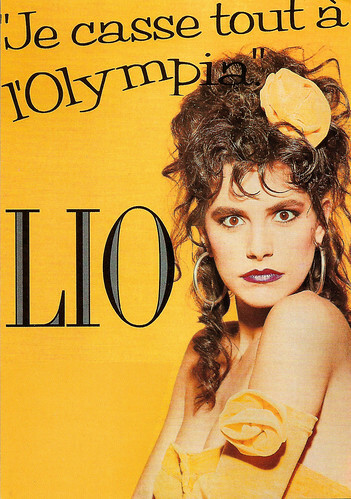
French postcard by Media Com +, no. Record 111. Caption: Je casse tout à L'Olympia (I break everything at the Olympia).
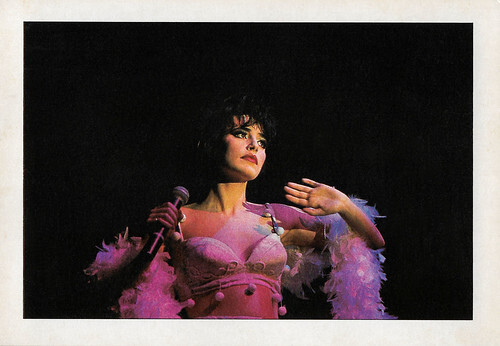
French postcard by Editions NLS, Paris, no. A-6. Caption: Lio en concert à L'Olympia.
Sources: ZE Records, Wikipedia (Dutch and English), and .

French postcard by CO, no. 937. Photo: Tony Frank (Sigma).

French postcard, no. 32. Photo: Tony Frank (Sigma).
The perfect European Electro Pop starlet
Lio was born as Vanda Maria Ribeiro Furtado Tavares de Vasconcelos in 1962 in Mangualde, a small town in Portugal. Her parents were politically left-wing, and Lio has remained true to this social vision. Her parents divorced and, in 1968, Vanda moved with her mother and new stepfather to Brussels, Belgium, where her sister, actress Helena Noguerra, was born.
In her teens, she was determined to become a singer, and she was encouraged by singer-songwriter Jacques Duvall (né Eric Verwilghem), a family friend. She took her stage name, Lio, from a character in the Barbarella comic books by Jean-Claude Forest. Lio is a lolitesque teenager that Barbarella must save from the bad guys.
In 1979, together with songwriter Jay Alanski, she and Duvall began working with Marc Moulin and Dan Lacksman from the electro-trio Telex. According to Dutch Wikipedia, she owed her record deal to the Belgian tax laws, which obliged her music company to take on Belgian artists as well. To the amazement of everyone, including Lio herself, her song 'Banana Split (1979)' became a big hit in Belgium and France.
'The follow-up 'Amoureux solitaires' (1980), a song originally by punk rock band Stinky Toys, also became a hit in the Netherlands. Moulin and Lacksman produced her self-titled first album which established Lio as the perfect European Electro Pop starlet. Other songs like 'Amicalement votre' (1981) and 'Mona Lisa' (1982) also sold well.
Lio has, in her own words, "a voice with a high acidity content". Her repertoire meets this requirement by its lack of sentimentality, which is quite exceptional in French light music. In 1982 the American music duo Ron and Russell Mael, of Sparks, worked with her on the album 'Suite sixtine', on which some of her previous songs were translated into English. In 1985, she met record company executive and producer Michel Esteban, of ZE Records.
She continued to have hit singles in Europe, including 'Les brunes comptent pas pour des prunes', and travelled to Los Angeles with Esteban to record her next album 'Pop model' (1986). Several of the tracks were co-produced by John Cale, formerly of the Velvet Underground, and the album produced the hits 'Fallait pas commencer', 'Je casse tout ce que je touche'. and 'Chauffeur'. Lio performed four days of concerts at the Olympia of Paris and in 1987, she gave birth to Nubia, the first of her six children.

Swiss postcard by News Productions, Baulmes, no. 55959. Photo: Bettina Rheims / Musée de l'Elysée, Lausanne. Caption: Lio et les cérises, 1986.

French postcard by Humour a la Carte, Paris, no. ST-100. Photo: Jean Ber / VU.

French postcard by Humour a la Carte, Paris, no. ST-145. Photo: Marie France Laval.
Getting rid of her babydoll image
Lio entered the film world in 1983. She played a carefree hairdresser in Golden Eighties (Chantal Akerman, 1986), a lighthearted, humorous French pop musical about the people who work together in a Parisian shopping centre. It was followed by the romantic comedy Elsa, Elsa (Didier Haudepin, 1985) with François Cluzet. Then followed Itinéraire d'un enfant gâté/Itinerary of a Spoiled Child (Claude Lelouch, 1988), the last big hit of the career of Jean-Paul Belmondo .
After Lio's album 'Can Can' (1988) flopped, she decided to become a fashion designer. It became a commercial success and from 1988 to 1990 she was allowed to design for Prisunic. In 1990, she stopped designing and resumed making films. She played with Michel Blanc and Jacques Dutronc in the comedy Chambre à part (Jacky Cukier, 1989). Her next films were Jalousie/Jealousy (Kathleen Fonmarty, 1991), the romantic drama Sale come un ange/Dirty Like an Angel (Catherine Breillat, 1991) with Claude Brasseur, and the drama Sans un cri/Without a shout (Jeanne Labrune, 1991).
In Après l'amour (Diane Kurys, 1992) she co-starred with Isabelle Huppert and Bernard Giraudeau . Lio also appeared in various men's magazines, such as the French Playboy. In 1991, she recorded her album 'Des fleurs pour un caméléon' which had little more success than 'Can Can'. Around her 30th birthday, Lio decided that it was time to get rid of her babydoll image, but the studios did not agree. She starred in the Spanish film La Madre muerta/The Dead Mother (Juanma Bajo Ulloa, 1993). the French film Personne ne m'aime (Marion Vernoux, 1994) opposite Bernadette Lafont and Bulle Ogier, and the Spanish-French coproduction Niña de tus sueños (Jesús R. Delgado, 1995).
Her 1996 album 'Wandatta' was more mature, but the general public was not very interested in her new style. Lio's singing career took an unexpected turn in 1999 with her album 'Lio chante Prévert', with classical chansons based on texts by the French literary great Jacques Prévert. The album received good reviews, and earned Lio some significant concerts, in Paris and Spa. In 1999 she also appeared in 50 performances of the French adaptation of 'Seven Brides For Seven Brothers', a musical staged at the Folies Bergère. But her success never became what it was in the 1980s.
In 1999 she divorced her husband, singer Zad and sued him for assault. In 2004, the then 42-year-old Lio published her autobiography 'LIO popmodel' in collaboration with the journalist Gilles Verlant. she released the live album 'Cœur de rubis' in 2004. That year, she also appeared in over 250 performances of the theatre play 'Le Bébé', an adaptation of a book by Marie Darrieussecq staged by Marc Goldberg. She also continued to appear in films such as Pas douce/A Parting Shot (Jeanne Waltz, 2007), Une vieille maîtresse/The Last Mistress (Catherine Breillat, 2007) with Asia Argento, and La robe du soir/The evening dress (Myriam Aziza, 2009).
Since 2008, Lio has been a judge on the French "pop idol" show Nouvelle Star. In 2009, she returned to music with the rock band Phantom. In 2011, she became a judge on another TV show, The Voice Belgique. In the following years, several of Lio's songs, like 'Mona Lisa' (1982) have been rediscovered and used as samples in songs by artists in the Nu-disco, House and EDM genres. Later films include Un poison violent/Love like poison (Katell Quillévéré, 2010) with Michel Galabru , Stars 80 (Frédéric Forestier, Thomas Langmann, 2012) with Richard Anconina, and the TV film Elle m'a sauvée/She saved me (Ionut Teianu, 2022). Her most recent album is 'Lio canta Caymmi' (2018). It consists of half-Portuguese, half-French covers of songs by the Brazilian composer Dorival Caymmi. It was the first time she recorded an entire album in Portuguese, her mother tongue. Lio has six children.

French postcard by Media Com +, no. Record 111. Caption: Je casse tout à L'Olympia (I break everything at the Olympia).

French postcard by Editions NLS, Paris, no. A-6. Caption: Lio en concert à L'Olympia.
Sources: ZE Records, Wikipedia (Dutch and English), and .
Published on August 16, 2022 22:00
August 15, 2022
Oscar Beregi, Sr.
Hungarian stage and film actor Oscar Beregi, Sr. (1876-1965) appeared in 27 European and American films between 1916 and 1953. He is best remembered as Dr. Baum in Fritz Lang’s Das Testament des Dr. Mabuse (1933).
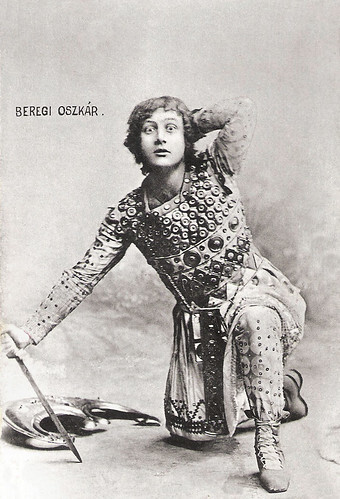
Hungarian postcard by L.D.F., Budapest, Series no. 1343.
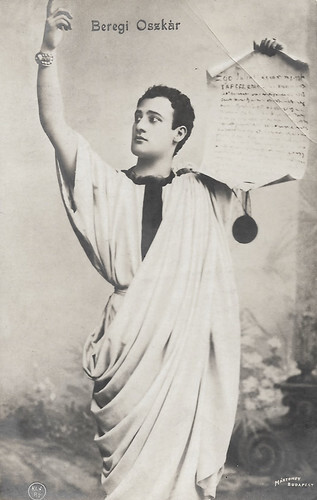
Hungarian postcard by KI.V, Budapest. Photo: Mártoney, Budapest.
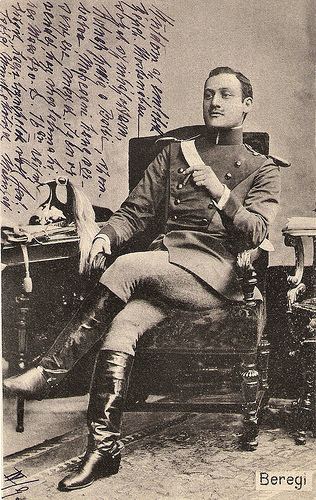
Hungarian postcard by S.S.Bpt., no. 235.
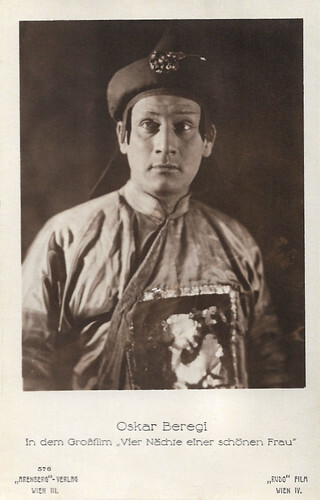
Austrian postcard by Arenberg Verlag, Wien (Vienna), no 576. Photo: Rudo Film, Wien. Oscar Beregi Sr. in Vier Nächte einder schönen Frau/Four nights of a beautiful woman (Josef W. Beyer, 1924).
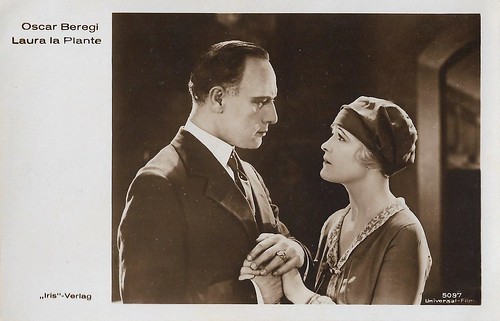
Austrian postcard by Iris-Verlag, no. 5097. Photo: Universal-Film. Laura La Plante and Oscar Beregi in Butterflies in the Rain (Edward Sloman, 1926).
An attack on the aristocracy
Oscar Beregi, Sr. was born Beregi Oszkár or Oszkár Beregi (according to Wikipedia ) or Berger Oszkár (according to IMDb ) in Budapest, Austria-Hungary, in 1876.
In the 1910s, he was the leading actor in the National Theatre in Budapest, and would later perform in plays in Vienna and Berlin.
The sources differ about Beregi’s film debut in 1916. Was it with the lead role in the silent Hungarian production Mire megvénülünk/The time we get old (Ödön Uher ifj., 1916) or with the male lead in Hófehérke/Snowwhite (Márton Garas, 1916) with Ica von Lenkeffy ?
A year later he starred in the drama A Gólyakalifa/The Stork Caliph (Korda Sándor a.k.a. Alexander Korda, 1917), co-starring Gyula Bartos and Judit Bánky. It was the second film made by the legendary director-producer for his newly established Corvin Film company. Korda pulled off what was considered a literary coup by persuading the author Mihály Babits to allow him to film a version of his 1916 novel of the same name.
Two years later, Beregi appeared in another drama by Korda, Ave Caesar! (Alexander Korda, 1919) with Gábor Rajnay and María Corda . The film tells the story of a debauched Habsburg Prince, who sends out one of his aides-de-camp to bring him back a gipsy girl.
Ave Caesar! was considered an attack on the aristocracy. It was made by Korda for the state-owned film industry during the Hungarian Soviet Republic. Once the regime fell later that year Korda was arrested and eventually compelled to leave Hungary as part of the White Terror.
Beregi also worked with another Hungarian who would later become famous in Hollywood, Mihaly Kertész (later known as Michael Curtiz), on the drama Jön az öcsém/My Brother is Coming (Mihaly Kertész, 1919) with Lucy Doraine .
Like many other Hungarian filmmakers, Oscar Beregi, Sr. fled with his family from the Béla-Kun-Regime and moved to Austria. There he appeared as Cesare Borgia in Meriota, die Tänzerin/Neriota – the dancer (Julius Herska, 1922) opposite Maria Mindzenty as Meriota and Nora Gregor as Lucrezia Borgia.
Later he played Amenmeses opposite María Corda in the epic Die Sklavenkönigin/The Moon of Israel (Mihaly Kertész, 1924), produced by Sascha Kolowrat-Krakowsky and Arnold Pressburger. The script was written by Ladislaus Vajda, based on H. Rider Haggard's novel Moon of Israel, which in its turn was inspired by the Biblical story of the Exodus.
The shooting took place in Vienna with about 5,000 extras, in the studios of Sascha-Film, and outdoors on the Laaer Berg. Vienna was touted as 'the Hollywood of Europe,' and the film brought Kertész to the attention of the American studio head Jack Warner. Warner invited Kertész to Hollywood in 1926, where he rapidly became Michael Curtiz and made a career with Warner Studios.
Die Sklavenkönigin was entirely lost for many years, but in 2005 the film was restored and re-copied by the Filmarchiv Austria and presented in the Wiener Metro Kino.
Beregi then starred in the drama Der Fluch/The Curse (Robert Land, 1924). The film marked the screen debut of Lilian Harvey as a young Jewish woman in an Eastern European shtetl, who struggles to reconcile her aspirations with her duty to her family. As her lifestyle grows wilder, her mother is shocked by her immoral behaviour and commits suicide by drowning - repeating ‘the curse’ which has haunted the family for centuries.
He also starred in the Austrian-Polish coproduction Ssanin (Friedrich Feher, 1924) with Magda Sonja and the Jewish production Jiskor (Sidney M. Goldin, 1924) with Maurice Schwartz and Dagny Servaes .
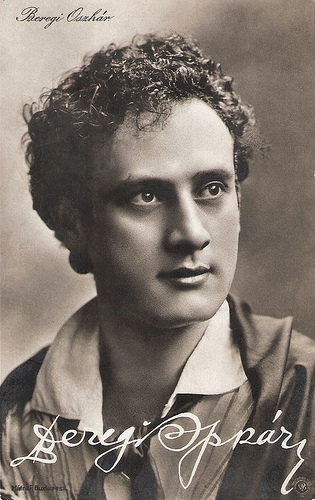
German postcard by NPG. Photo: Mátrai, Budapest.
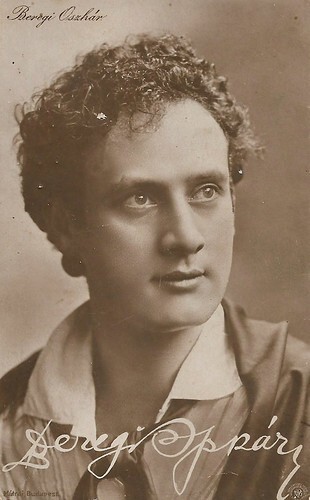
Hungarian postcard. NPG (Neue Photographische Gesellschaft). Photo: Matrai, Budapest.
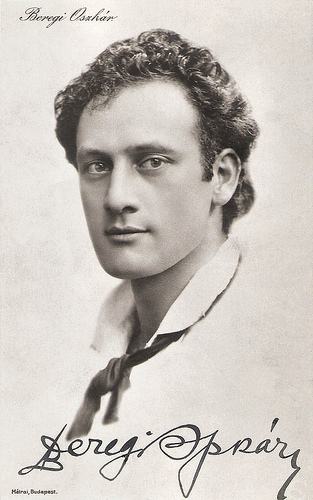
Hungarian postcard. Photo: Mátrai, Budapest.
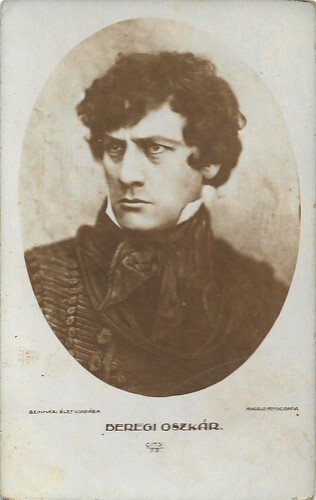
Hungarian postcard by Színházi Élet / City, no. 93. Photo; Angelo. 'Színházi Élet' (Theatre Life) was a popular Budapest theatre, literary and art weekly between 1912 and 1938. The founding editor-in-chief of the journal was Sándor Incze.
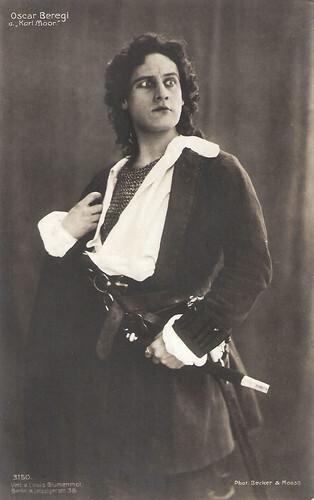
German postcard by Verlag Louis Blumenthal, Berlin, no. 3150. Photo: Becker & Maass. Oscar Beregi as Karl Moor in the play 'Die Räuber' (The Robbers) by Friedrich Schiller.
A menace to public health and safety
From 1926 on, Oscar Beregi, Sr. appeared in several Hollywood films, including the romantic comedies The Love Thief (John McDermott, 1926) and Butterflies in the Rain (Edward Sloman, 1926), with Laura La Plante .
He also had a supporting part in the silent drama The Flaming Forest (Reginald Barker, 1926) starring Antonio Moreno and Renée Adorée . The film is remarkable while a two-strip Technicolor sequence was shot for the climactic blaze sequence of the film.
When the sound film was introduced in Hollywood, Beregi’s possibilities as an actor were limited and he returned to Europe. He appeared there in several Hungarian films, but he is best remembered for his performance as Dr. Baum in Das Testament des Dr. Mabuse/The Testament of Dr. Mabuse (Fritz Lang, 1933).
This German crime film is a sound sequel to Lang's silent film Dr. Mabuse der Spieler/Dr. Mabuse the Gambler (Fritz Lang, 1922) and features Rudolf Klein-Rogge as Dr. Mabuse who is in an insane asylum where he is found frantically writing his crime plans. When Mabuse's criminal plans begin to be implemented, Inspector Lohmann (Otto Wernicke) tries to find the solution with clues from the gangster Thomas, the institutionalized Hofmeister and Professor Baum (Beregi) who becomes obsessed with Dr. Mabuse.
According to Wikipedia , the film was scheduled for release on 24 March 1933 at the UFA-Palast am Zoo, but Adolf Hitler came to power at the end of January 1933 and on 14 March, Hitler established the new Ministry of Public Enlightenment and Propaganda headed by Joseph Goebbels. By 30 March, the Ministry of Propaganda banned Das Testament des Dr. Mabuse as a menace to public health and safety. Goebbels stated that he would not accept the film as it "showed that an extremely dedicated group of people are perfectly capable of overthrowing any state with violence".
On the French release, The New York Times wrote that "It is the French version of Fritz Lang 's production, Le Testament du Dr. Mabuse (Dr. Mabuse's Will). It is a hallucinating and horrifying story, depicted with great power and the extraordinary beauty of photography that Lang has led his admirers to expect."
During the Third Reich, he lived in Budapest. Because of the anti-Semitic laws of 1939, he was only allowed to work as a stage actor in Omike, and he just barely escaped the Holocaust.
In the late 1940s, he emigrated to the US where he played a supporting role in the Oscar-winning film Call Me Madam (Walter Lang, 1953) starring Ethel Merman.
Oscar Beregi, Sr. died in 1965 in Hollywood, California. He was the father of actor Oscar Beregi, Jr., who also worked as a film and TV actor in Hollywood.
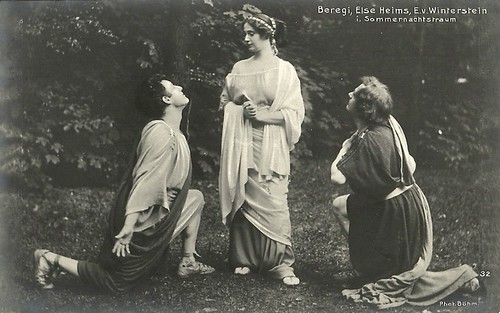
German postcard by Jos Paul Böhm, München, no. 32. Photo: Jos Paul Böhm, München. Eduard von Winterstein , Oscar Beregi, and Else Heims in the play 'Sommernachtstraum', Max Reinhardt 's staging of William Shakespeare 's 'Midsummer Night's Dream', first staged by Reinhardt in 1905.
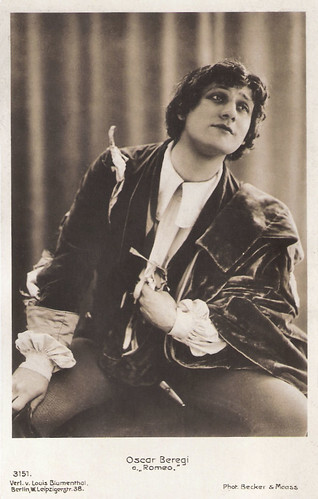
German postcard by Verlag Louis Blumenthal, Berlin, no. 3151. Photo: Becker & Maass. Oscar Beregi as Romeo in 'Romeo and Juliet' by William Shakespeare .
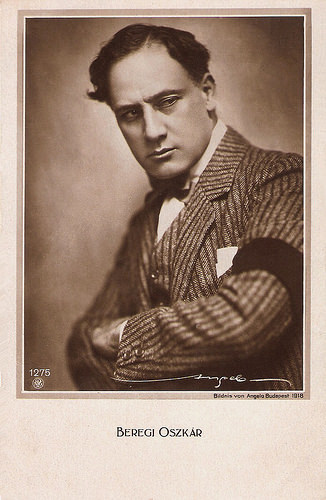
German postcard by NPG, no. 1275 Photo: Angelo, Budapest, 1918.
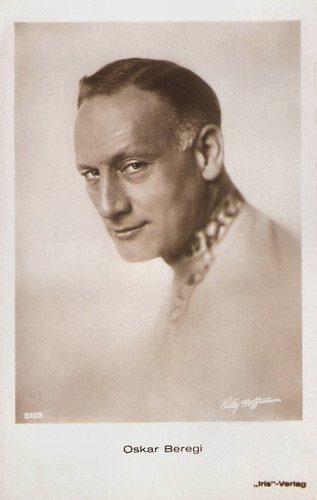
Austrian postcard by Iris Verlag, no. 5103. Photo: Kitty Hoffmann.
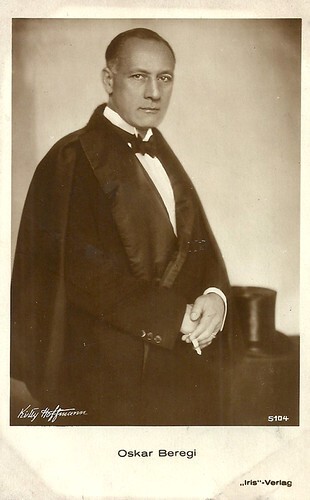
Austrian postcard by Iris Verlag, no. 5104. Photo: Kitty Hoffmann.
Sources: Daniel Rudolf (Ralph’s Cinema Trek), Wikipedia (English and German), and .

Hungarian postcard by L.D.F., Budapest, Series no. 1343.

Hungarian postcard by KI.V, Budapest. Photo: Mártoney, Budapest.

Hungarian postcard by S.S.Bpt., no. 235.

Austrian postcard by Arenberg Verlag, Wien (Vienna), no 576. Photo: Rudo Film, Wien. Oscar Beregi Sr. in Vier Nächte einder schönen Frau/Four nights of a beautiful woman (Josef W. Beyer, 1924).

Austrian postcard by Iris-Verlag, no. 5097. Photo: Universal-Film. Laura La Plante and Oscar Beregi in Butterflies in the Rain (Edward Sloman, 1926).
An attack on the aristocracy
Oscar Beregi, Sr. was born Beregi Oszkár or Oszkár Beregi (according to Wikipedia ) or Berger Oszkár (according to IMDb ) in Budapest, Austria-Hungary, in 1876.
In the 1910s, he was the leading actor in the National Theatre in Budapest, and would later perform in plays in Vienna and Berlin.
The sources differ about Beregi’s film debut in 1916. Was it with the lead role in the silent Hungarian production Mire megvénülünk/The time we get old (Ödön Uher ifj., 1916) or with the male lead in Hófehérke/Snowwhite (Márton Garas, 1916) with Ica von Lenkeffy ?
A year later he starred in the drama A Gólyakalifa/The Stork Caliph (Korda Sándor a.k.a. Alexander Korda, 1917), co-starring Gyula Bartos and Judit Bánky. It was the second film made by the legendary director-producer for his newly established Corvin Film company. Korda pulled off what was considered a literary coup by persuading the author Mihály Babits to allow him to film a version of his 1916 novel of the same name.
Two years later, Beregi appeared in another drama by Korda, Ave Caesar! (Alexander Korda, 1919) with Gábor Rajnay and María Corda . The film tells the story of a debauched Habsburg Prince, who sends out one of his aides-de-camp to bring him back a gipsy girl.
Ave Caesar! was considered an attack on the aristocracy. It was made by Korda for the state-owned film industry during the Hungarian Soviet Republic. Once the regime fell later that year Korda was arrested and eventually compelled to leave Hungary as part of the White Terror.
Beregi also worked with another Hungarian who would later become famous in Hollywood, Mihaly Kertész (later known as Michael Curtiz), on the drama Jön az öcsém/My Brother is Coming (Mihaly Kertész, 1919) with Lucy Doraine .
Like many other Hungarian filmmakers, Oscar Beregi, Sr. fled with his family from the Béla-Kun-Regime and moved to Austria. There he appeared as Cesare Borgia in Meriota, die Tänzerin/Neriota – the dancer (Julius Herska, 1922) opposite Maria Mindzenty as Meriota and Nora Gregor as Lucrezia Borgia.
Later he played Amenmeses opposite María Corda in the epic Die Sklavenkönigin/The Moon of Israel (Mihaly Kertész, 1924), produced by Sascha Kolowrat-Krakowsky and Arnold Pressburger. The script was written by Ladislaus Vajda, based on H. Rider Haggard's novel Moon of Israel, which in its turn was inspired by the Biblical story of the Exodus.
The shooting took place in Vienna with about 5,000 extras, in the studios of Sascha-Film, and outdoors on the Laaer Berg. Vienna was touted as 'the Hollywood of Europe,' and the film brought Kertész to the attention of the American studio head Jack Warner. Warner invited Kertész to Hollywood in 1926, where he rapidly became Michael Curtiz and made a career with Warner Studios.
Die Sklavenkönigin was entirely lost for many years, but in 2005 the film was restored and re-copied by the Filmarchiv Austria and presented in the Wiener Metro Kino.
Beregi then starred in the drama Der Fluch/The Curse (Robert Land, 1924). The film marked the screen debut of Lilian Harvey as a young Jewish woman in an Eastern European shtetl, who struggles to reconcile her aspirations with her duty to her family. As her lifestyle grows wilder, her mother is shocked by her immoral behaviour and commits suicide by drowning - repeating ‘the curse’ which has haunted the family for centuries.
He also starred in the Austrian-Polish coproduction Ssanin (Friedrich Feher, 1924) with Magda Sonja and the Jewish production Jiskor (Sidney M. Goldin, 1924) with Maurice Schwartz and Dagny Servaes .

German postcard by NPG. Photo: Mátrai, Budapest.

Hungarian postcard. NPG (Neue Photographische Gesellschaft). Photo: Matrai, Budapest.

Hungarian postcard. Photo: Mátrai, Budapest.

Hungarian postcard by Színházi Élet / City, no. 93. Photo; Angelo. 'Színházi Élet' (Theatre Life) was a popular Budapest theatre, literary and art weekly between 1912 and 1938. The founding editor-in-chief of the journal was Sándor Incze.

German postcard by Verlag Louis Blumenthal, Berlin, no. 3150. Photo: Becker & Maass. Oscar Beregi as Karl Moor in the play 'Die Räuber' (The Robbers) by Friedrich Schiller.
A menace to public health and safety
From 1926 on, Oscar Beregi, Sr. appeared in several Hollywood films, including the romantic comedies The Love Thief (John McDermott, 1926) and Butterflies in the Rain (Edward Sloman, 1926), with Laura La Plante .
He also had a supporting part in the silent drama The Flaming Forest (Reginald Barker, 1926) starring Antonio Moreno and Renée Adorée . The film is remarkable while a two-strip Technicolor sequence was shot for the climactic blaze sequence of the film.
When the sound film was introduced in Hollywood, Beregi’s possibilities as an actor were limited and he returned to Europe. He appeared there in several Hungarian films, but he is best remembered for his performance as Dr. Baum in Das Testament des Dr. Mabuse/The Testament of Dr. Mabuse (Fritz Lang, 1933).
This German crime film is a sound sequel to Lang's silent film Dr. Mabuse der Spieler/Dr. Mabuse the Gambler (Fritz Lang, 1922) and features Rudolf Klein-Rogge as Dr. Mabuse who is in an insane asylum where he is found frantically writing his crime plans. When Mabuse's criminal plans begin to be implemented, Inspector Lohmann (Otto Wernicke) tries to find the solution with clues from the gangster Thomas, the institutionalized Hofmeister and Professor Baum (Beregi) who becomes obsessed with Dr. Mabuse.
According to Wikipedia , the film was scheduled for release on 24 March 1933 at the UFA-Palast am Zoo, but Adolf Hitler came to power at the end of January 1933 and on 14 March, Hitler established the new Ministry of Public Enlightenment and Propaganda headed by Joseph Goebbels. By 30 March, the Ministry of Propaganda banned Das Testament des Dr. Mabuse as a menace to public health and safety. Goebbels stated that he would not accept the film as it "showed that an extremely dedicated group of people are perfectly capable of overthrowing any state with violence".
On the French release, The New York Times wrote that "It is the French version of Fritz Lang 's production, Le Testament du Dr. Mabuse (Dr. Mabuse's Will). It is a hallucinating and horrifying story, depicted with great power and the extraordinary beauty of photography that Lang has led his admirers to expect."
During the Third Reich, he lived in Budapest. Because of the anti-Semitic laws of 1939, he was only allowed to work as a stage actor in Omike, and he just barely escaped the Holocaust.
In the late 1940s, he emigrated to the US where he played a supporting role in the Oscar-winning film Call Me Madam (Walter Lang, 1953) starring Ethel Merman.
Oscar Beregi, Sr. died in 1965 in Hollywood, California. He was the father of actor Oscar Beregi, Jr., who also worked as a film and TV actor in Hollywood.

German postcard by Jos Paul Böhm, München, no. 32. Photo: Jos Paul Böhm, München. Eduard von Winterstein , Oscar Beregi, and Else Heims in the play 'Sommernachtstraum', Max Reinhardt 's staging of William Shakespeare 's 'Midsummer Night's Dream', first staged by Reinhardt in 1905.

German postcard by Verlag Louis Blumenthal, Berlin, no. 3151. Photo: Becker & Maass. Oscar Beregi as Romeo in 'Romeo and Juliet' by William Shakespeare .

German postcard by NPG, no. 1275 Photo: Angelo, Budapest, 1918.

Austrian postcard by Iris Verlag, no. 5103. Photo: Kitty Hoffmann.

Austrian postcard by Iris Verlag, no. 5104. Photo: Kitty Hoffmann.
Sources: Daniel Rudolf (Ralph’s Cinema Trek), Wikipedia (English and German), and .
Published on August 15, 2022 22:00
Paul van Yperen's Blog
- Paul van Yperen's profile
- 13 followers
Paul van Yperen isn't a Goodreads Author
(yet),
but they
do have a blog,
so here are some recent posts imported from
their feed.



